















For pros that demand intelligent charging solutions, tools they can trust, and one system for every challenge, proven STIHL quality makes the difference. Driven by over 98 years of German engineering excellence, AP system power and performance is designed by professionals for professionals.
Constant power at hand, day in day out. Get it done. With battery power by STIHL.
IPX 4
For working in wet or adverse weather conditions
CONSTANT POWER
Constant battery performance regardless of the charge level
POWER BOOST
NEW ELECTRONICS SYSTEM ENABLING HIGHER PERFORMANCE WHEN REQUIRED
ballet-standard showing of balance and precision
The Queensland Tree Climbing Championship was an eye-opener for me.
I climbed out of my swag at the Mount Tambourine showground to be greeted by a glorious sunny day, mild temperatures, and a rapidly increasing crowd.
The crowd, admittedly, was due to the venue hosting the community market that day as well, and as far as I could see that was a master stroke by the organisers. As the surprisingly large throng made its way around the stalls picking up snack treats, hot drinks and various craftworks, most, at some time or another, stopped to watch the tree climbing.
I’d missed the first day, but it worked in my favour, because after meeting some of the great people involved in running the competition, I was able to watch Barton Allen-Hall, the multitime Australian and world champ, do a demonstration climb.
It was a ballet-standard showing of balance and precision, and I felt
privileged to have been there to see it.
But one unexpected aspect of the day made a big impression on me.
As Allen-Hall ascended the tree to its very highest and most tenuous handholds, a singularly rapacious magpie went the dive-bomb attack, complete with clearly audible beak snapping and some spectacular helmet contact.
As I watched Allen-Hall maintain his composure and not acknowledge the avian assault, I heard a child’s voice behind me say, “Mummy, is he hurting the bird?” and another adult voice comment, “She must have a nest in this tree. Poor thing.”
I had a quiet smile to myself. As far as I could see, the ‘poor thing’ had every intention of nabbing an ear or an eye as a trophy. And not only was AllenHall tolerating a quite determined and undeserved bollocking from the avifauna, he clearly wasn’t creating a great impression with some of the local people either.

The organisers were aware of the magpie and knew its nest to be quite some distance away.
Allen-Hall drew his saw, tapped the bell and, with some elegant swooping of his own, made off in the direction of the next target. The magpie retired to await another victim, and I was left pondering what I’d seen.
Next time things aren’t going well I’ll think about Barton Allen-Hall and the magpie. I’ll try and draw inspiration from his professionalism in a tough situation, and at the very least, the memory will make me smile. Sometimes a smile is all it takes to turn things around.
A huge thanks to the QAA for inviting me to the competition, to all the great people I met while I was there, and especially to all the volunteers who gave their time to make the event possible. I hope to see you all again soon.
If I do, that’ll make me smile, too.
Tom Foster Editor

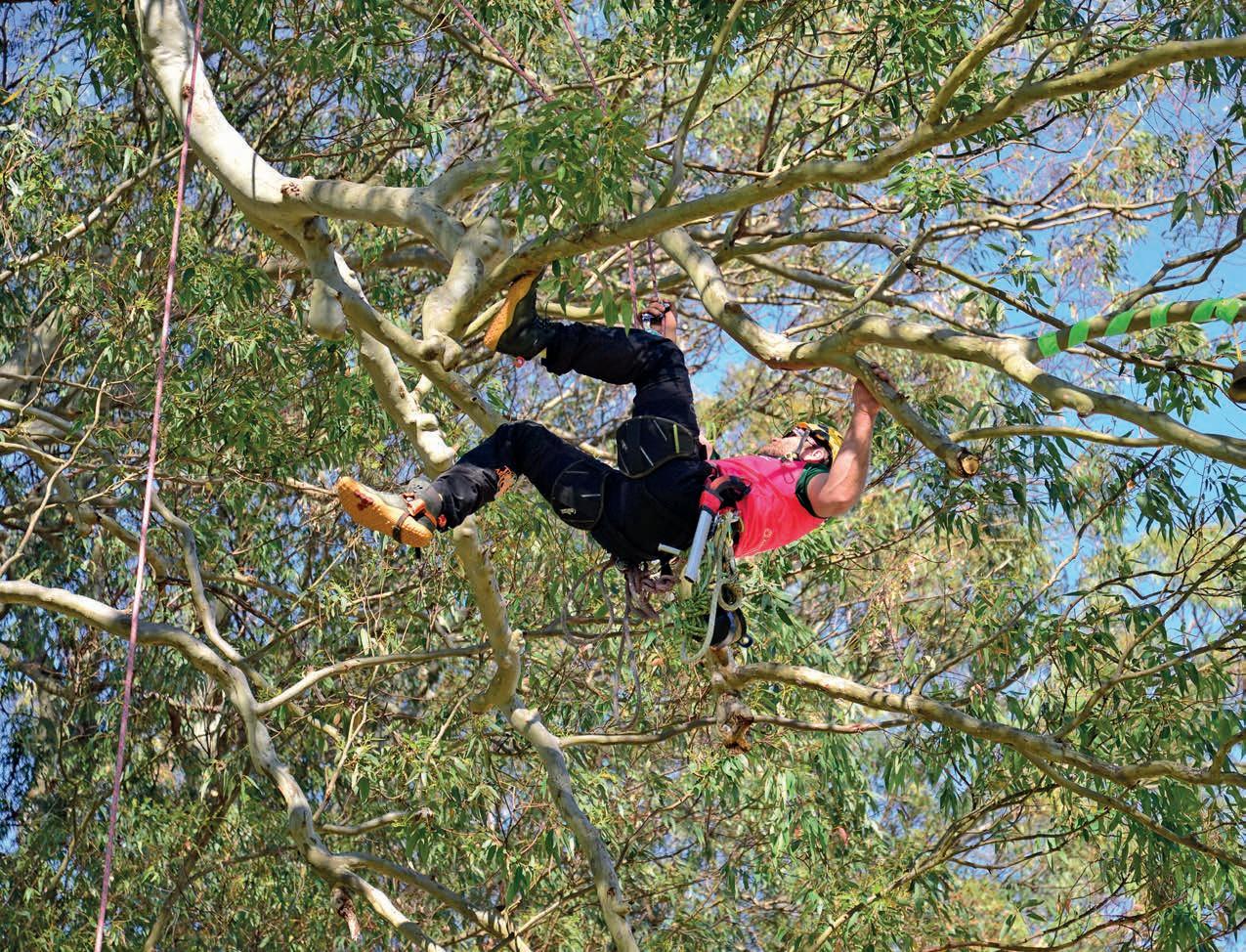



The Australian Arbor Age is published bimonthly by Prime Creative Media Pty Ltd.
CEO
John Murphy
COO
Christine Clancy
Sales Director
Bradley Buchanan
Editor
Tom Foster tom.foster@primecreative.com.au
National Advertising Manager
Arron Reed arron.reed@primecreative.com.au
Phone: 0466 923 194
Client Success Manager
Arianna Lucini
arianna.lucini@primecreative.com.au
Design
Jacqueline Buckmaster, Danielle Harris
Subscriptions
P. +61 3 9690 8766 subscriptions@primecreative.com.au
Website arborage.com.au

Copyright
The Australian Arbor Age magazine is owned by Prime Creative Media and published by John Murphy. All material in The Australian Arbor Age magazine is copyright and no part may be reproduced or copied in any form or by any means (graphic, electronic or mechanical, including information and retrieval systems) without written permission of the publisher. The editor welcomes contributions but reserves the right to accept or reject any material. While every effort has been made to ensure the accuracy of information, Prime Creative Media will not accept responsibility for errors or omissions, or for any consequences arising from reliance on information published. The opinions expressed in The Australian Arbor Age magazine are not necessarily the opinions of, or endorsed by, the publisher unless otherwise stated.
© Copyright Prime Creative Media, 2024
Articles
All articles submitted for publication become the property of the publisher. The editor reserves the right to adjust any article to conform with the magazine format.
Head Office
379 Docklands Dr, Docklands VIC 3008
P: +61 3 9690 8766
enquiries@primecreative.com.au www.primecreative.com.au
Sydney Office Suite 11.01, 201 Miller Street North Sydney, NSW. 2060. Australia
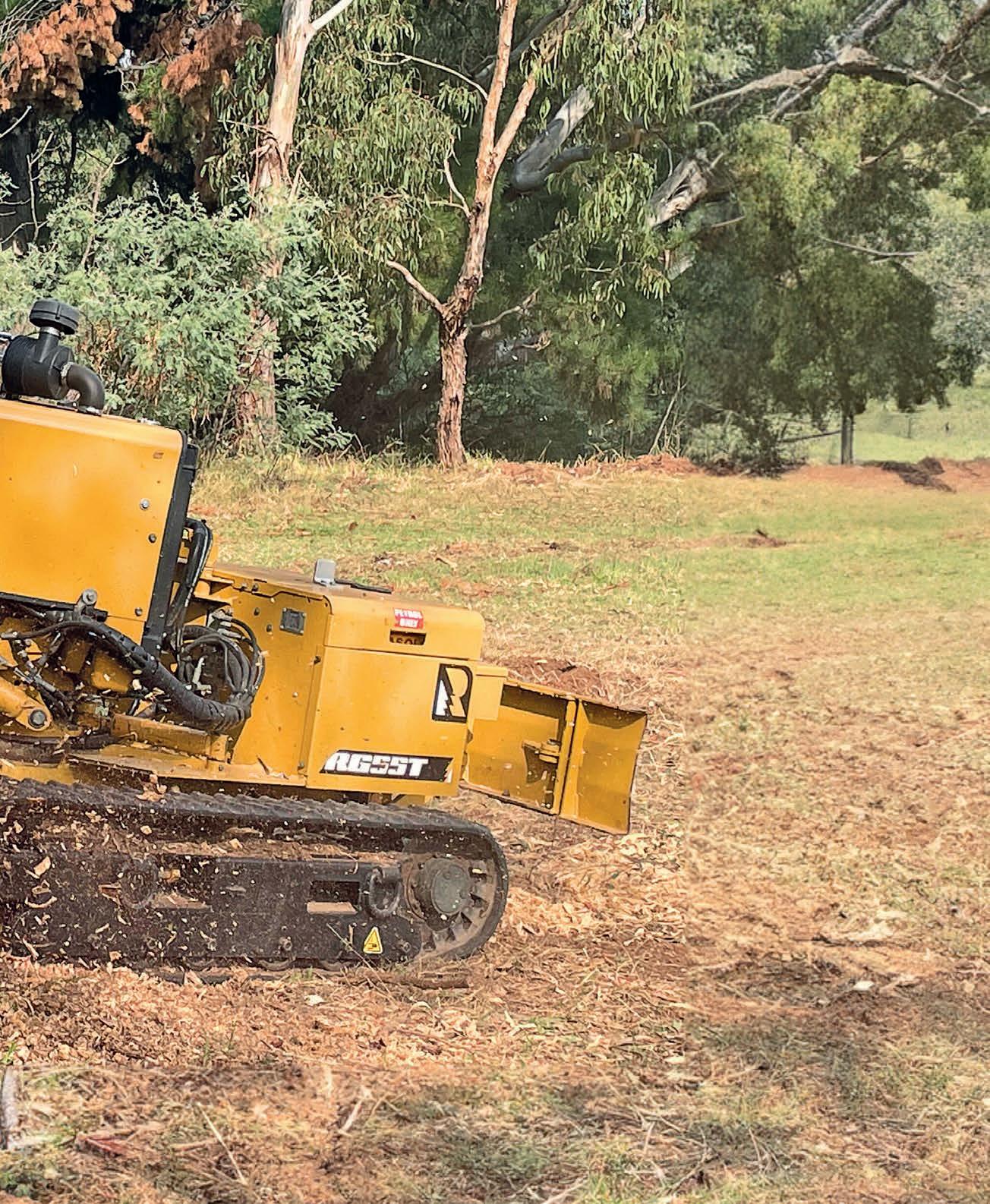
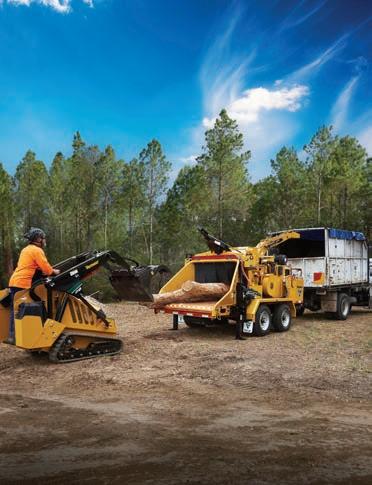

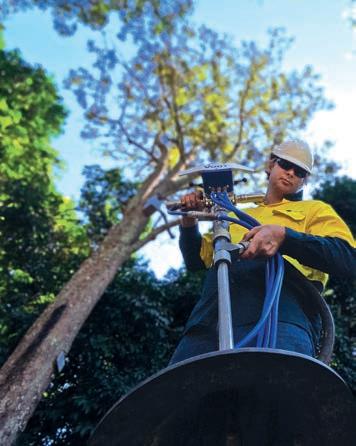
A potent proprietary technology from Germany has brought a whole range of new opportunities to tackle soil compaction.
08. SIGNIFICANT TREES
10. ON THE COVER
Soil compaction can have a negative impact on tree growth. The VOGT Geo Injector uses compressed air to alleviate the problem.
66. WOMEN IN ARBORICULTURE CLIMBING WORKSHOP
68. TECHNICAL FEATURE Ascension and the analogy of the tree to illustrate the human condition: Part 2.

Cassian Humphreys
Cassian is an exMerristwoodian (NCH-arb 1991, bridged into the UK Diploma ’92), Qualified to the AQF L5 (AUS Dip) in ’09, upgraded in currency in 2017. He commenced his career after graduating in Horticulture (’85), transitioning into Arb (’89). Experienced in all aspects of arboriculture, having worked in Germany, Australia, Britain, PNG and Vanuatu, Cassian has been writing for AAA since 1999, with over 40 articles to his name. His core specialisation involves conservation arboriculture, education and tree-health-care.

Jim McArdle
B.Ed. Sc (Sydney), Dip. Arb. (Ryde), VTRA@QTRA qualifications. Director at McArdle Arboricultural Consultancy and TCAA President, Jim’s career spans across almost 40 years and focuses on consulting and reporting in tree risk protection and management plans, and tree impact assessments.

Dave Crispin
A professional consulting arborist at Treeswest Australia, certified to AQF level 5 (Diploma), international coach, speaker and presenter.
At just under 84 metres tall and estimated to be around 2200 years old –give or take a century – this Sequoiadendron giganteum is a major tourist attraction in the United States.
While not the largest or tallest tree in recorded history, giant sequoia ‘General Sherman’ is the world’s the largest living tree by volume.
With neighbouring giant sequoias ‘General Grant’, ‘Lincoln’, and ‘Stagg’, General Sherman stands stately in the Giant Forest in Sequoia National Park, California. Sequoia roots are shallow but spread wide, and entangle with the roots of other sequoias to form a network that helps all the trees maintain balance and stability.
One quirky fact relating to this particular sequoia is, in 2021, the trunk was wrapped in aluminium foil to prevent an approaching fire from reigniting vulnerable fire scars.
At 84m tall and with a trunk circumference of 31m at ground level, giant sequoia ‘General Sherman’ is the world’s the largest living tree by volume. Image: Marek Poplawski/stock.adobe.com
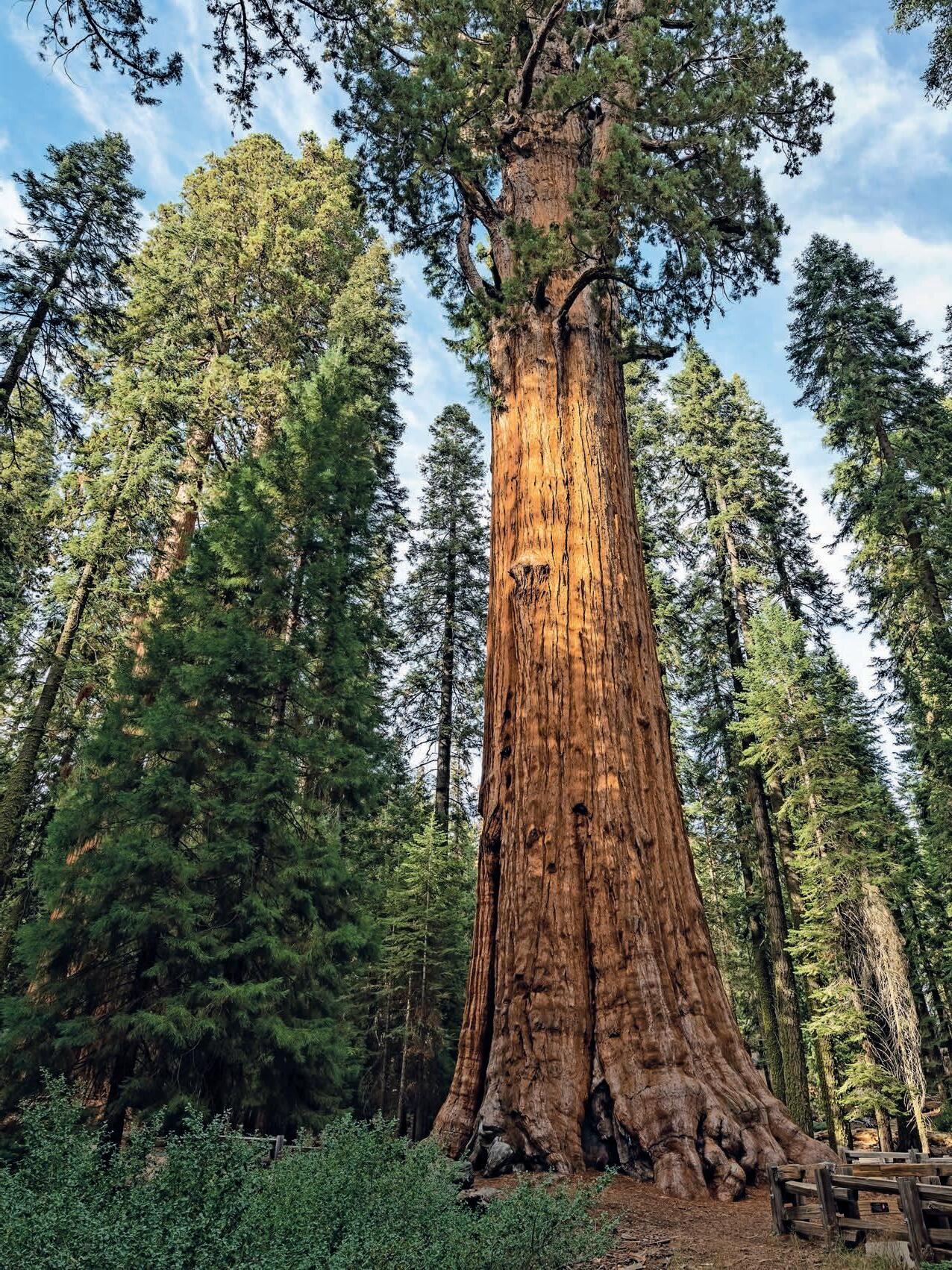


Photo credit: Mulchtech.com.au and Vinetech.com.au


Soil compaction is a widespread problem that affects the health of various ecosystems and can have negative impacts on plant growth and overall soil health. Previously the best tool to combat this issue was the AirSpade. But a potent new proprietary technology from Germany has brought a whole range of new opportunities to tackle the problem.
Trees and shrubs get their sustenance from the area surrounding their roots, known as the rhizosphere. Their roots absorb water and nutrients through the root–soil interface structures, and even their ‘breathing’ is done through pores in the soil. However, this natural cycle can be disrupted by compacted soil, leading to a decline in vitality and the formation of deadwood. The VOGT Geo Injector can remedy this by using compressed air to loosen soil through a punctual aeration process. The injection tube applies adjustable pressure ranging from five to eight bar (72psi-116psi) and creates free spaces for soil additives, allowing

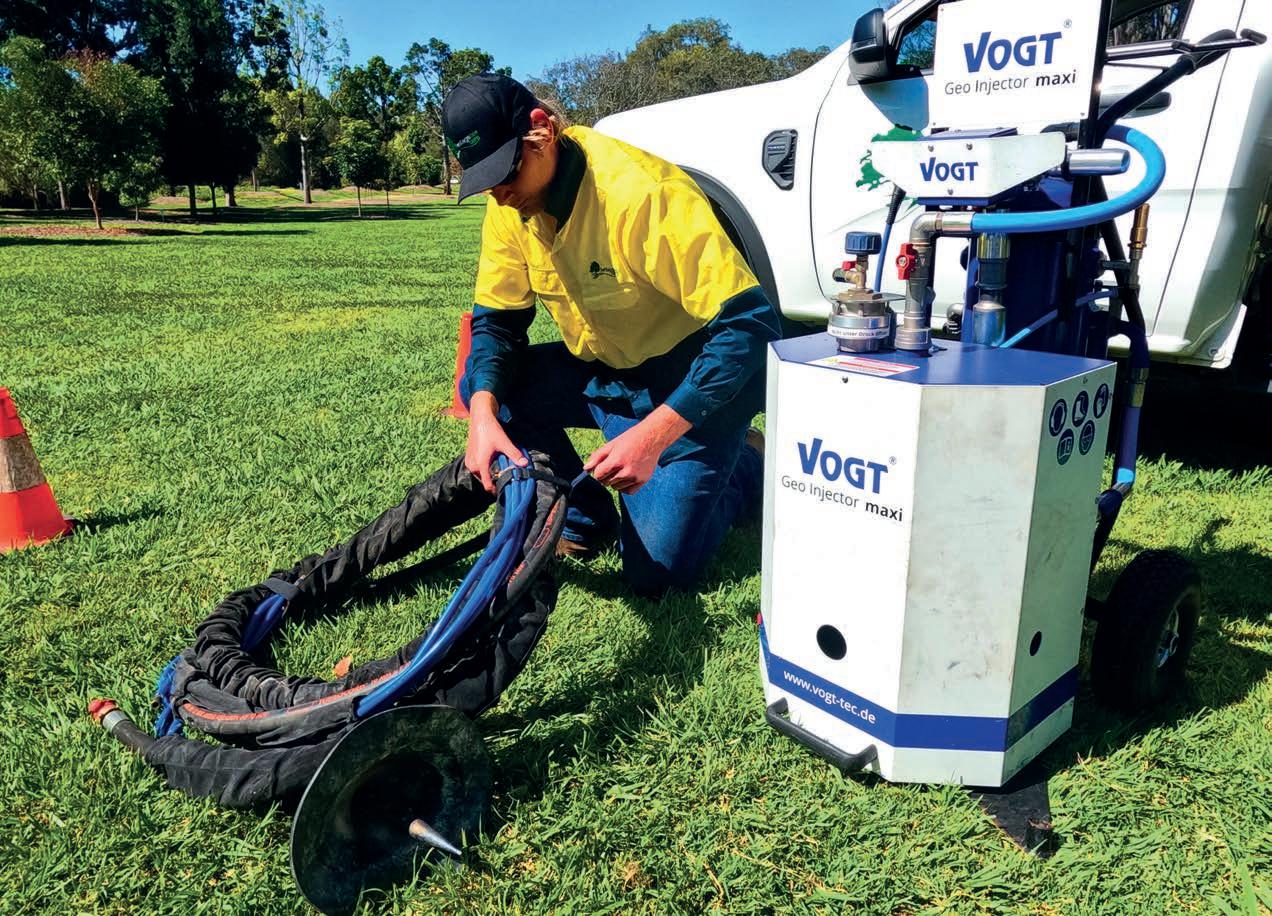

infusing it with essential elements like granulated fertilisers, adsorbents, soil conditioners and air, offering
soil structure and promotes nutrient cycling at a faster rate. Best of all?



The VOGT Geo Injector brings all of this to bear in a single pass. The operator can simply inject and go.
When soil becomes compacted, a tree’s natural cycle is disrupted, often leading to a decline in vitality, the formation of deadwood (and dormant soil microorganisms) and the start of the spiral of decline and loss of resilience.
The VOGT Geo Injector can help remedy these issues by using compressed air to loosen compacted soil through a targeted aeration process, allowing the operator to aerate the soil and inject a bespoke nutrient blend in a single application.
The device is mounted on a Plant Health Care (PHC) utility vehicle, which includes a 400-litre water tank, a fertiliser tank, and a Dosatron for adjusting mixes.
The VOGT aerator reaches deepseated, compacted soil layers, releasing compressed air to open sealed capillaries, while aeration holes are filled with a supporting dry-soil conditioner mix, removing stagnant moisture and allowing oxygen to reach the roots.
Valve-controlled trigger technology releases air suddenly, breaking up soil efficiently without physical exertion.
The technology used by the VOGT Geo Injector is recommended by Heritage Tree Care, the Australian company which has used the VOGT Geo Injector for five years and has begun distribution of the German innovation around Australia.
Heritage Tree Care’s plant-health research division is continuously working to improve arboriculture solutions, collaborating with credible agencies like Griffith University to conduct research trials assessing the beneficial effects of soil injections on trees in a variety of landscapes. Helmed by a microbiologist, an agronomist and arborists, the Heritage plant-health division believes the VOGT Geo Injector could change the game.
The VOGT Geo Injector has proven its effectiveness through real-world applications, having been extensively used by Heritage Tree Care in treating over 60,000 trees across major council projects throughout Queensland. Its success is evident in large-scale projects for councils such as the City of Gold Coast, Brisbane City Council,

Valve-controlled trigger technology releases air suddenly, breaking up soil efficiently without physical exertion.
and Toowoomba Regional Council. These case studies demonstrate the technology’s ability to address soil compaction and improve tree health on a significant scale, making it a reliable solution for urban and regional landscapes alike.
To experience the system’s capabilities or learn more about the plant-health applications, Heritage Tree Care is currently running workshops and demonstrations.
Learn more at heritagetreecare.com.au, or give the staff a call on 1800 353 053.
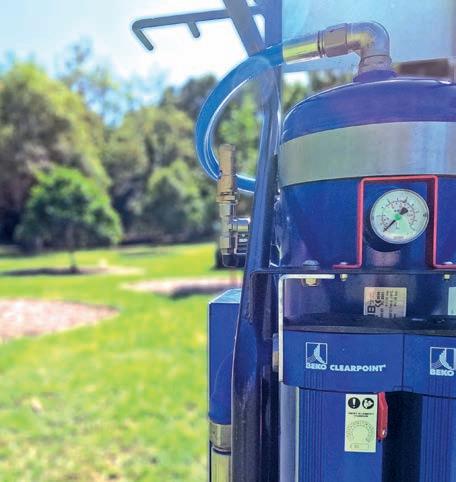
The device is mounted on a Plant Health Care (PHC) utility vehicle, which includes a 400-litre water tank, a fertiliser tank, and a Dosatron for adjusting mixes.
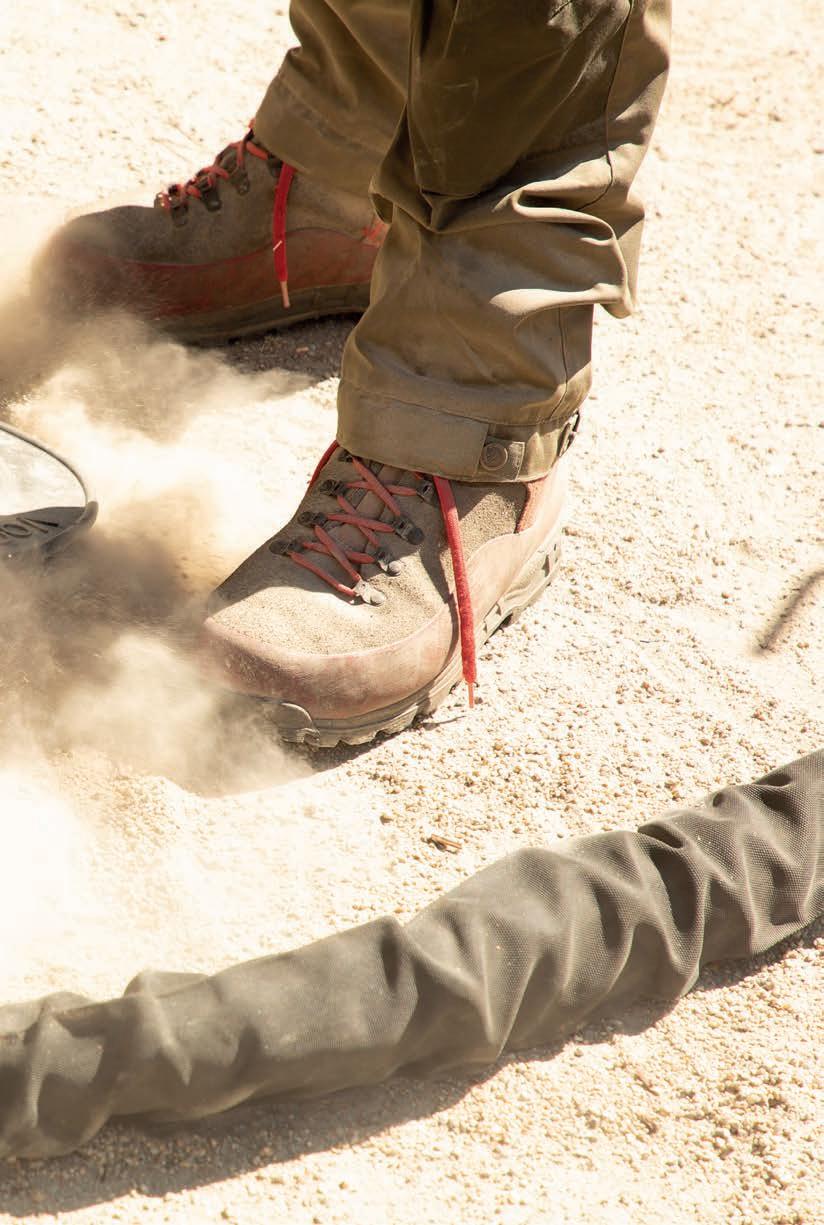

Established in 1994 and based in Queensland, Heritage Tree Care provides a comprehensive and professional arboricultural service that has its foundation in sound arboricultural practices and techniques.
The company strives to be the provider of choice for the arboriculture industry through reliability, delivery of high-quality outcomes and safe work practices.
Focused on sustainability and preservation, Heritage Tree Care works hard to maintain the highest standards of arboriculture and offer the utmost in tree care and land management, with Level 3 to Level 5 arborists fully trained to ensure quality workmanship.
Heritage Tree Care is committed to caring for the environment and dedicated to:
• Setting environmental strategies for areas that could have any kind of environmental impact within the operation of the company
• Minimising the emission of polluted runoff, dust and noise from site offices, facilities and equipment by use of maintenance and protective measures
• Setting specific documented procedures for the company’s objectives and targets for environmental impact, and
• Supporting ecologically sustainable development on all projects.
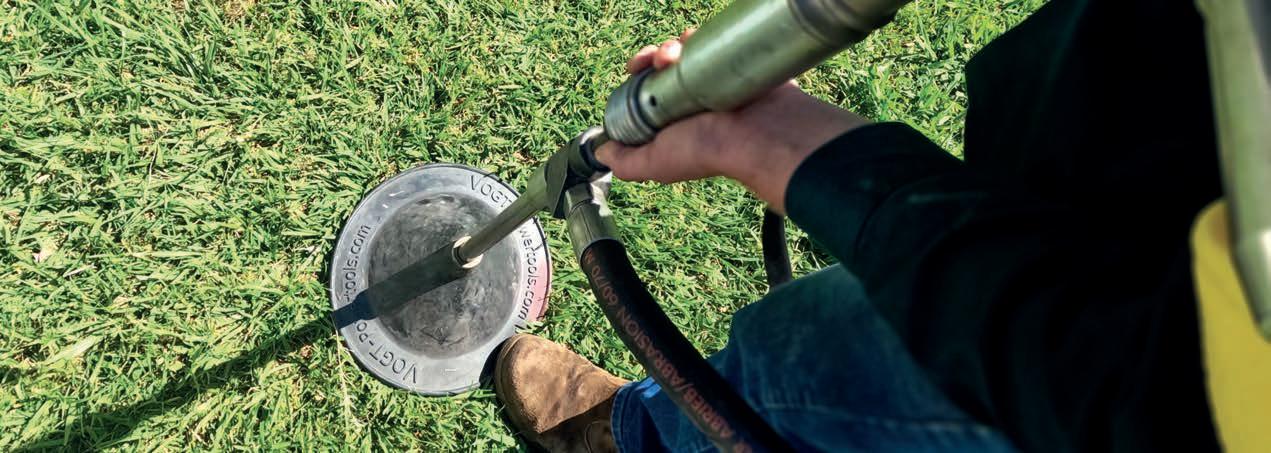
The VOGT Geo Injector allows for immediate enrichment of the soil to depth, fast tracking the transition of nutrients and making it ideal for urban tree management, landscaping and agriculture.
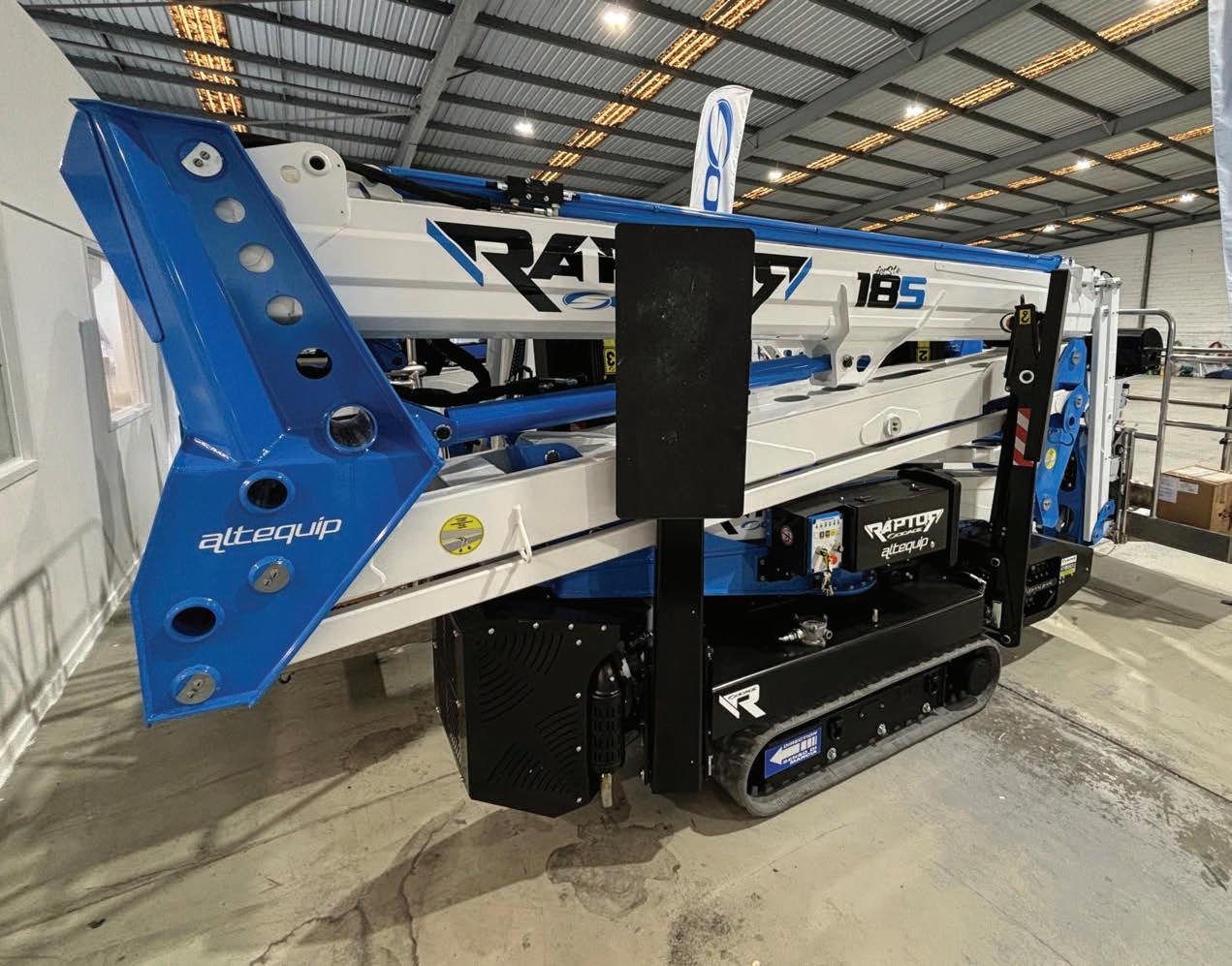
Socage Raptor spiders and truck-mounted EWPs are now available in Australia through trusted distributor, Altequip.
As highly experienced travel-tower and spider operators, Altequip knows firsthand the importance of quality and reliability when working at heights and is happy to bring Socage’s cutting-edge products to the eager Australian market.
Included in the Italian company’s innovative range are Raptor spider machines, delivering exceptional lifting capacity and versatility in a range of models, right up to the impressive truckmounted TJJ100 100m.
With advanced safety features and intelligent control systems, Socage sets the global standard for performance and precision.
The Raptors are spider boom lifts in a range of sizes, two of which especially suit the Australian arb market: the 18 S and the 21 S.
With a maximum working height of 18m and 20.80m respectively, the
18 S offers a maximum lateral outreach of 8.20m, while the 21 S reaches out to 10.3m.
The basket payload of both is 230kg (two operators + material) in the whole working area without any limitation, and both lifts are fitted with automatic stabilisation and automatic closing for easy and safe use.
Sustainability of the platforms was incorporated in the design and manufacture, and both offer
• Zero emissions
• Bi-energy as standard (an additional diesel engine incorporates a 230V electric motor that allows working without emissions, essential in some enclosed spaces)
• Three different travel speeds, and
• Exceptional manoeuvrability, thanks to 380º rotation and the hydraulic jib with double articulated arm.
Both lifts are lightweight and equipped with extendable, white, nonmarking tracks for better stability when
The 18 S and 21 S are among the best performing and most compact tracked lifting platforms of their size available. Images: Altequip
moving the machine, and the pair are among the best-performing and most compact tracked lifting platforms of their sizes available.
Altequip will soon have available the Raptor 35 S Socage tracked spider in addition to the 18 S and 21 S, and currently has in stock both the 37DJ Speed and 32DJ Speed truck-mounted platforms.
And as far as after-sales service and maintenance goes, Altequip utilises the experienced Access Service Australia team across Australia and New Zealand to meet its service and maintenance requirements, and has direct factory support from Socage in Italy.
Customers can rely on the strength of the three companies to support Socage machine requirements throughout Australia and New Zealand.
See the Socage range at altequip.au.
Altequip utilises the experienced Access Service Australia team across Australia and New Zealand, and has direct factory support from Socage in Italy.
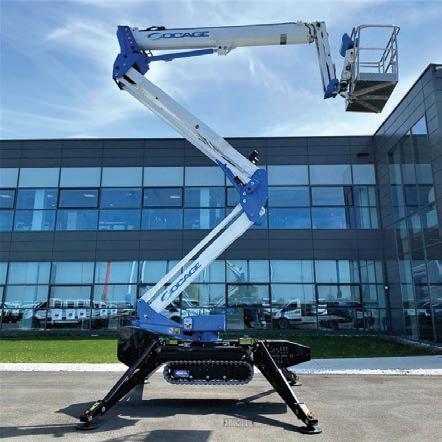
Altequip was formed with the primary focus of bringing the Socage product to the Australian market. Committed to bringing a high-level of sales experience, with industry knowledge and understanding of a wide variety of users’ requirements, Altequip ensures the client is always the centre of operations.
Customers of Altequip can be confident when choosing the Socage product thanks to full-factory warranties and service support from Access Service Australia. Altequip also carries a high level of consumables, spare parts and sensors for all machines in the country, but also utilises express global drop shipping from the Socage Factory to ensure the absolute minimal time from order to delivery.
Altequip is excited to be bringing the Socage products to Australia and welcomes enquiries.
Socage Raptor 18 S and 21 S features
Hydraulically expandable undercarriage
White non-marking tracks
Electric hour counter
Manual hand pump
230V electric socket in the basket
Multifunction remote control
Auxiliary electric pump 230V-50Hz
Flanged holding valves
Diesel engine
Automatic closing
Automatic stabilisation
Outrigger plates

The 21 S has a maximum working height of 20.80m, and both lifts offer exceptional manoeuvrability, thanks to 380º rotation and the hydraulic jib with double articulated arm.

Working at height is a daily reality for Australian arborists. This article explores some key methods for improving safety when working at height, with a focus on the benefits of using Mobile Elevating Work Platforms (MEWPs) equipped with advanced safety features like Niftylift’s ClipOn and SiOPS systems.
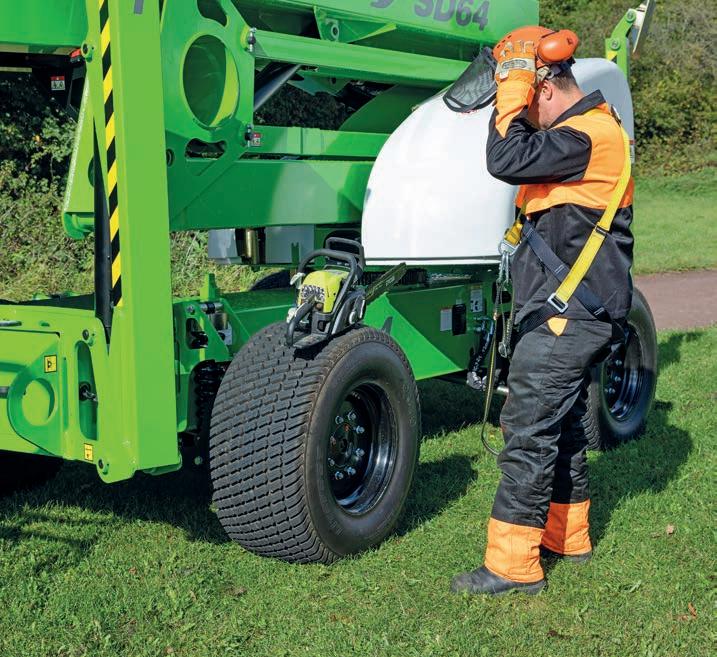
Ensuring operator safety is a critical priority when working at heights. Images: Niftylift
Whether pruning, performing maintenance or clearing hazards, arborists face inherent risks working at heights. Ensuring operator safety is a critical priority, and modern equipment, safety protocols, and innovations have made significant advancements in mitigating these risks. Here are a few important factors affecting operator safety.
The foundation of any safe work environment is operator training. In the arbor industry, training isn’t just about knowing how to cut branches safely, but also about how to use tools and equipment effectively. Arborists must complete working-at-height certifications to ensure they are aware of the risks and are trained in both rescue and emergency procedures. Additionally, they need specific training on the safe operation of MEWPs. Understanding how to manoeuvre the machines, position them correctly, and assess the work environment is vital for reducing risk.
While PPE is the last line of defence, it’s a crucial part of any comprehensive safety approach.

PPE plays a significant role in protecting arborists from injury. Arborists should always wear helmets with visors or face shields, hearing protection, gloves, chainsaw protective clothing, and safety boots with reinforced toe caps. High-visibility clothing is also essential, especially in environments where other vehicles or equipment are in operation. While PPE is the last line of defence, it is a crucial part of any comprehensive safety approach.
In traditional tree climbing, arborists use harnesses, ropes, and pulleys to access high branches. However, as the industry increasingly adopts modern equipment, harness systems are also used in conjunction with MEWPs. This provides an extra layer of fall protection. Niftylift’s ClipOn Harness Attachment Detection System takes this one step further by ensuring operators are securely attached before operating the MEWP. ClipOn detects whether the operator is correctly harnessed and restricts the platform’s movement if a proper connection isn’t detected. This feature is essential in ensuring compliance with safety standards and minimising the risk of operator error.


MEWPs have transformed the way arborists work at height. Not only do they provide stable platforms, but they also allow operators to work in difficultto-reach areas with enhanced safety and efficiency. MEWPs reduce the need for climbing trees or using ladders, both of which present greater risks of falls and injuries. For arborists, the ability to position themselves safely and precisely while operating heavy-duty cutting tools is invaluable.
Niftylift’s range of MEWPs is particularly suited for the arbor industry due to its lightweight design and advanced safety features. The SD170 and SD210 self-drive platforms are ideal for tree-care professionals. These versatile machines offer excellent manoeuvrability, even on rough terrain, while providing the reach and stability needed for working at height. Their compact design allows easy access to confined spaces, while outriggers ensure a stable working platform, even on uneven ground. This makes the SD170 and SD210 perfect for the diverse challenges encountered in the arbor industry, where both height and terrain can vary greatly.
One of the key risks when using MEWPs is operator entrapment, where the operator could become trapped between the machine and another structure, leading to serious injury.

Niftylift’s SiOPS (Sustained Involuntary Operation Prevention System) is designed to prevent injury if an operator should become trapped between the machine and another structure.
Niftylift’s SiOPS (Sustained Involuntary Operation Prevention System) is designed to prevent this. SiOPS instantly stops all machine functions if it detects the operator has been pushed against the controls. This feature offers an essential layer of protection, particularly when working in dense environments, such as near tree trunks, branches, or other obstacles commonly encountered in arbor work.
Safe working at height in the Australian arbor industry relies on a combination of training, protective equipment, modern technology, and comprehensive planning. MEWPs, with innovations like Niftylift’s ClipOn and SiOPS systems, provide arborists with the tools they need to work more safely and efficiently. By adopting these advanced solutions and continuing to prioritise safety in every aspect of their work, arborists can minimise risk and focus on maintaining Australia’s urban forests and natural environments.
For more on Niftylift’s MEWPs, visit niftylift.com.au.
The new machine was presented at the European trade shows during September.
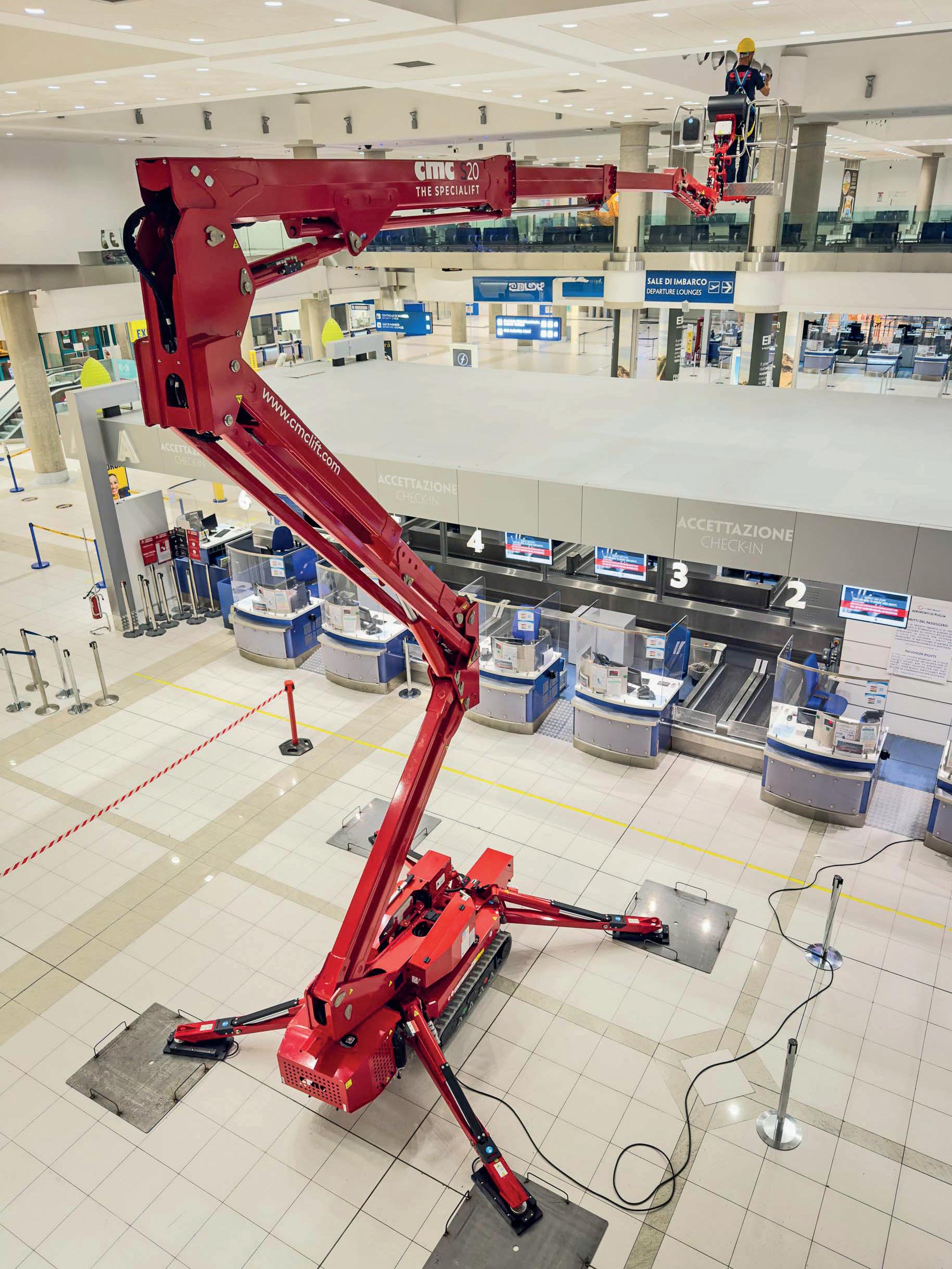
The platform is equipped with advanced automatic-stabilisation technology that ensures safety and precision. The S20 is shown here working at the Bari-Karol Wojtyla International Airport. Images: CMC
A global leader in the design and production of tracked spider aerial platforms, CMC was founded with the goal of offering innovative and highly specialised solutions for aerial lifting. CMC has quickly established itself as a reference in the industry, thanks to its ability to combine cutting-edge technology, safety, and reliability.
See the CMC range at cmclift.com/en/.
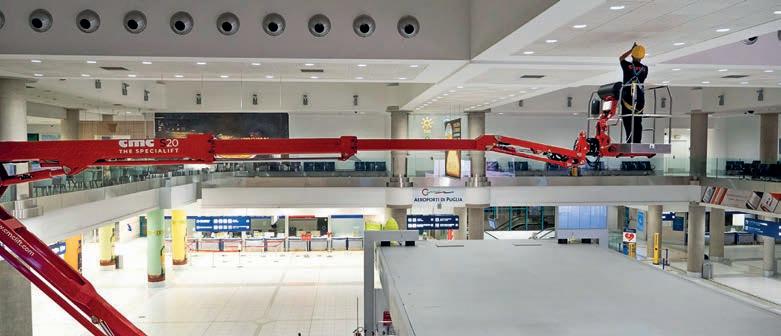
SA maximum outreach of 10.4 metres at full load in the basket makes the S20 ideal for a wide range of applications, like this task at the
eptember was packed with events for work-at-height professionals across Europe, and CMC was proud to launch its latest innovation, the CMC S20 platform, during the major trade shows:
• Platformers’ Days - Karlsruhe Trade Fair Centre (Germany)
• Vertikal Days – Newark Showground (UK)
• GaLaBau – Nuremberg (Germany), and
• APF 2024 – Ragley Estate –Warwickshire (UK).
The events offered the perfect opportunity to showcase a machine that combines superior performance, versatility, and advanced safety, occupying a unique spot in the 20-metre platform segment.
The CMC S20 stands out for its compact design without compromising on strength and functionality.
With a total weight of 2980kg and small dimensions, it is ideal for working in complex work environments, such as congested urban areas and construction sites with limited space. Also, because the S20 can run electrically, it can operate safely and quietly in indoor and enclosed sites. The platform is equipped with a 90°+90° rotating two-man basket with a quick-release system, enabling fast installation and removal, ensuring safety and convenience for two operators and their tools, with a maximum load capacity of 230kg.
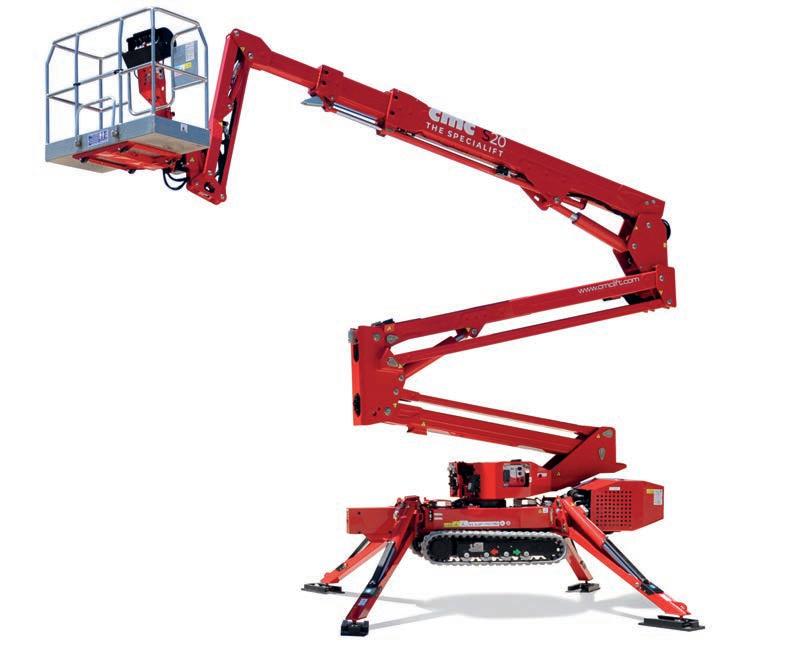
Despite its compactness, the CMC S20 offers exceptional performance thanks to its geometric design, and with a maximum working height of 19.9 metres and a maximum outreach of 10.4 metres at full load in the basket, it is ideal for a wide range of applications, including arbor and tree work, building, electrical installations, pruning, and it can comfortably and safely perform all these functions both indoors and outdoors. The platform is equipped with advanced automaticstabilisation technology that ensures safety and precision even on uneven terrain, allowing the outreach to be fully utilised regardless of the basket load.
Alessandro Mastrogiacomo, CEO of CMC, stated: “A new era begins for tracked spider aerial platforms, since with the launch of the S20, CMC marks a significant evolution in the field of geometric double-pantograph platforms. The combination of advanced technology, compact design, and attention to safety makes the S20 an ideal choice for professionals looking for a versatile, reliable, and durable solution. Whether it’s maintenance, construction, or specialised interventions, the S20 is ready to meet the most demanding challenges, offering high-level performance without compromise.”
CMC S20 features
• Honda iGX390 petrol engine
• Hydraulically width-adjustable black rubber tracks
• Two-man basket equipped with quick-release system and wheels
• 200 Bar air/water hose in the basket
• 230V/120V/110V and 12V electrical socket in the basket
• Protective covers for outrigger cylinders
• Display with error-code detection
• Proportional hydraulic controls
• Proportional travel mode by radio remote control
• Lifting hooks
• Fixing points for transport
• Triple travel speed
• Automatic outrigger levelling
• Standard painting (RAL 3000)
• 24-months warranty
• Max working height: 19.9m
• Max outreach: 10.4m
• Height at floor level: 17.9m
• Max weight in the basket: 230kg
• Basket dimensions: 1.4m x 0.7m x 1.1m
• Basket rotation: +/-90°
• Turret rotation: +/- 180°
• Total weight: 2980kg
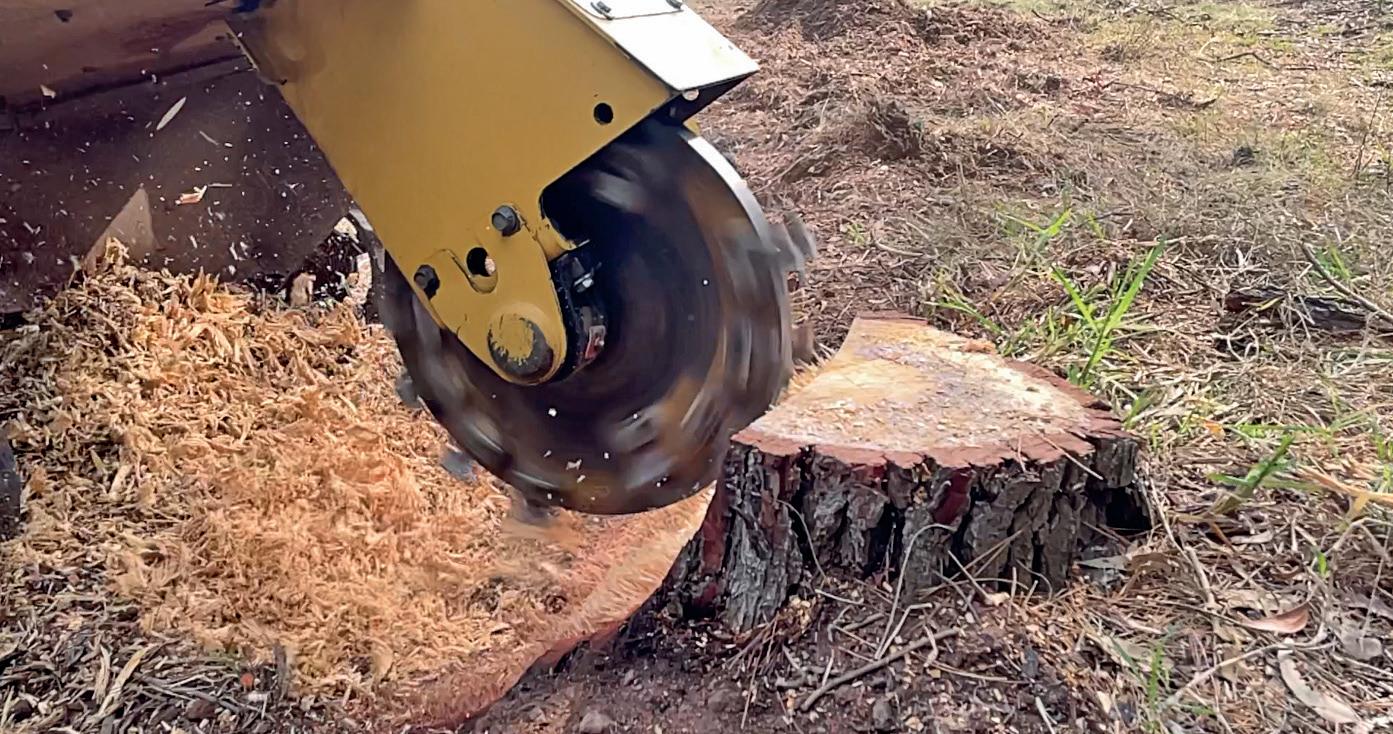
Rayco stump grinders are engineered to deliver superior performance, reliability, and ease of use. Images: Monitor Group
In the demanding world of arboriculture, efficiency and reliability are non-negotiable. That’s where Rayco’s range of stump grinders steps in to set a new standard, delivering innovative solutions that cater to the diverse needs of Australian arborists.
Rayco stump grinders embody a commitment to innovation and excellence. Each model is engineered to deliver superior performance, reliability, and ease of use, and the integration of advanced technology with practical features ensures arborists can work smarter, not harder.
Monitor is passionate about importing machines to provide the world’s best equipment and local backup service and parts support. In turn, this is supporting arborists in their quest to increase efficiency and excellence in their businesses.
Whether you’re dealing with tight urban sites or extensive land clearing, Rayco’s stump grinders provide the power and precision needed to get the job done right.
Here’s a quick rundown on three great Rayco models available for purchase or hire through Monitor.
To see more of the Monitor range of machinery and equipment, log on to monitor.net.au.

RG55T-R petrol stump grinder
Fuel tank: 32.0 litres
Cutter wheel: 51cm x 4.0cm
Cutting depth: 36.0cm
Cutting height: 62.0cm
Cutting width: 152.0cm
Power: 53.4hp Kubota engine
Weight: 1524kg
Width: 89cm
RG37T Trac petrol stump grinder
Fuel tank: 37.8 litres
Cutter wheel: 43.8cm x 2.5cm
Cutting depth: 44.5cm
Cutting height: 62.2cm
Power: 37hp Vanguard
Weight: 839kg
Width: 89cm
Rayco RG37T: compact powerhouse
For those navigating tight spaces and urban environments, the Rayco RG37T is a game-changer.
This compact yet powerful stump grinder is designed for manoeuvrability without sacrificing performance.
Equipped with a robust 37-horsepower engine, it combines agility with strength, allowing arborists to tackle stumps in confined areas with ease. The RG37T’s advanced hydraulic system ensures precise control, making it an indispensable tool for projects where precision is key.
Rayco RG55T-R: versatile workhorse
When versatility and durability are required, the Rayco RG55T-R stands out. Featuring a 55-horsepower engine and a user-friendly design, this model is ideal for both small and mediumsized stumps. Its innovative cutting technology offers a blend of speed and efficiency, significantly reducing grinding time. The RG55T-R’s reinforced frame and high-torque performance make it a reliable choice for demanding tasks, ensuring arborists can handle a variety of stump sizes and soil conditions with confidence.

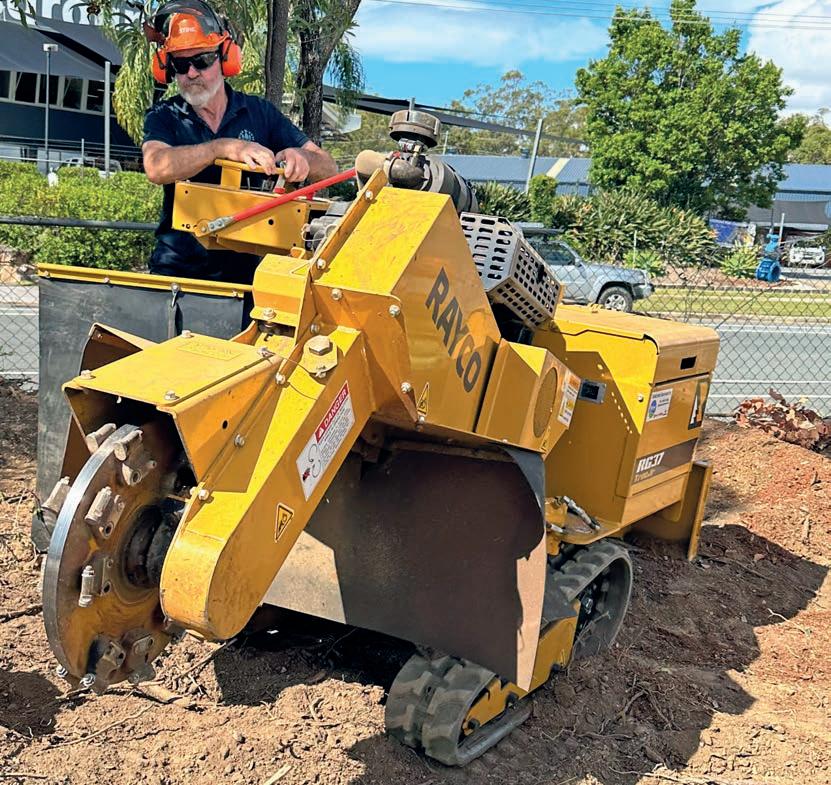
Rayco RG80-R: the heavyweight champion
For the most challenging jobs, the Rayco RG80-R is the ultimate solution. With a formidable 80-horsepower engine, this stump grinder is built to handle large and stubborn stumps with remarkable ease. Its heavy-duty construction and advanced cutting system provide unparalleled power and durability, making it the go-to choice for professional arborists dealing with large-scale stump removal. The RG80-R’s efficiency is matched by its operator comfort, thanks to its ergonomic design and intuitive controls.
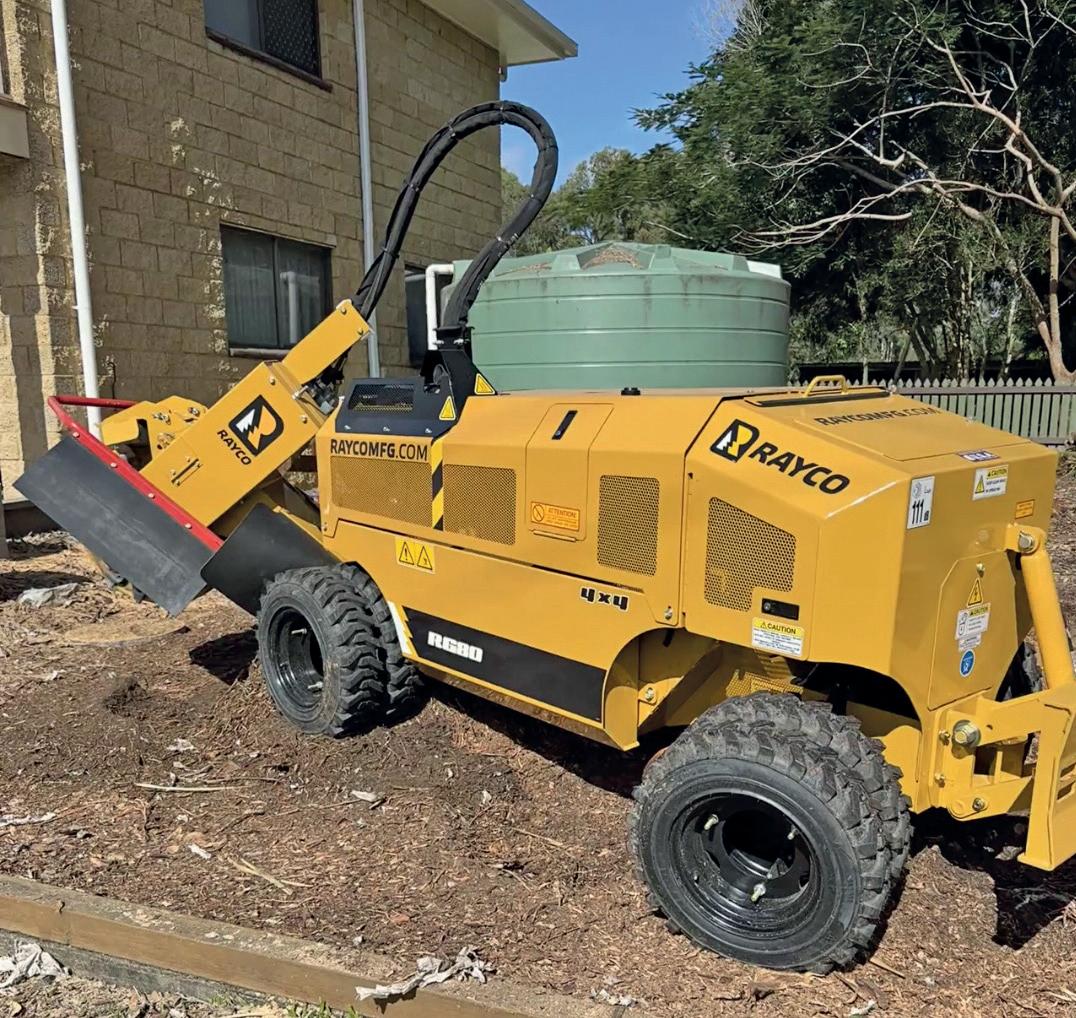
RG80-R petrol stump grinder
Fuel tank: 39.0 litres
Cutter wheel: 58.4cm x 3.8cm
Cutting depth: 53.3cm
Cutting height: 50.8cm
Cutting width: 165.1cm
Power: 85hp Ford engine
Weight: 1465kg
Width: 91.5cm
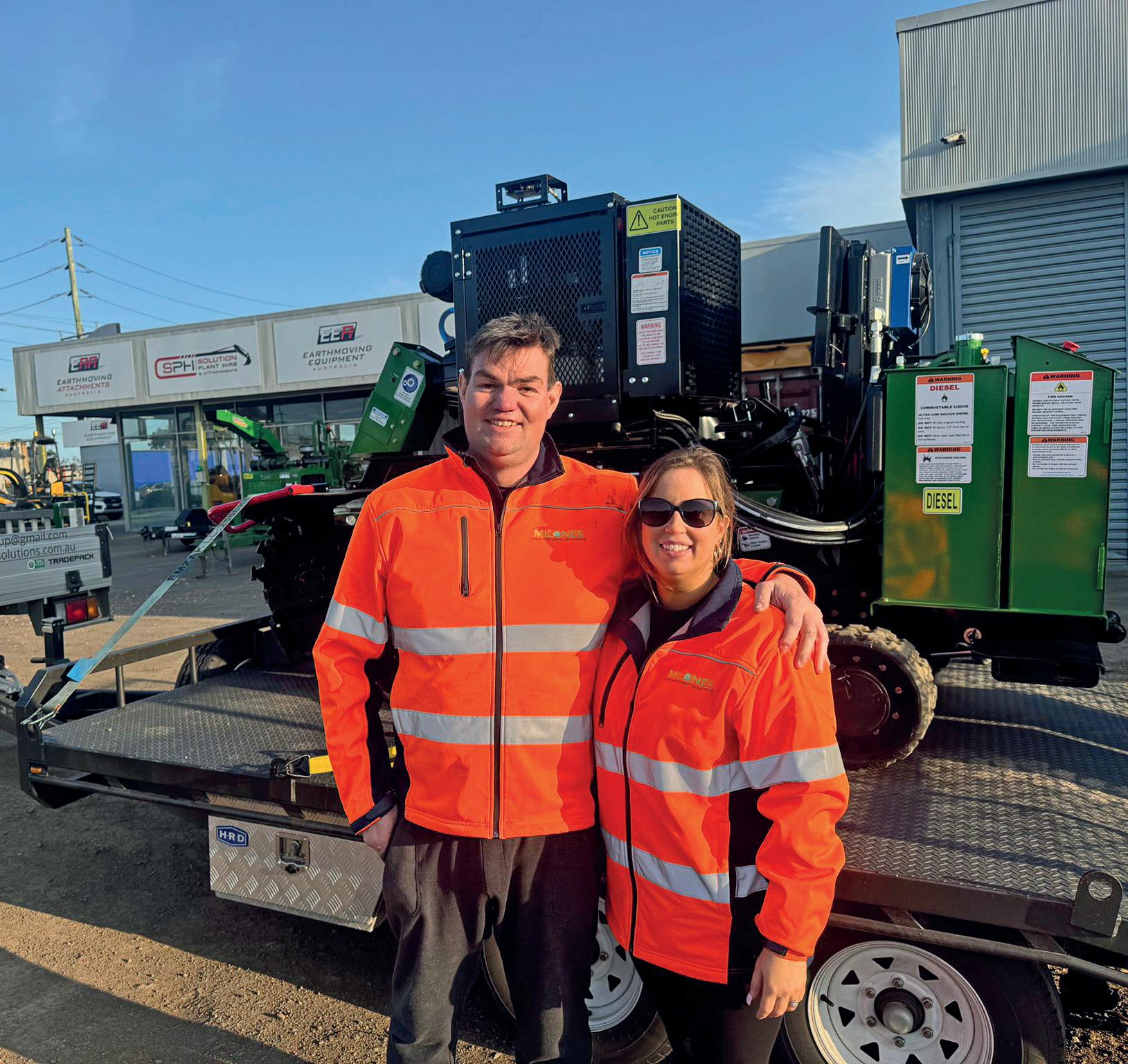
Exceptional after-sales support elevated Charlie Milone’s experience with Bandit.
W
hen it comes to running a successful tree-chipping business, having reliable machinery is just one piece of the puzzle. For Milone’s Tree and Lawn Solutions, trustworthy after-sales support has been a major reason in choosing Bandit and the national dealer, Tree Care Machinery.
The family run business in Melbourne purchased its first Bandit machine in 2022 – a 12X chipper – and since then has taken delivery of a variety of Bandit chippers and Bandit stump grinders. Today, Milone’s has expanded its fleet to
five Bandit machines, with a new SG-75 stump grinder and Bandit 15XPC arriving this month. Milone’s owner Charlie Milone said Tree Care Machinery’s commitment to quality and customer care resonated with his business values as soon as he walked through the door.
“From our first inquiry to the final purchase, the team at Tree Care Machinery demonstrated unparalleled professionalism and knowledge,” said Charlie. “They went above and beyond to ensure we had all the information we needed to make an informed decision.
“From their unwavering commitment to quality and their dedicated customer
service, to the exceptional performance of their products, we can confidently say Tree Care Machinery has set a high standard in the industry.
“When we purchased a wood chipper from Tree Care Machinery, we were not only impressed by the quality of the product, but also by the level of support we received after the sale.”
Charlie had previously dealt with other woodchipper brands in Melbourne, but said his experience with Tree Care Machinery has been nothing short of exemplary, highlighting the critical role
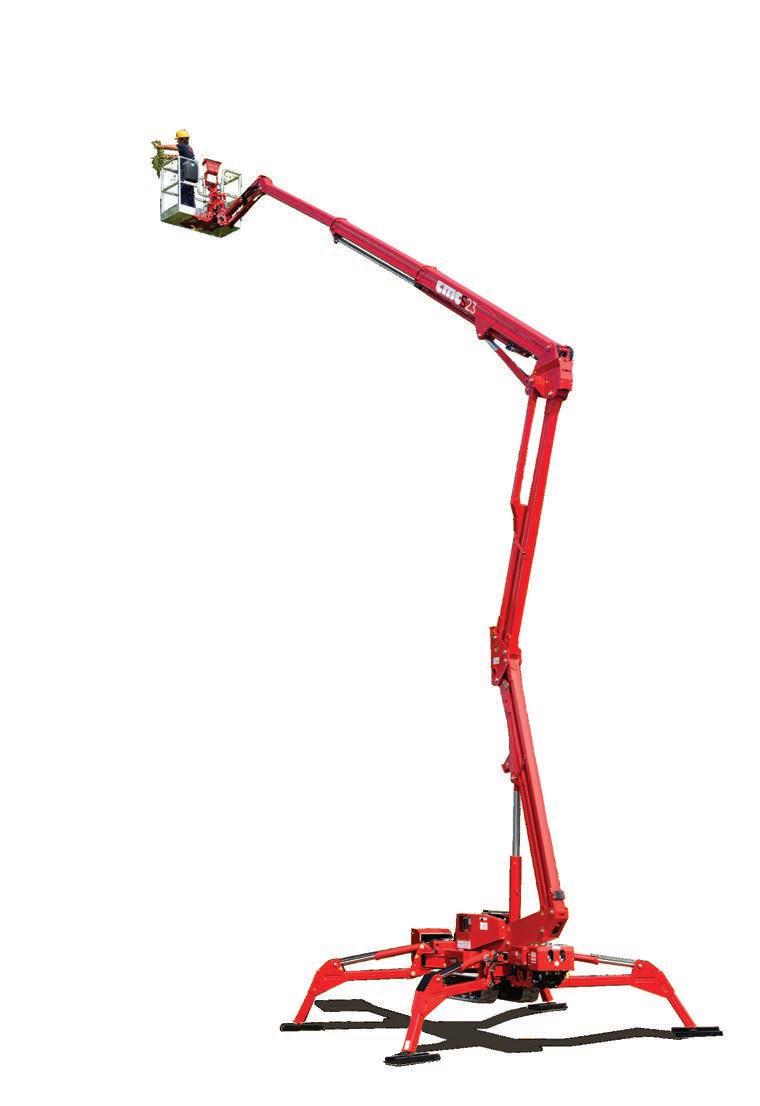
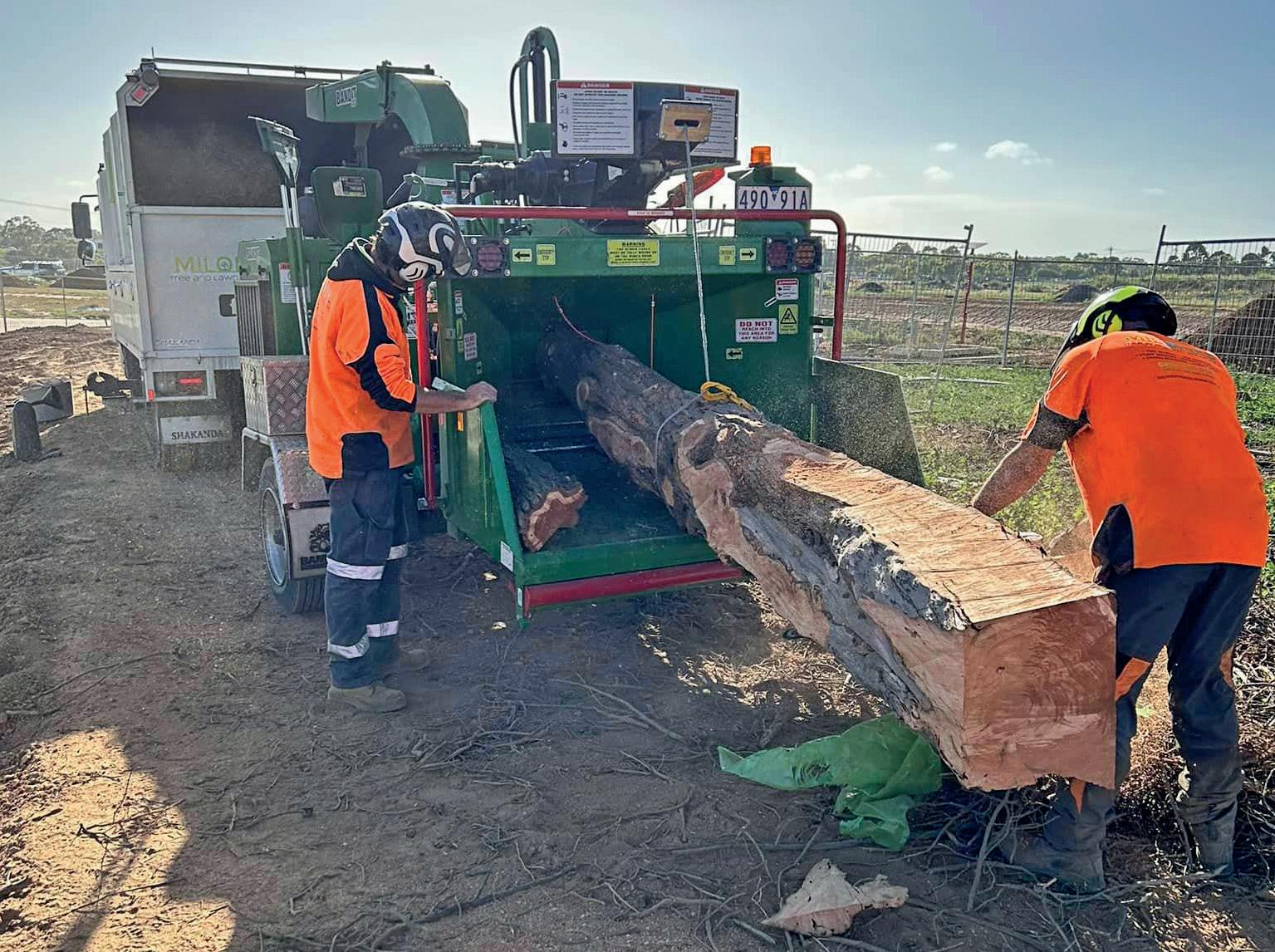
after-sales support plays in the longevity and efficiency of his business operations.
Charlie recalled a particular incident that stood out as a testament to TCM’s commitment to its customers.
“We reached out to TCM’s after-sales support people, and they promptly sent out a mechanic to diagnose and resolve the problem. The professionalism and efficiency with which they handled the situation were commendable. Not only did they fix the issue promptly, but they also provided us with valuable maintenance tips to prevent similar problems in the future.”
It’s this kind of comprehensive support Charlie believes sets Tree Care Machinery apart in the industry.
“TCM’s after-sales support didn’t end with just issue resolution. The company followed up to ensure everything was still running smoothly and offered additional resources for maintenance and care.
“The after-sales support from TCM has been instrumental in ensuring the optimal performance and longevity of the machinery we have purchased.”
The five Bandit machines in the Milone’s fleet have proven to be reliable and efficient performers. All Bandit machines are built in America, which

a top-quality product.
“The lift-and-crush features within the Bandit chippers ensure premium performance when processing large materials,” he pointed out, “and Bandit is an employee-owned model which aligns with our core values.”
Other impressive features of the 18XP chippers include:
• Forestry discharge
• A 142HP CAT engine and heavy-duty feed system, and
• A throat opening of 19.75"h x 20.5"w.
Charlie started his business after returning from service in the Australian Defence Force and has turned a humble idea into a thriving family run business
based in Melbourne’s western suburbs.
“Milone’s specialises in tree removal in the commercial, government and private sectors. We also specialise in residential pruning as well as cyclic and reactive pruning for local councils, as well as stump grinding,” said Charlie.
“Customers can expect Milone’s to stand apart from the competition because of our expertise in tree removal and commitment to customer service. We are dedicated to, and pride ourselves on, providing our customers with quality, professionalism and customer care, and this is what really sets us apart from our competitors.”
For more, visit treecaremach.com.au and milonestreesolutions.com.au.
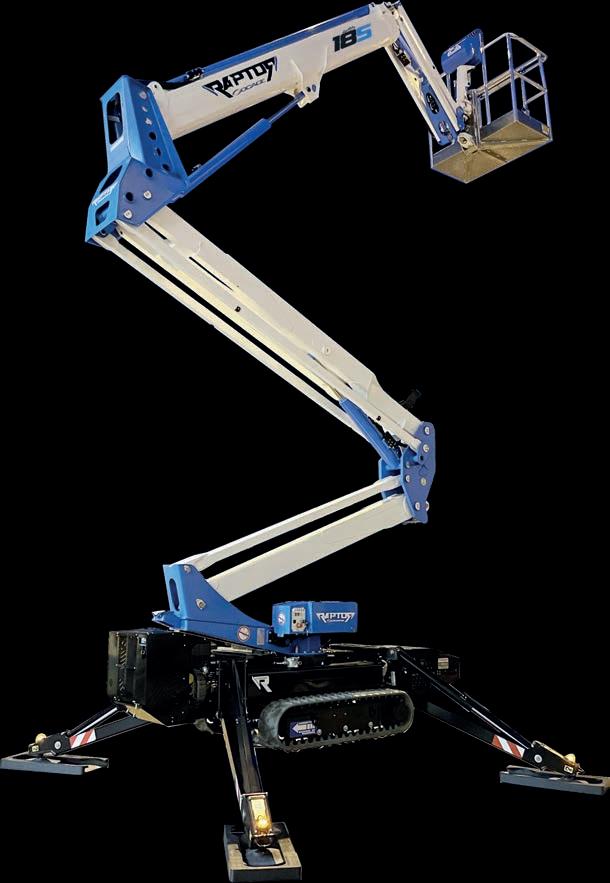


Tree contractors should be aware that the Fair Work Legislation Amendment (Closing Loopholes No. 2) Act 2024 (Cth) (‘Closing Loopholes No 2 Act’) received Royal Assent on February 26, 2024. The Closing Loopholes No 2 Act significantly amends the Fair Work Act 2009 (Cth) (‘FWA’) and includes the following changes with respect to casual employment:
• It repeals the existing definition of ‘casual employee’ in s.15A FWA and introduces a new definition that includes a ‘general rule’ and ‘indicia’ in assessing whether
the employment relationship is characterised by an ‘absence of a firm advance commitment to continuing and indefinite work’, and takes into account the totality of the employment relationship;
• It clarifies that an employee engaged as a casual employee will remain a casual employee until the occurrence of a ‘specified event’;
• It replaces casual conversion arrangements with a new pathway for employees to change from casual employment to full-time or part-time employment through ‘employee choice’. Casual employees may provide their employer with written notification if they believe they no longer meet the requirements to be a casual employee, and such notification can be provided after six months (if the employer is not a small business) or 12 months (for smallbusiness employers) of employment;
• It replaces the process currently set out in s.66M (Disputes about the operation of this Division) with a new
process for resolving disputes about changes to casual employment; and
• It outlines additional obligations for employers in relation to the Casual Employment Information Statement, establishing an anti-avoidance framework in relation to sham contracting of casual employees to deter employers from engaging in tactics to avoid the new provisions.
The above changes take effect from the full first period on or after August 26, 2024.
The Fair Work Commission (‘FWC’) is currently reviewing the interaction between the changes to the FWA concerning casual employees and modern award terms. The FWC has expressed provisional views in relation to variations to modern award casual terms that variations are necessary to resolve potential uncertainty and difficulty in interactions between existing modern award provisions and the amended FWA.
Although the FWC published a sample of draft determinations reflecting its provisional views, final determinations varying modern awards have not yet been published. Any variations made by the FWC will commence on the date specified in the determination (which may be a day before the determination is made).
A new Casual Information Statement has been issued and is available from TTIA. Further information expanding the changes was discussed during TTIA’s Member IR briefings recently held in various states.
If you are not a TTIA Member and need assistance in developing policy in relation to these issues, or require further information, TTIA is ready to assist. Phone the TTIA office on (02) 9264 0011, or email ttia@ttia.asn.au, for information on becoming a member.

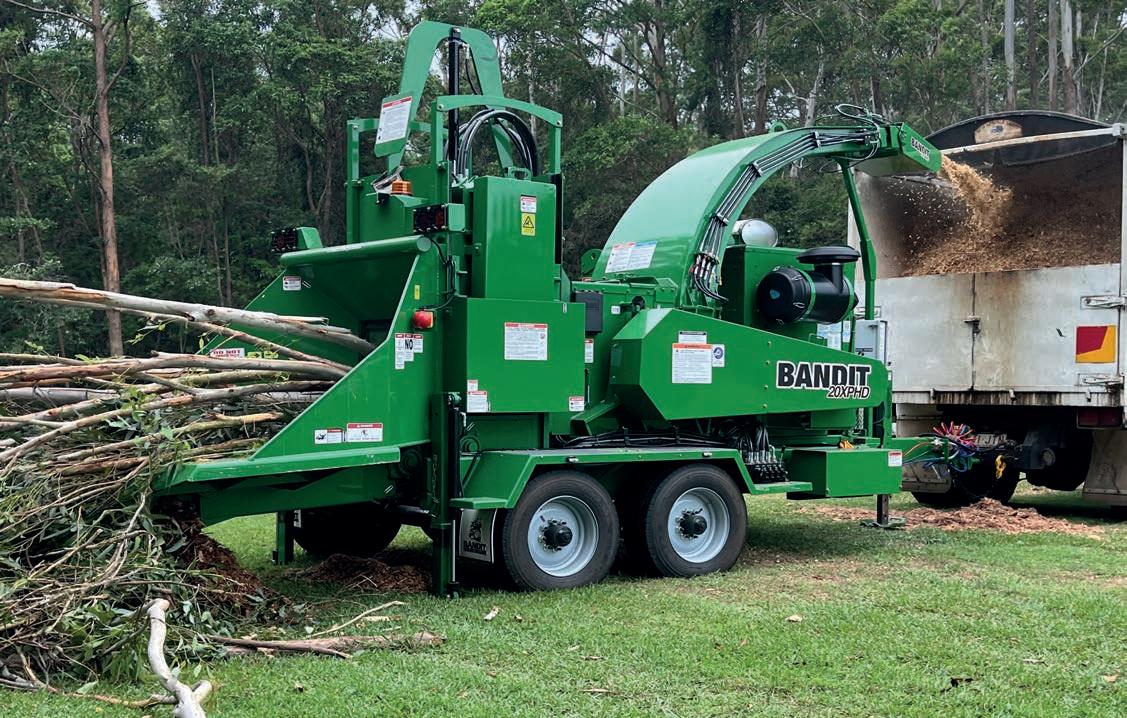
Available to demo and buy! Powered by a 365 HP QSL9 Cummins, the Bandit 20XPHD has landed in Australia. A huge 22-inch feed capacity makes any large-scale job a breeze. Enquire today!

TCAA regular Jim McArdle delves into a topic which deserves far more attention from arboriculturalists.
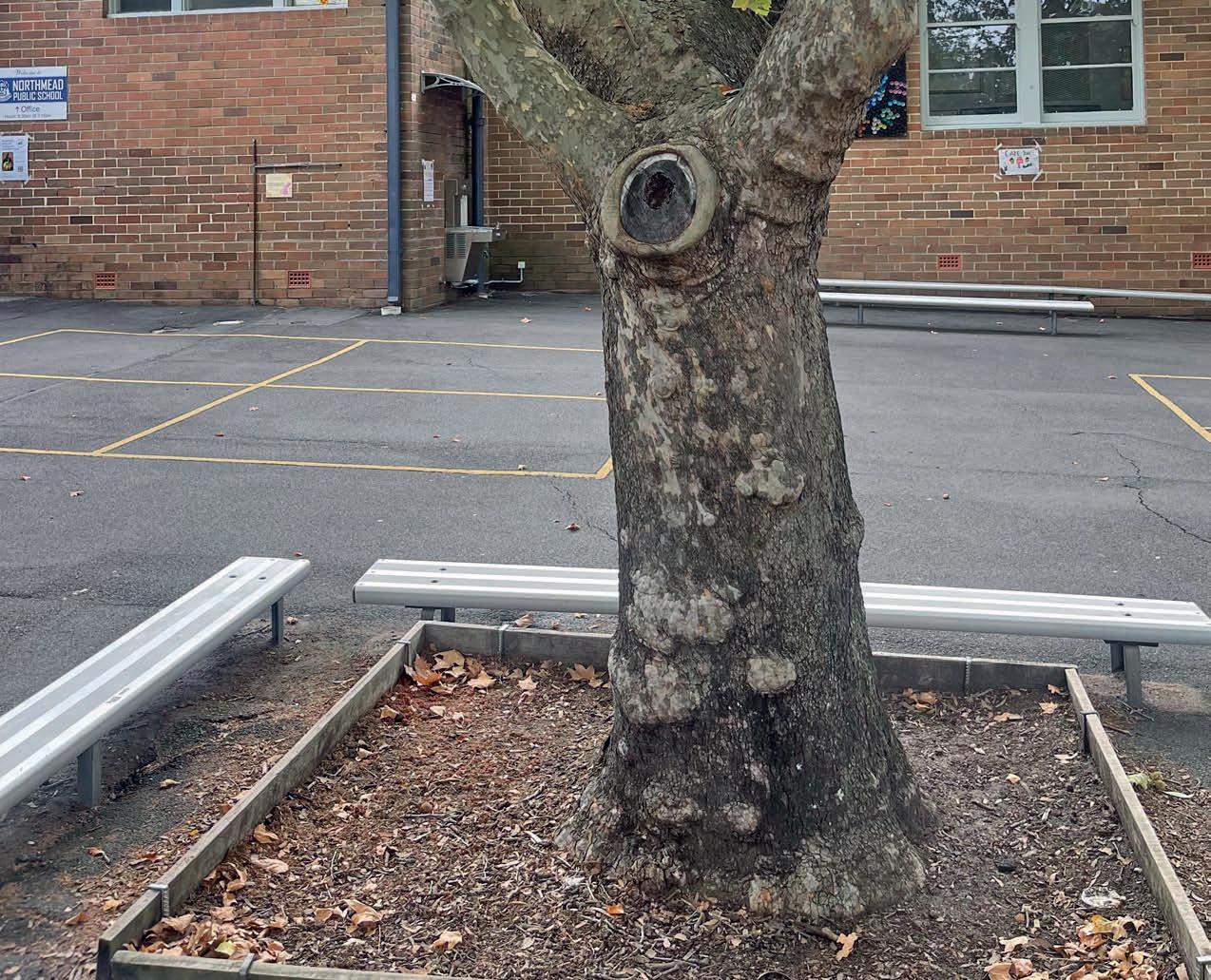
Infrastructure must, over time, affect tree health. Images: TCAA
The best type of soil for trees? Loam is probably a reasonable guess, and soil with a large humus content.
With suitable environmental conditions this type of soil hosts a thriving mass of beneficial microbes and macro-organisms suitable for root colonisation and stabilisation.
While reviewing literature on new products that can assist the beneficial role microbes play within the rhizosphere, the TCAA came across a few golden ones. Nutrogs Popul8, Bushtucker, Osmocote Native, Biodynamic 500 and other natural conditioners for native trees with low phosphorus requirements have taken the remedial world by storm and help create the best conditions within the root zone for growth and development of the tree’s root systems.
Humus content assists soil moisture capacity and increases soluble-nutrient
uptake. It’s ideal when clearing or compaction is limited or non-existent, and will, in turn, lead to growth of fungal hyphae and so on, allowing an increase in nutrient supply and improved soil structure.
Fungi are the heavy lifters in soil. All trees have relationships with fungi, and use of glyphosates destroys the soil biota which contain the hyphae mycelium. Bacteria evolved with us, and the only issue with bacteria is that it should be in the right place. Some bacteria from the garden are good for human immune systems, while common bacteria like M.vaccae acts as an antidepressant, increasing hormones like serotonin and norepinephrine in the prefrontal cortex. Maybe this will bring a new rush of sustainability arborists who want to feel good about their job?
There was also a saying: ‘Anything that’s
biological does eventually kill you’, but that’s no surprise. Everything in Australia can kill you, so prioritise your risk.
Nematodes – or ‘microscopic eel worms’ – colonise pests like slugs, weevils, leather jackets, grubs, and codlin moths. After a lightning strike and rain they release a chemical which can be bad for attacking roots, allowing entry to disease and decay.
Hyphae are the superglue which holds the soil together. Glomalin (from fungi) can last over 40 years in soil, but was invisible to science until around 25 years ago. That was partly as it was treated as a stable component and thought inert. But the slow depletion that stores carbon does most of the bonding in soil.
Excavation in soil can change the soil biome as hyphae strands are cut, and exposure to air can kill a lot of microbes beneficial to the soil.
We know nitrogen is replenished though lightning and legumes (the Fabaceae and bean family). Mimosa, Alder, Redbud, Autumn Olive, Kentucky Coffee Tree, Golden Chain Tree, Acacia and Mesquite are examples of trees that support nitrogen in soil with the help of bacteria. The Azolla tree fern fixes nitrogen with cynobacterium and is used for remediation sites where it’s shown excellent results removing metals like zinc, cadmium, copper and lead. Allocasuarina sp. and Casuarina sp. also fix nitrogen and so can Alnus sp (Alder) and Betula sp (Birch). Cynobacteria can be utilised in conifers, ginko and cycads. Nitrogen is generally an expansive – if not explosive – gas that can increase soil fertility as it’s utilised to create proteins, nucleic acids and other compounds.
Leaching can occur where the soil has been excavated.
We all understand working the soil continuously will reduce fertility and eventually damage the soil. Losing
carbon, losing structure and erosion are troublesome issues.
The moron principle applies to spraying trees with glyphosates, especially natives that thrive on low phosphate soils and affect soil fertility. Glyphosates actively compromise the fungal colonies of soil and reduce soil microbes and the amino acids synthesised by them. Glyphosate also interferes with the shikimate pathway found in all plants, some fungi and bacteria, but not in animals. Thus, glyphosate has a non-selective, broadspectrum herbicidal activity.
After application to plant foliage and subsequent uptake by leaves, glyphosate is transported through the phloem to actively growing tissues like roots and storage organs. Glyphosate may be an additional nutrient source, stimulator of enzyme activity, and promoter of growth for certain fungi species, but negative effects on soil microbiota include reduced root mycorrhization and increased colonisation of Fusarium species. Ecotoxicological effects include
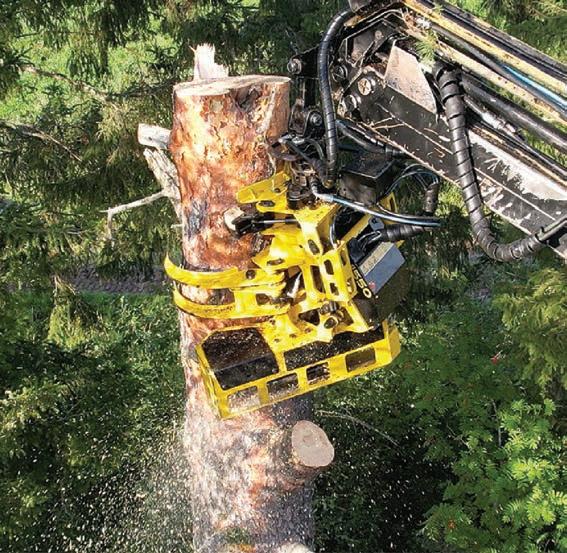

severe growth reduction, chlorosis and phytotoxicity, especially during the early stages of plant development.
A study suggested a limit on the drift dose of glyphosate to five per cent based on a species sensitivity distribution performed to avoid biodiversity loss. We can gauge the education level of the outdoor ground assistant or gardener at most sites we visit. For example, if there is a beautifully crafted ring of lawn cuttings around the base of trees which is increasing temperature around the stem and causing elevated levels of grass-type chemicals which ultimately cause damage and in some cases root rot or stem canker, we assess the groundskeeper’s horticultural training accordingly.
‘Nature positive’ is a term used to describe circumstances where nature – species and ecosystems – is being repaired and is regenerating, rather than being in decline as described by Tanya Plibersek, Minister for Environment




and Water. In her words, the current conservation strategy is ‘failing’. Offset arrangements are failing to prevent environmental decline as they don’t properly compensate for the loss of habitat values.
From a political viewpoint, naturepositive bills are creating two new agencies: the Environment Protection Australia (EPA), an environmental regulator and watchdog; and Environment Information Australia (EIA), an environmental bureau of statistics. Will the consultant eco-arborist be a tool for the new conservation laws?
It’s painful to imagine another level of policing, but maybe consulting in panels for local councils is a specific role where an eco-arborist with specialised knowledge can assist the ecologists and compliance roles in council.
Insecticides and herbicides also aim to interfere with biological functions, and unless it’s within a crisis like a psyllid plague or breaking of a cyclic attack, we should rarely issue a specification without considering the alternatives.
Where an old tree is cut down the subterranean soil microbe community gets attached to the previous tree and turns ‘deadly’ – a bit like when a pharaoh died and the subjects all died when buried with the king. So, replenishment is more difficult on an old stump space and should be avoided. Good results happen if we dig up volumes of soil around the tree or bring in new soil. The
chemicals released, exudates, are still a new area of science. Root tips exude phyto chemicals such as flavonoids, carotenoids and polyphenols, as well as sugars and amino acids. With this sort of action in the soil, trees farm microbes.
One of the unfortunate ways of reducing carbon is land or brush clearing. These are actions which decimate the soil microbial hierarchy so more solar gain is made and wind micro currents change, inducing moisture loss and, in turn, reducing tree and undergrowth capacity and growth. The agroforestry systems could be better at replacing nutrients exported and add nitrogen, inorganic and organic sources and soil conditioners.
There has been a growing disconnect between people and trees and vegetated spaces, particularly for those living in cities. “Many people have become so focused on urban survival they’ve become distanced from the essential and intimate dependence human beings have on plant life,” said Greg Moore on theconversation.com. My thought is urbanites are actively against all forms of space-taking plants and that a Lorax with teeth is needed in the compliance teams of several compliance-issuing bodies.
The programme of lecturing our urbanites is a constant education burden where the AQF3 and AQF5 wave the flag of tree health and growth in the natural environment.
How do we get genuine interaction of the natural environment and humans? Tree climbs, Earth Garden magazine, Saturday morning TV with Costa, Don’s Backyard, Graham Ross Garden Show, landscape shows which bring a new garden…all these things help. Within our design teams they require increasing input dialogue and specification for how we can ensure TPZ edging encroachments are not damaging the ground within the rhizosphere and roots’ zone of influence. Town-planner design teams are adamant that communal facilities within the cities are built. We should be making riparian connectivity adjacent to our roads. Not patches of forest, but rainforest hamlets, tree cities and forest infrastructure – more green, less sheen.
One of the wonders of the tree world is the mangrove tree. It lives in the saltiest, plant-intolerant location and thrives due to adaptions called pneumatophores or air breathers which are modified roots that exchange gasses.
Blue carbon is the sequestrian of biological driven carbon fluxes and storages in marine systems. The term most commonly refers to the role tidal mangroves, marshes and sea-meadows can play in carbon sequestration. When the blue-carbon ecosystems are lost, they release carbon back to the atmosphere, adding to greenhouse gas emissions.
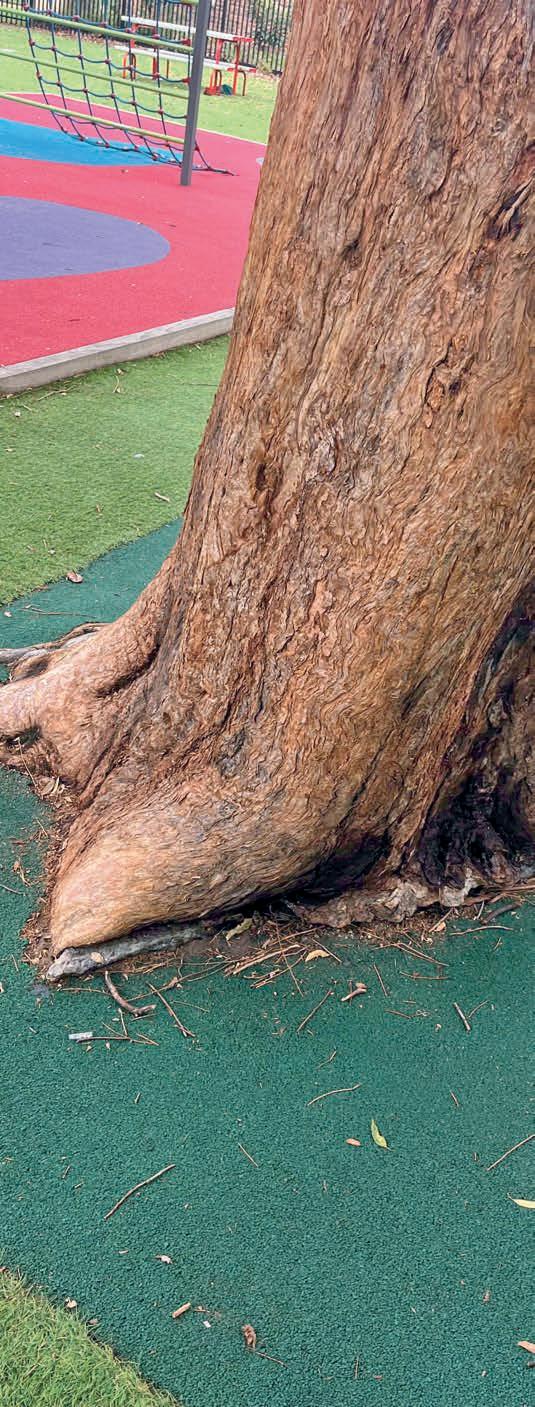
When maintaining carbon discussion and credits we should remember our ‘Dojo of life’ which is the green carbon.
Green carbon is the carbon found in plants and soil of the natural ecosystem. The cross between these is cyan family colours which are the interaction of these two natural places. The blue-green (cyan) interfaces where algae, bacteria, fungi and microbes are the new sequesters of carbon.
Given that in his book SOILS, Matthew Evans stated, ‘…there is three times more carbon in soil than in air’, it makes you think soil is a better storer of carbon than trees. But that’s not the case. Trees are mostly carbon and water and are a product of the soil.
What can the urbanites learn from this?
They also are living in intolerant conditions, with low bacteria which makes it difficult for them to be happy, low oxygen so they’re half alive, and low sunlight so they have frail bones. The theory then should apply where there are healthy, abundant gardens and forest for habitat, where we are able to increase environmental conditions – green culture and green infrastructure – and reduce hard surfaces which reflect heat and reduce soil and the biome of activity that connects us with nature, we’ll be healthier. Hard surfaces and light reflective colours like white can increase heat affectation in nearby trees.
Let’s ponder: ‘how do we get learning institutions to be more appropriate to eco-arborist education?’
AIR-SPADES® are in use in arboriculture, utility, construction, and industrial applications worldwide. AIR-SPADE is the tool of choice due to its fast, non-destructive method of excavation.
Flows from 25cfm to 330cfm.
• Ideal for Bare Rooting
• Radial Trenching


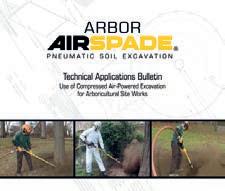



Some of the iconic Moreton Bay figs (Ficus macrophylla) in Perth’s Hyde Park had become infested by the PSHB. ArbWest and the WA arbor community banded together to assess the infestation in the hope some or all of the trees could be saved. Images:
Dave Crispin, senior arborist at Treeswest Australia and Arboricultural Association of Western Australia (Arb West) committee member, was rapt to see the arborists of WA unite in time of need.
I have never been one for cliches, but in this case it is warranted: our industry is like one big family.
We all care for our trees. There’s no disputing that, and when it came down to a request for our local arborist community to volunteer their time on a Saturday, we were overwhelmed by the response.


PSHB action
Over the past year I’ve included various updates on a tiny borer that’s creating a great deal of concern and heartache disproportionate to its size. The Polyphagous Shot Hole Borer, or PSHB for short, is a beetle approximately 2.0mm in length. It’s tiny compared to the huge impact it’s having on our urban canopy.
An estimated 6000 trees have become infected – of which 3000 have now been removed – in only three years. Many historical and culturally significant trees have had to be removed, several in some of Perth’s most prominent locations, and it was at one of these high-profile locations, Hyde Park, we were asked to help. At least five


Custom build chippers from the Netherlands available on:
TRACKS
TRAILER
HOOK LIFT
PTO VERSIONS
FROM 12 TO 36 INCH
75 TO 900 HP
Ufkes Greentec Australia Victoria | +61 458 047 132
A sticky white latex was applied over the tiny hole or holes to see if the beetle would emerge.
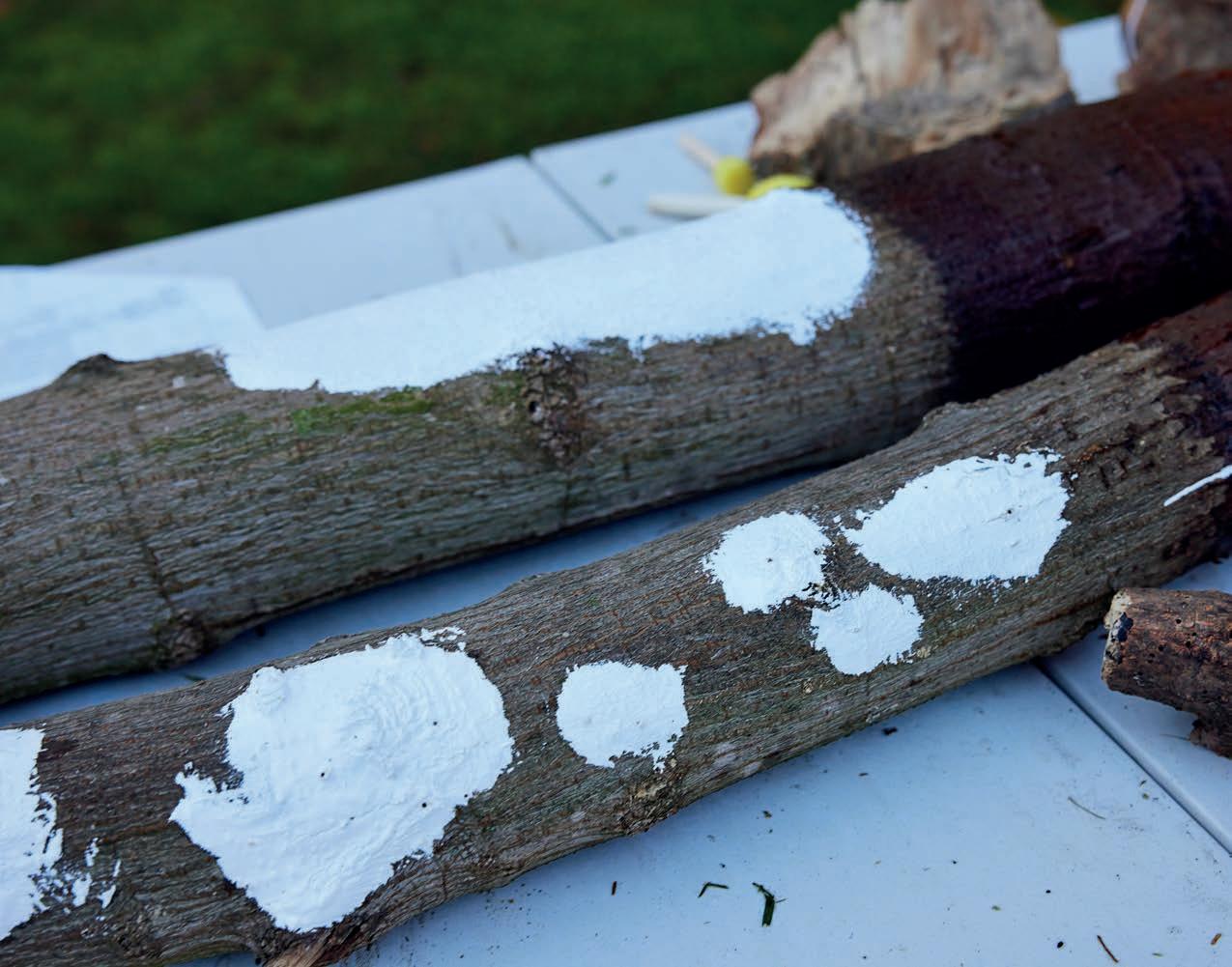
Ficus macrophylla, the iconic Moreton Bay fig, had become infested by the borer and there was a slim chance that if assessment deemed the infestation level ‘low’, removal of the trees could be delayed, or they could even be saved.
The process was fairly simple, but labour intensive: we needed as many people as possible, including experienced climbers and ground staff to make the event work.
Our association, ArbWest, organised the event in conjunction with the City of Vincent (a local government area outside Perth) and the Department of Primary Industries and Regional Development (DPIRD). Like all our events, a sub-committee was formed, led by Joe Carriera from Beaver Tree Service, myself, and Matt Clark from the City of Canning.
As the DPIRD is still in the eradication phase of dealing with the borer the
strategy has been mainly one of removal, which is part of the mandate, but has meant a huge cost to Perth’s already dwindling urban canopy. With so many trees already gone, if we were able to assist in assessing some of the trees, and the infestation loads were deemed low, there may have been a chance to rethink the removal strategy.
Maybe this could be replicated on some of the other significant trees?
This was of course dependent on the DPIRD.
Working under the direction of the DPIRD and Ben Phillips, a researcher from Curtin University, the data collected would be used as part of a bigger initiative in predicting spread.
We set the date for 6.45am Saturday, August 10. By then the DPIRD had agreed to attend the event and as part of its public awareness campaign, to inform the local community about the borer, the City of Vincent to show it was being proactive in managing its canopy
and ArbWest was to bring everything together.
From the outset, the day attracted a considerable amount of interest from local and mainstream media. Nothing like it had been attempted before, and to my amazement we had 45 people turn up, a mixture of male and female, locals and people willing to lend a hand from out of town.
As usual, our industry has its diehards, the people you can count on time after time, and they did not disappoint this time either.
I have nothing but praise.
We decided to tackle three of the trees, dividing each one into quadrants using the cardinal points as reference markers. Each climber would work in one quadrant with a corresponding colour. This was consistent throughout the three trees.
For north we allocated green, red,


The process was simple, but labour intensive. Experienced climbers and ground staff were needed to make the event work.
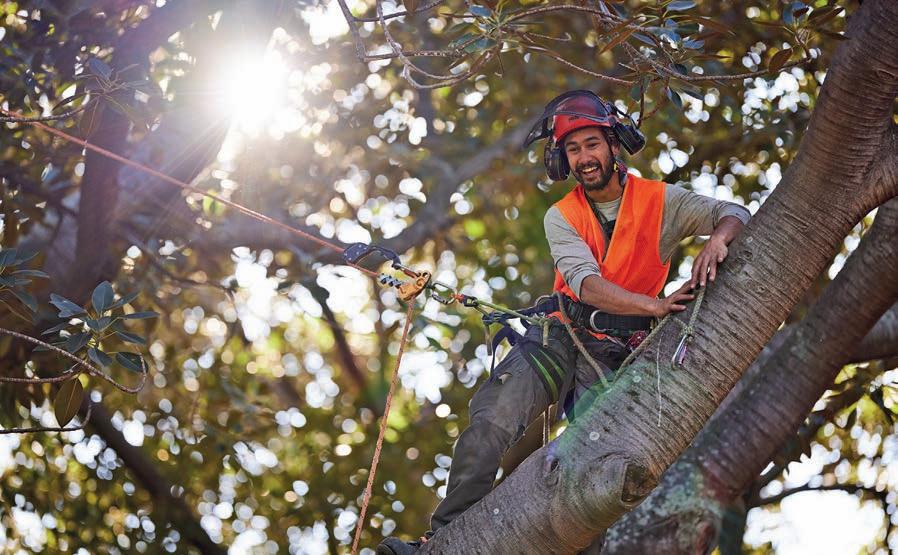
yellow then blue. These were coloured surveyors’ flagging tapes. Once the climber had a positive identification of a hole, the tape was tied around the limb and logged by the ground crew. As the climbers worked methodically throughout their quadrant they would flag the hole or holes, write the distance from a central stem, and then the number of holes on the flagging tape in permanent marker. The climber then painted a sticky white latex over the tiny hole or holes to wait and see if the beetle would emerge.
These were checked by the rotating climber later that morning and the information made available to Ben Phillips (the Curtin University researcher).
I am pleased to say it worked a treat!
Pascal Oosterik
Although this was a serious business and extremely important, it was great fun. No personalities or egos surfaced and the veteran climbers helped out the less experienced (every climber had to have a minimum of Cert III in arboriculture to be allowed to climb), and there was even an opportunity to show off some of our new gear –after all, we’re attracted to the latest, shiniest, fastest and generally mostexpensive pieces of kit – aren’t we?
Several of Western Australia’s top climbers turned up, ones that regularly feature high up in the climbing
competitions. One in particular was Pascal Oosterik.
I’ve known Pascal for a number of years, and at 29 he’s worked in more countries and states than most people will ever visit in their lifetime. Originally from the Netherlands where he completed a degree in forestry, Pascal went on to work in the United Kingdom, United States, British Columbia, and a small country called Aruba. Having climbed countless species and being tasked with a variety of challenges, climbing in a large Ficus and painting white latex on borer holes was to be just another one.
I asked Pascal what sort of challenges or other interesting experiences he’d had while climbing trees. He smiled and recalled two occasions. One was when he was climbing in the rainforest in Queensland and became hooked up for ages by a climbing palm called Wait-awhile (Calamus Australia). The plant is covered in spikes that hook into skin and clothing, making it almost impossible to break free, hence you have to wait more than a while to become untangled.
The second (and a big smile came over his face when he related the story) was being bitten by green tree ants (Oecophylla smaragdina). “If you weren’t getting bitten at least 100 times you weren’t really trying,” he said. He recalled they would regularly drop out of the trees and bite him in every orifice.
Ouch!


As I write this in early September 2024, the DPIRD has removed the quarantine areas and has now named them zones. Perth and the surrounding suburbs are Zone A. Outside Zone A, is Zone B, an area currently with little or no infestation. This is looked at as a buffer to try and contain the borer, and my understanding is this zone is going to be heavily monitored and infestations dealt with as quickly as possible when they arise.
We don’t have a playbook for this, and it’s been extremely stressful and challenging for all stakeholders. We’ve had to make it up as we go along. One positive that has come out of this is the need to work together. Collaborations are a must, and the sharing of information is paramount. It’s the only way we will manage this pest.
Fortunately, for us, we have the benefit of hindsight. Fellow arborists, researchers and academics in Southern California are willingly sharing their experiences and knowledge so we may be better placed to lessen the impact.
Our industry is like one big arborist family!
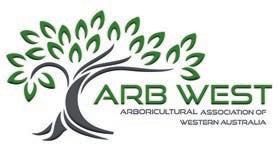

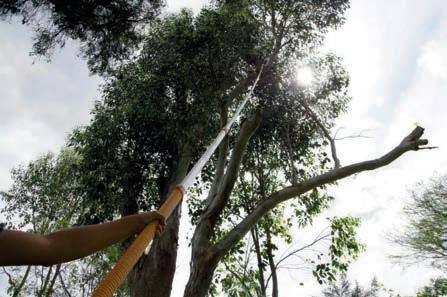

The Queensland Arboricultural Association oversaw a blinder of an event with the 2024 Queensland Tree Climbing Championships at Mount Tambourine in Queensland in September.
Set against the stunning backdrop of Mount Tamborine, the Queensland Tree Climbing Championships (QTCC) 2024 took place on September 7th and 8th, and what an unforgettable weekend it was! Over the two days, 28 highly skilled competitors battled it out for the prestigious title of Queensland state champion, with their eyes on mastering both skill and precision.
Incredible efforts from all participants overcame a few technical hiccups which were quickly sorted thanks to the assistance of Lee from Arb Connect. After a thrilling first day, the finalists were announced for the Masters’ Event, with Jarrah Hamlin, Jamie Boston, Terry Boston, Rory Haydock, Jess Hamer, and Julia Steele earning their spots in the final showdown.
Sunday brought even more excitement as the world number-one climber, Barton Allen-Hall, performed a breathtaking demo climb. Spectators from the local Mount Tamborine Country Markets were captivated by his skill, while the top four male and top two female competitors from the Saturday rounds prepared to take on the Masters’ Event. As if the competition wasn’t intense enough, competitors were greeted by some feisty local magpies, adding an unexpected challenge to the day!
The QAA owes a special thanks to the Mount Tamborine showgrounds for hosting us in such a picturesque setting, and to the Country Market attendees for their enthusiasm in watching and supporting the talented, qualified arborists. It was an excellent opportunity to highlight the importance of using tradequalified professionals for tree care.
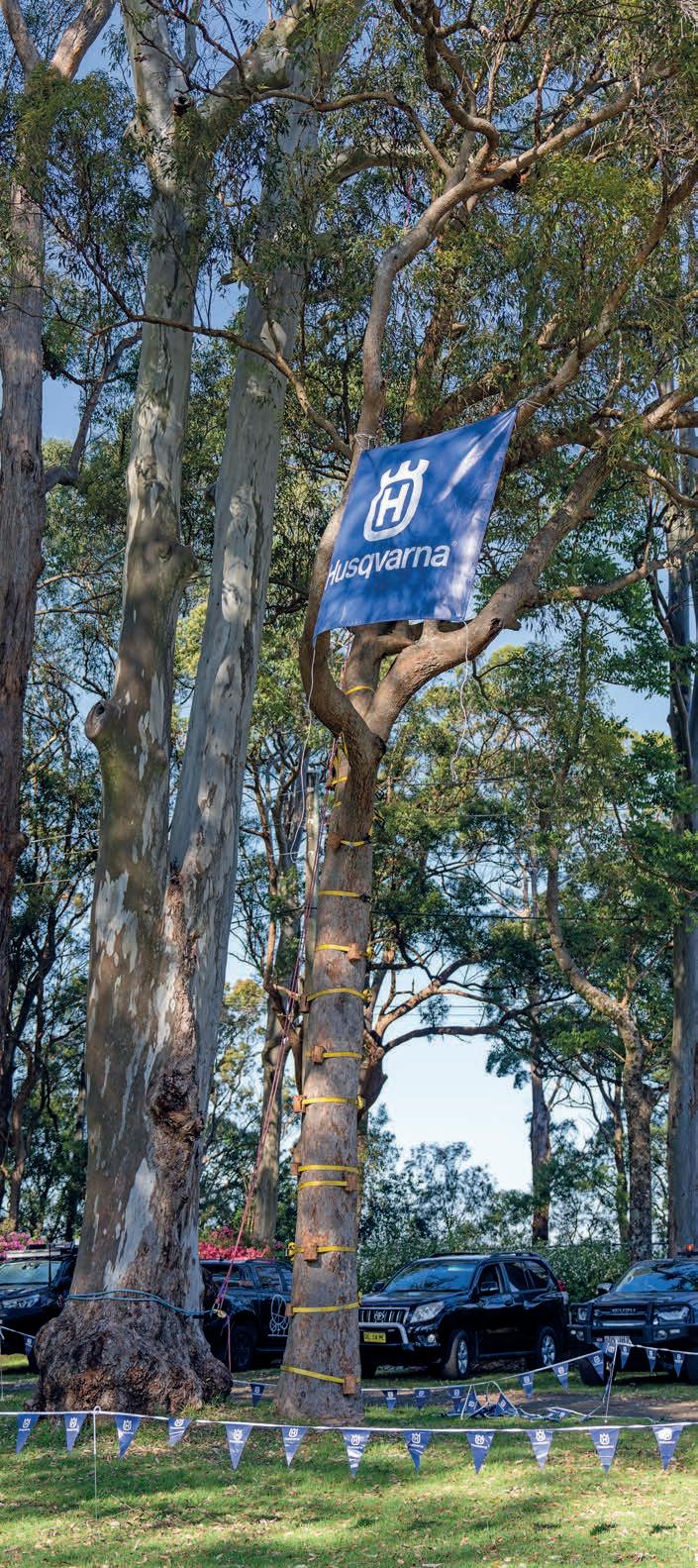

The final tally saw tight competition and razor-thin margins, with the places going to:
Males:
• 1st: Jamie Boston (210.33)
• 2nd: Jarrah Hamlin (211)
• 3rd: Rory Haydock (183)
• 4th: Terry Boston (115.67)
Females:
• 1st: Jess Hamer (115.67)
• 2nd: Julia Steele (40.33)
Major event sponsor, Husqvarna, was instrumental in making this event a success. We’re incredibly grateful for Husqvarna’s ongoing support, including its contribution to the female perpetual shield. Special thanks also go to Inspiration Trees (Nick Batson) for organising the beautifully crafted perpetual trophies, which truly added a touch of elegance to the event.
We extend our deepest gratitude to all our trade sponsors: Arb Connect, Arbor Industrial, Husqvarna, Inspiration Trees, Professional Tree Works, Reecoil, Shockload Bags, The Arbor Van, and Vermeer. Your generous donations, both in prizes and support, were invaluable and deeply appreciated by the competitors and the wider community.
Lastly, a heartfelt thankyou to our volunteers, the backbone of this event, braving the sun all day with stopwatches and clipboards in hand, some cooking the BBQ and never complaining, and always staying to help pack up. We couldn’t have done it without you, and we truly appreciate your dedication.
For more photos of the event, be sure to check out the QAA’s social media pages and website. Don’t forget to follow and support us — and our sponsors — so we can continue to grow this incredible community.
We are excited to announce the QAA AGM is coming up in November. Keep an eye on qaa.net.au and the QAA social-media channels for the exact date and details. We are calling for new committee members to help keep this association running smoothly and continue supporting the arboriculture community.
If you’re passionate about the industry, we would love for you to get involved!
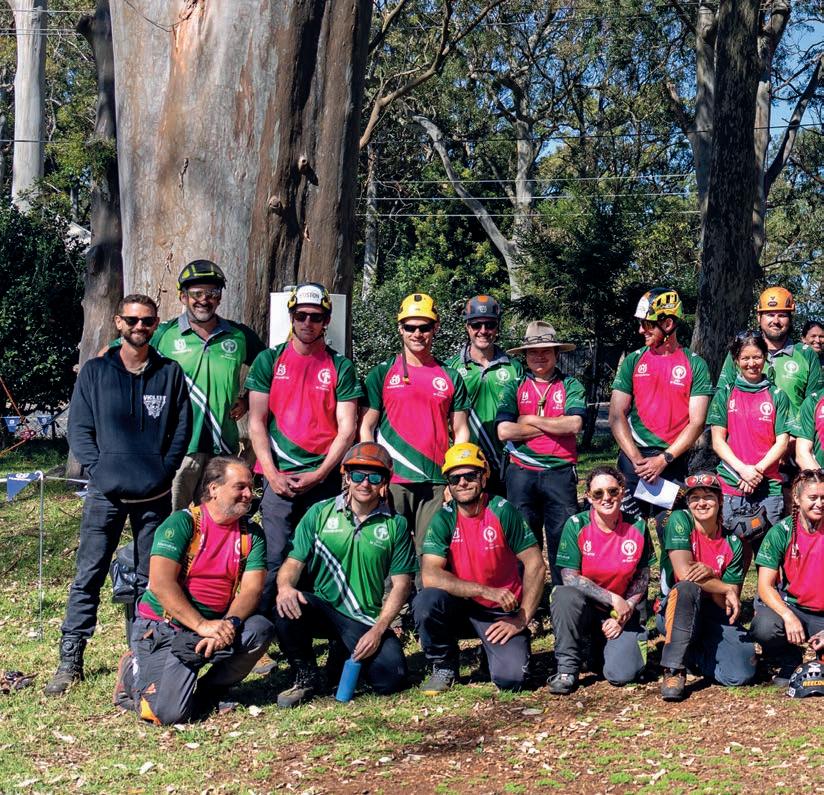


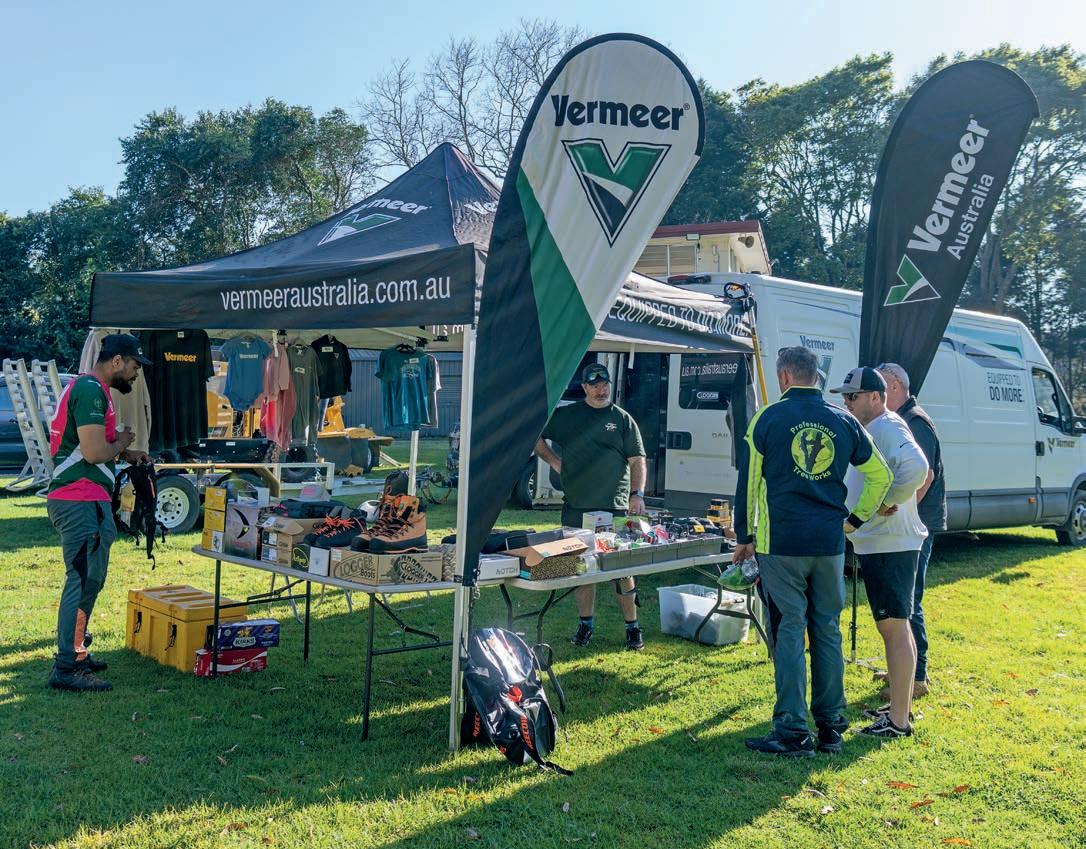
Great support from sponsors.
The 952 Mega 22-inch, 400hp chipper in action chipping a dead gum. Images: Ufkes Greentec

Dutch company Ufkes Greentec specialises in the engineering and production of woodchippers, from 12 inch to 36 inch, 75hp to 900hp, PTO and excavator stump grinders, wood cranes and forest mulchers. The company’s machines are custom built for professional use and will meet the demands of even the hardest working contractors.
Ufkes Greentec’s production site boasts welding robots, a wellequipped testing area and a modern stock-management system, and the company works hard at sustainability in its careful use of both energy and personnel. The building is heated with wood chips obtained from machine testing, for instance, and the whole process from design to production is handled within the company itself.
Ufkes Greentec arrived in Australia when Dutch-born arborist Jor Boogaart started his own company, The Climbing Dutchman, here in 2010. After a couple of happy decades in the tree-care industry, Jor was surprised it was not a common sight to see chippers with cranes. His time as an arborist in Europe had taught him the rig made for efficient, safer and less-strenuous work,
and after three years of careful planning he set up Ufkes Greentec Australia, based in Somerville, Victoria.
In Jor’s own words, “A big dream comes true.”
Ufkes Greentec Australia offers all machines listed on the website, and all chippers are custom built to customers’ specs. But here’s s selection of models:
• 12-inch Cheetah disk 75hp Kubota or 140hp Doosan
• 16-inch Jaguar 140 Doosan with quickchange knives on the drum
• 22-inch 942 275hp John Deere
• 22-inch to 26-inch 952 MEGA 400hp John Deere
• 30-inch 962hp, 400hp, 600hp or 780hp, and
• 36-inch Panthera 900hp.
All these chippers are available in a PTO version, and some are electric PTO
with their own chip bin. The chippers also have wear plates under the knives on the drum, in the chute and behind the rollers – all the spots where the most wear happens. It’s a great feature and extends machine life.
There are two service locations. Ufkes Greentec works together with Chipstar Australia in Kilsyth and Ufkes Greentec Australia Somerville. Jor himself ensures there’s a good stock of parts and consumables available – that’s aside from the locally available parts like bearings.
To learn more of Ufkes Greentec Australia, go to ufkes.net and select the Australian flag on the right-hand side.
Also check out the 3D configurator where you can build your own chipper!
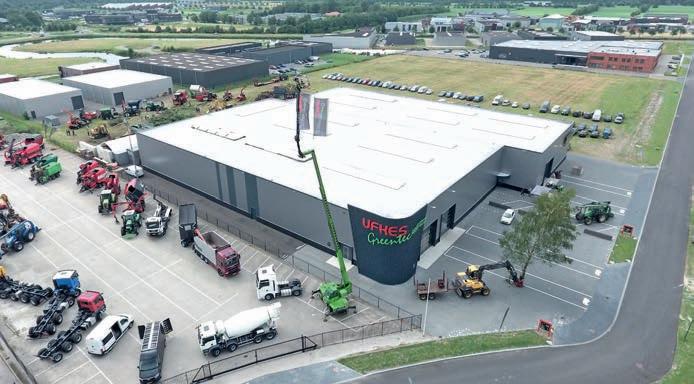
Ufkes Greentec – timeline
• 2004 – Ufkes Greentec was founded in 2004 by Jippe Ufkes. It started with selling and servicing forestry and landscaping machines. Woodchippers, stump grinders, wood cranes, tree shears and so on from renowned brands where sold. To meet the standards of the customers, a start was made at developing its own Greentec machines.
• 2009 – The company grew fast and soon there was the need for more space. In 2009 the first location in Drachten was opened: 2000m2 with a large workplace, warehouse, showroom and offices.
The development of Greentec machines went on and the range of Greentec machines grew: Wood chippers (compact hand- and crane-fed machines suitable for towing behind a car), wood-chipper combinations. stump grinders suited to a three-point hitch and excavators, and forestcutters.
• 2017 – Because the emphasis became more and more the production of new machines, in 2017 there was a new production location built near the existing facility. The site measuring 4400m2 and has all that might be expected of a modern machine factory: a nicely decorated area with lots of light and space, a new welding robot, a well-equipped testing area and optimal stock management, allowing the employees to do their job unobstructed and safe.
Fast forward to 2024 Ufkes has dealers in Australia, USA, New Zealand, UK, Madegascar and all over Europe

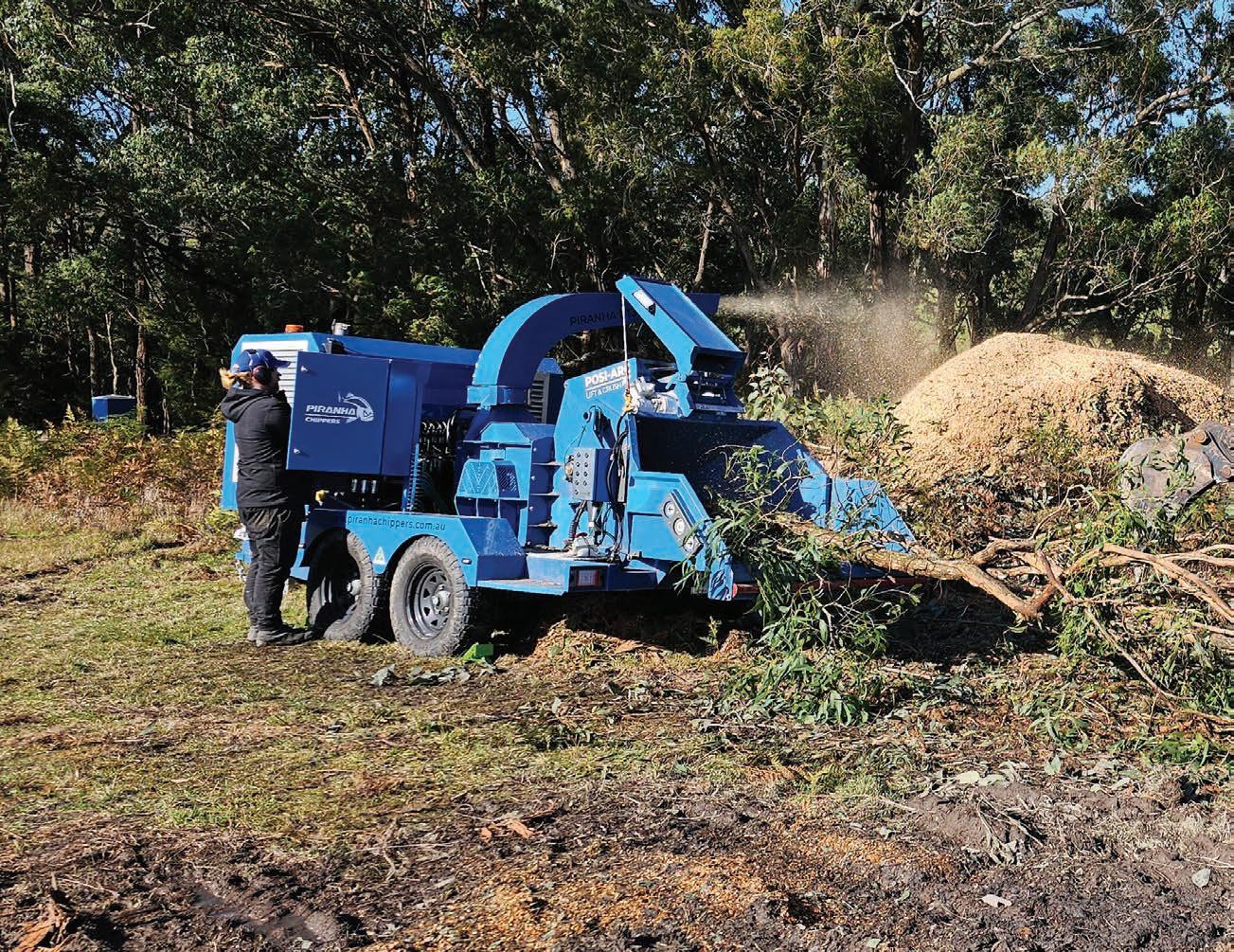
Piranha’s BT300 was designed to address two key challenges common in the current offering of woodchippers: performance and serviceability.
Design of the BT300 kicked off with performance in mind and started on a clean sheet of paper. From there, Piranha Chippers built a robust woodchipper that will chip 300mm-diameter (12") solid Australian hardwood. That’s what the ‘BT300’ model number signifies (300mm), and it can process tough timber up to that diameter with ease.
Powering the BT300 is the supertough Isuzu 4HK1 engine, producing a class-leading 197hp, which spins the 26" (650mm) diameter drum and its four staggered knives. The drum is fed the timber via two large horizontal feed wheels, with high torque capacity hydraulic motors, through a direct infeed opening at 500mm wide x 390mm high (20" x 15") to produce very impressive chipping performance.
The BT300 has a huge 170-litre fuel tank custom made to fit underneath the chassis and create a low centre of gravity. The large capacity ensures the
chipper will work for many days before needing to be refilled, saving valuable time at the start of every day as the crew heads out. Add in the comprehensive hydraulic-assisted features which include infeed hopper up and down, 360-degree discharge chute swivel, automatic clutch engagement, feed roller lift/crush and a powerful winch, and the BT300 is a serious performer designed from the ground up to excel at chipping wood and making life easy and safe for the operator.
All this is packaged into a modular chipper design which is hand made from Australian 350-grade structural steel to ensure the BT300 will perform as expected every day.
Does that mean that the Piranha is expensive or heavy?
It’s a good question.
The reality is that in 2024 the BT300 is, at 3800kg, currently the lightest
and sharpest-priced 190+hp chipper currently available anywhere in Australia. If horsepower equals productivity, then the BT300 is offering serious value for money. Backed by a comprehensive five-year/3000-hour warranty, it’s a true revelation in ground-breaking design. When you see the BT300 operating in person, you’ll truly appreciate the craftsmanship and value a Piranha chipper has to offer anyone serious about chipping timber.
Serviceability was another factor Piranha wanted to get right and could see the most practical solutions were not being offered in other chipper designs.
First is the resilience of the Isuzu engine itself, renowned as one of the world’s most reliable engine packages. The 500-hour service intervals of the 4HK1 mean you can concentrate on working for longer, while the chipper is earning its keep rather than being stuck
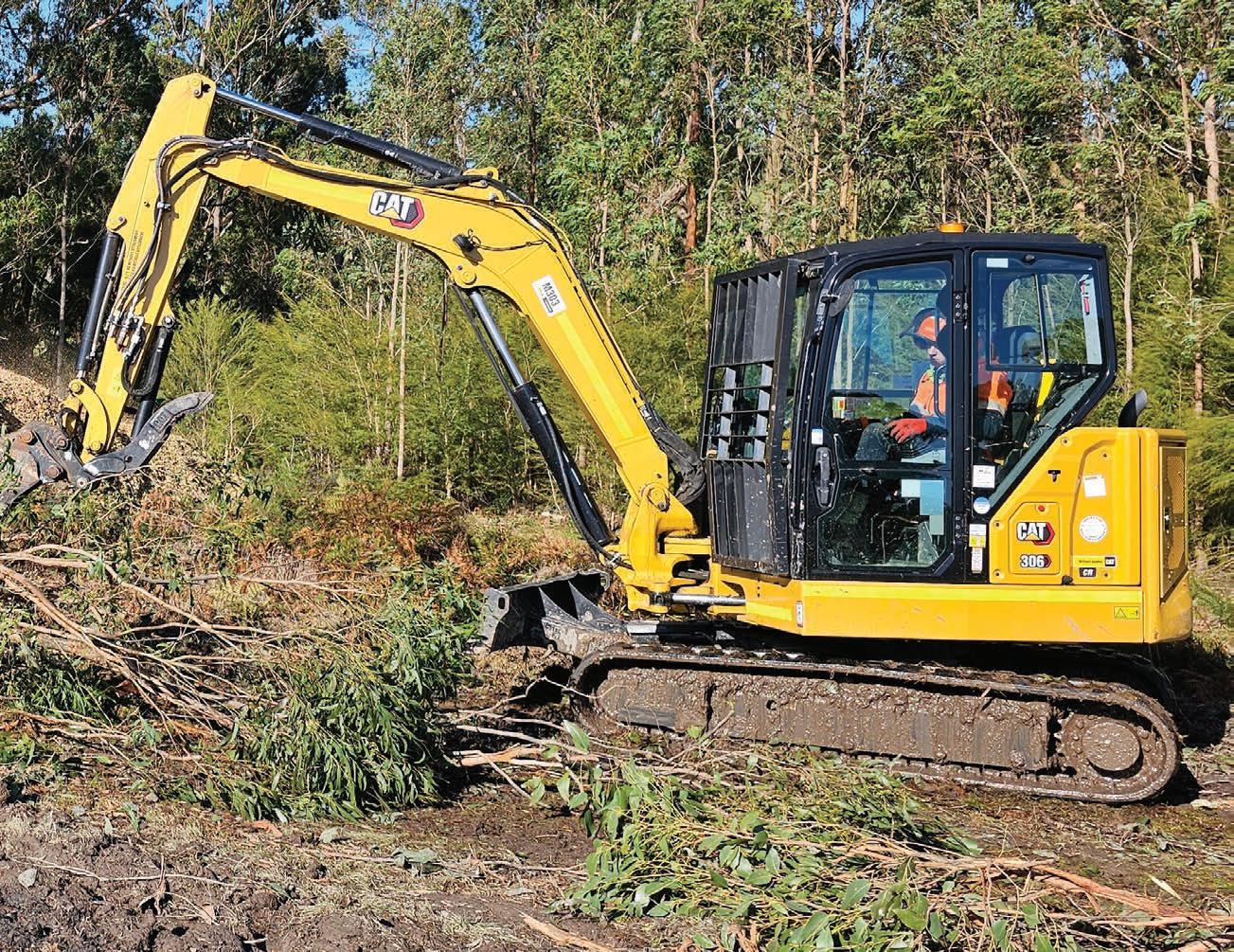
in the workshop being serviced.
Next is the front engine-cover access door which houses all engine and hydraulic filters in an easily accessible configuration, making servicing the BT300 stress free. When it comes time to change the engine oil, a remote drain sump hose makes the task easier than could ever be imagined. There is no more crawling underneath the chipper to remove a sump plug and watch the dirty oil spill all over the trailer chassis to make a time-consuming mess that needs to be cleaned up.
Next, the central greasing station: there’s no need to climb all over the chipper looking for every grease nipple that needs to be greased. The BT300 has a centralised grease station which ensures that this daily task is simple and straightforward, making life easier.
Then there’s the chipper drum housing – possibly the greatest feature of all Piranha chippers – which makes servicing the cutting knives as easy
and as safe as possible. The whole top of the drum enclosure opens, fully exposing the chipper drum, so knives can be changed out as quickly and easily as required. In addition, there is an accessway alongside the drum housing to ensure secure footing is available while maintaining the cutting knives.
Finally, all the running parts themselves.
The Piranha BT300 has been built with the highest quality parts available here in Australia, and all parts are widely available off-the-shelf from quality suppliers, meaning parts are readily available Australia-wide. With the factory support and backing from Isuzu Australia, the Piranha BT300 can easily be booked in for a service at any of the 42 factory Isuzu service agents Australia-wide.
To learn more of the BT300 and the Piranha company, log on to piranhachippers.com.au.
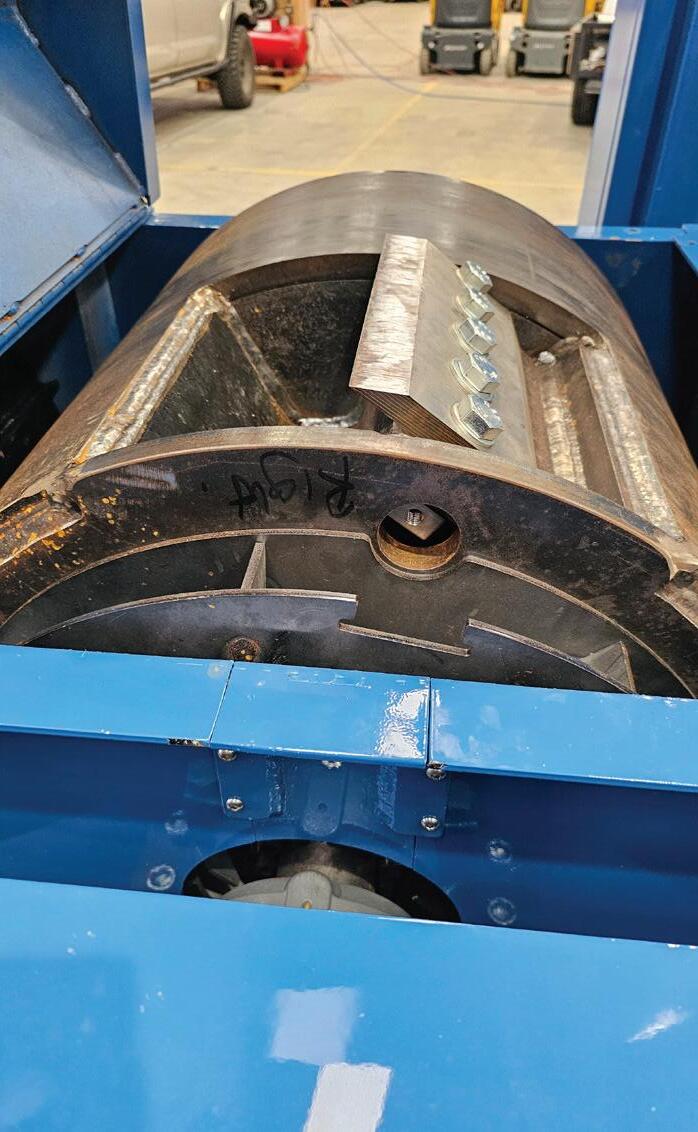
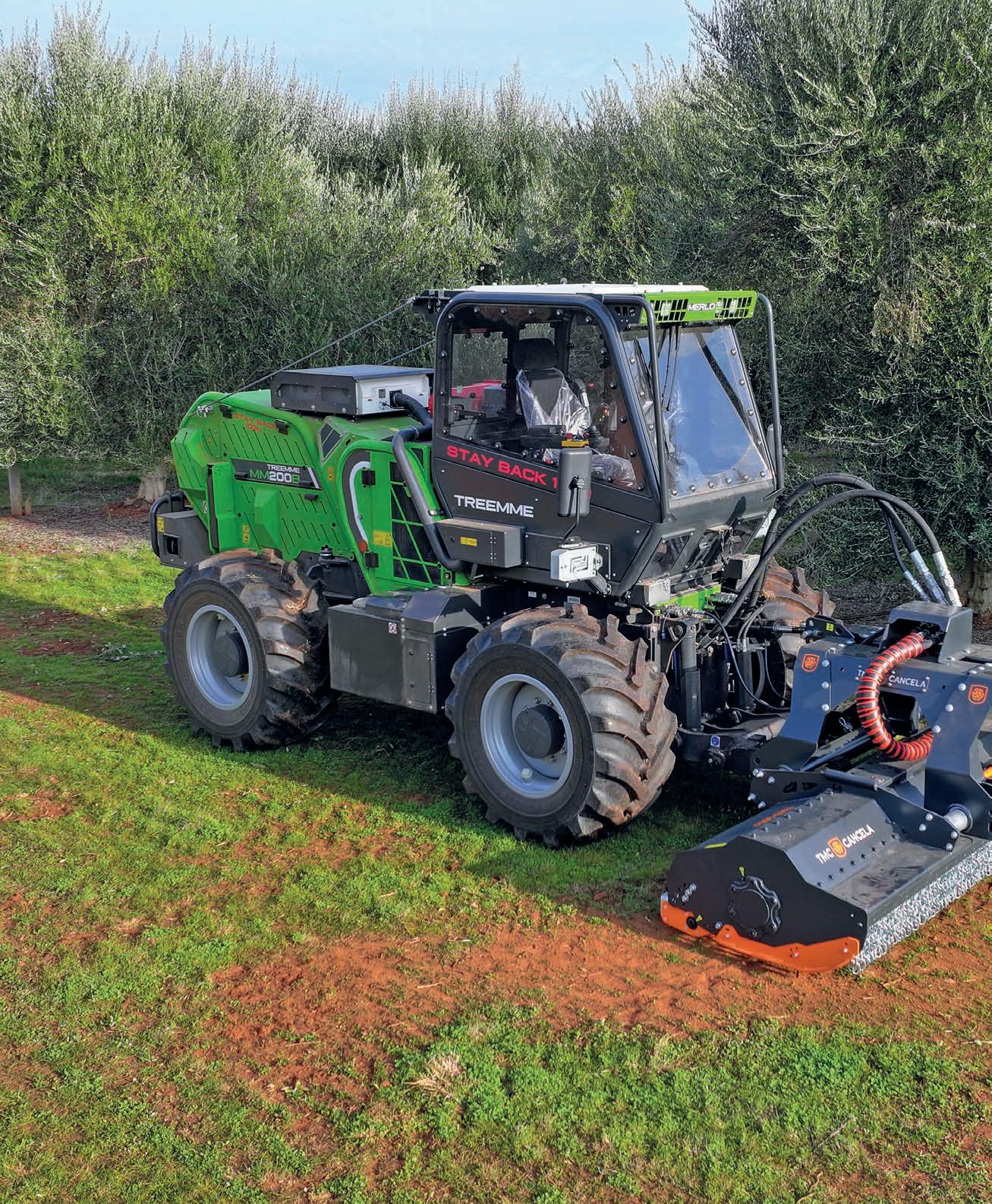
Merlo is a relatively new brand for South Australian-based companies Mulchtech Australia and Vinetech Machinery. For Director Ben Stephen, adding the brand to the company’s catalogue has been a good move.

Mulchtech and its sister company Vinetech were established in 2010 with branches in the Barossa Valley and Renmark, South Australia. Mulchtech deals with machinery relating primarily to forestry and agricultural work, while Vinetech specialises mostly in viticulture and orchard machinery.
The companies’ websites point out they both ‘…strive to have the finest equipment readily available, allowing you to make purchases without enduring months of delays’.
A year or two ago the companies began offering Merlo equipment, and as Director Ben Stephen pointed out, “They’re European machines, and generally European stuff’s very reliable.”
While Ben’s happy with the Merlo telehandlers on the Vinetech side of the business, the TReEmme is kicking some big goals with Mulchtech. Ben had just made a sale and was fairly confident of another in the not-too-distant future, and he was very clear about the reasons why.
“They have good engines,” he told The Australian Arbor Age. “They have a Deutz Tier 3 engine, which is a super-reliable motor, and they’re very fuel-efficient. That’s key these days while fuel costs are through the roof,” he pointed out, and before we could ask anything else he continued: “They’re easy to navigate for operators, and very easy to control. Maintenance is great, and everything’s in a good spot for servicing. We don’t get mechanics being frustrated.”
We jumped in while Ben was thinking and asked about the service from Merlo.
“We haven’t really done a lot of training with Merlo yet,” the South Aussie told us, “but so far the response has been good. Any time there’s an issue they’re onto it. They see us at every field day they go to, and they call in, so there’s good communication so far. Parts they haven’t had in stock have been airbagged quickly, which is good.
“No dramas there at all,” he concluded.
Ben has plenty of experience with heavy machinery of all kinds, and even with other brands and mulchers within his companies. We wondered what set the Merlo TreEmme apart.
“We’re importing and distributing Australia-wide,” the very busy Director explained, “and with the TreEmme we’re obviously trying to promote a tractor platform. We do have other options, but at moment, in certain situations, the TreEmme is a more suitable machine.
“The TreEmme offers more diversity for operators who want to multifunction and use that tractor for more throughout the year. There’s a section of owners who’d buy, for instance, an $800,000 or $900,000, purpose-built mulching-tractor package they can only use for three months. They can only do one job with it: mulch material.
“With the TreEmme we already have three different mulching heads for one machine we sold, and we have stone crushers and bigger flails – out to six metres – on the way. So by this time next year we’ll have at least five different mulching heads for the one tractor platform.
“For corporates it means when they’re going to spend $800,000, they’ll be able to use the machine for nine months of the year, not three months.”
Another facet of the TreEmme which Ben highlighted is the unit’s transport capability.
“In forestry the road speed’s a big thing,” Ben underlined. “The TreEmme’s not tracked machine which has to go on a truck trailer. It can travel from one site to another on its own, ready to work”.
As we listened and contemplated how this story might look, Ben did a great deal of the work for us.
“It’s more just key features,” he said, proceeding to list them:
• Fuel consumption
• Quality motor
• Ease of operator use
• Comfort
• Quiet in the cab, and
• Good vision.
“I mean,” he said, “It’s pretty much just dot-point stuff. But those dot points are what sells the machine.”
We couldn’t agree more.
See more of the TreEmme and Merlo machinery at merlo.com, and Mulchtech at mulchtech.com.au.
Forestry business owners need to secure continual access to lucrative woodlots and invest in heavy equipment. This guide introduces some Cat® forestry equipment which helps cut back on labor costs and maximise productivity.
The forestry industry thrives on dynamic and streamlined work. Each critical step in the timber-harvesting process needs to be highly efficient, using high-quality heavy equipment that optimises output and completes essential tasks. From felling and extracting to loading and transporting, forestry workers depend on specialised machines that get more done in less time. Additional machines are required to prep logging sites by building and maintaining service roads that give easy access to loggers and their equipment.
Here’s a helpful overview of the common types of heavy equipment for forestry work and the applications for which they’re best suited…

With sheer brute strength, dozers move at a slow speed and plough the earth, trees, boulders and everything else, creating a clear path in their wake.
Images: Caterpillar
Long before logging crews can enter a woodlot to begin processing trees, access roads need to be built, and a dozer is the go-to machine for the task. With sheer brute strength, dozers move at a slow speed and plough the earth, trees, boulders and everything else, creating a clear path in their wake.
Dozers are often used during and after forest fires to create a fire break – a long line cut into the forest to disrupt the path of a fire so it can’t continue burning in that direction.
Dozers come equipped with tracks instead of tyres, which gives them more traction and allows them to work on steeper grades.
In addition to creating roads, dozers are also excellent at leveling ground with their large, heavy blade.
The excavator is an extremely versatile machine featuring a large arm that can be equipped with a wide range of attachments. Most commonly in forestry work, a bucket attachment with an opposable thumb is fitted to give the excavator the ability to dig holes and trenches and move around heavy objects like trees, boulders and other equipment.
Excavators are also frequently used to dig out tree stumps after a tree has been felled. The bucket attachment allows the excavator to make precision digging movements ideal for digging around stumps and unearthing them to be transported.
Usually, excavators come equipped with a blade that can be lowered and used to push earth, giving the excavator the capability to level soil and create pathways free of debris.
Forest machines are designed specifically to meet the demands of tree processing in the field.
Similar to an excavator in their design and operation, forest machines can come equipped with a few different attachments to perform common tasks required during a tree-harvesting operation. These attachments include:
The excavator is an extremely versatile machine featuring a large arm that can be equipped with a wide range of attachments.

• Felling heads: designed to grip a tree and cut it at a low level. After the sawing is complete, the forest machine can reorient the tree horizontally and stack it to the side
Businesses looking to invest in new forestry equipment need a reliable supplier. For more information about Cat forestry equipment, visit your local Cat dealer.
NSW/ACT: WesTrac 1300 881 064
Victoria/Tasmania: William Adams 1300 923 267
Western Australia: WesTrac 1300 881 064
Queensland/NT: Hastings Deering 131 228
South Australia: Cavpower 08 8343 1600
New Zealand: TERRA 0800 93 39 39

• Harvest heads: specialised equipment for cleaning the fallen trees of branches and stems by feeding the tree through the attachment with feed rollers as delimbing knives remove any branches, and
• Grapples: specifically designed to grab bunches of delimbed trees, grapples have a distinct advantage over using a generic excavator bucket-and-thumb attachment because of their curved design that can cradle many trees at once.
The grader is heavy equipment used to create smooth, flat road surfaces. Equipped with a large blade, the grader runs along the road surface and breaks down larger chunks of rock and debris while using those pieces of debris to fill shallow holes. The result is a flatter and smoother road, free of potholes, uneven slopes and other debris.
Graders are frequently used on established forest service roads to reestablish the smooth surface that existed when the road was first constructed. Over time, logging trucks and other traffic begin to create imperfections in the road, such as potholes, cracks and other obstacles, giving the road a washboard surface and making it almost undrivable.
Depending on the frequency of road traffic, a motor grader might be required to service a forest road multiple times each month to keep the surface smooth and ideal for logging-truck traffic.
Skidders are an essential piece of equipment used to transport a large number of trees to another location where they can be loaded onto a logging truck.
After the forest machines cut down and delimb trees, the raw timber is
Similar to an excavator in their design and operation, forest machines can come equipped with a few different attachments to perform common tasks required during a tree-harvesting operation.
stacked in a pile to be transported by truck to a sawmill or other lumberprocessing facility. The skidder comes equipped with a heavy-duty grapple attachment designed to grab a large number of processed trees at one end and drag them to their next destination, usually an area more suitable for loading a logging truck. The skidder grabs the trees on one side and lifts them off the ground. It gets the name ‘skidder’ because the opposite ends of the trees skid along the ground as they’re being transported. Depending on the distance between the processing area for the trees and where they are loaded onto the logging truck for transportation, a skidder might be an excellent timeand money-saving option for a forestry operation.
See more Cat forestry equipment at cat.com.
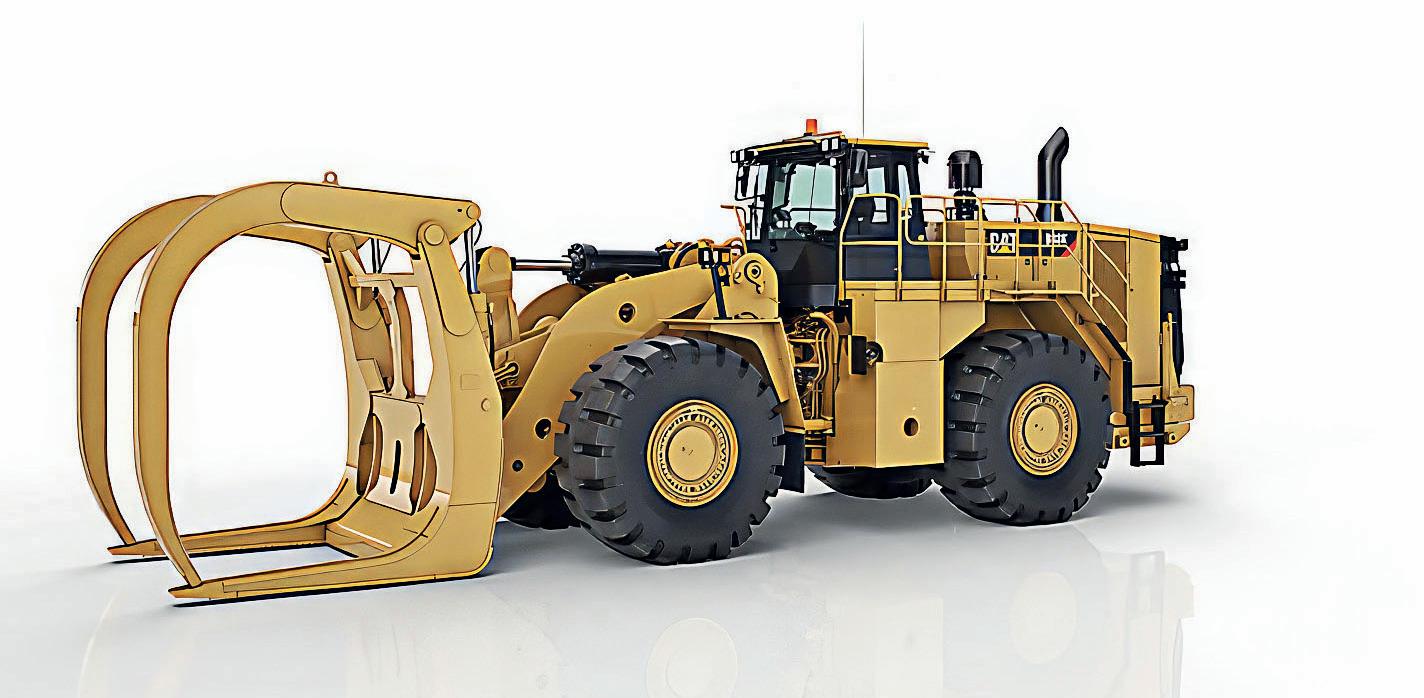
Skidders are an essential piece of equipment used to transport a large number of trees to another location where they can be loaded onto a logging truck.
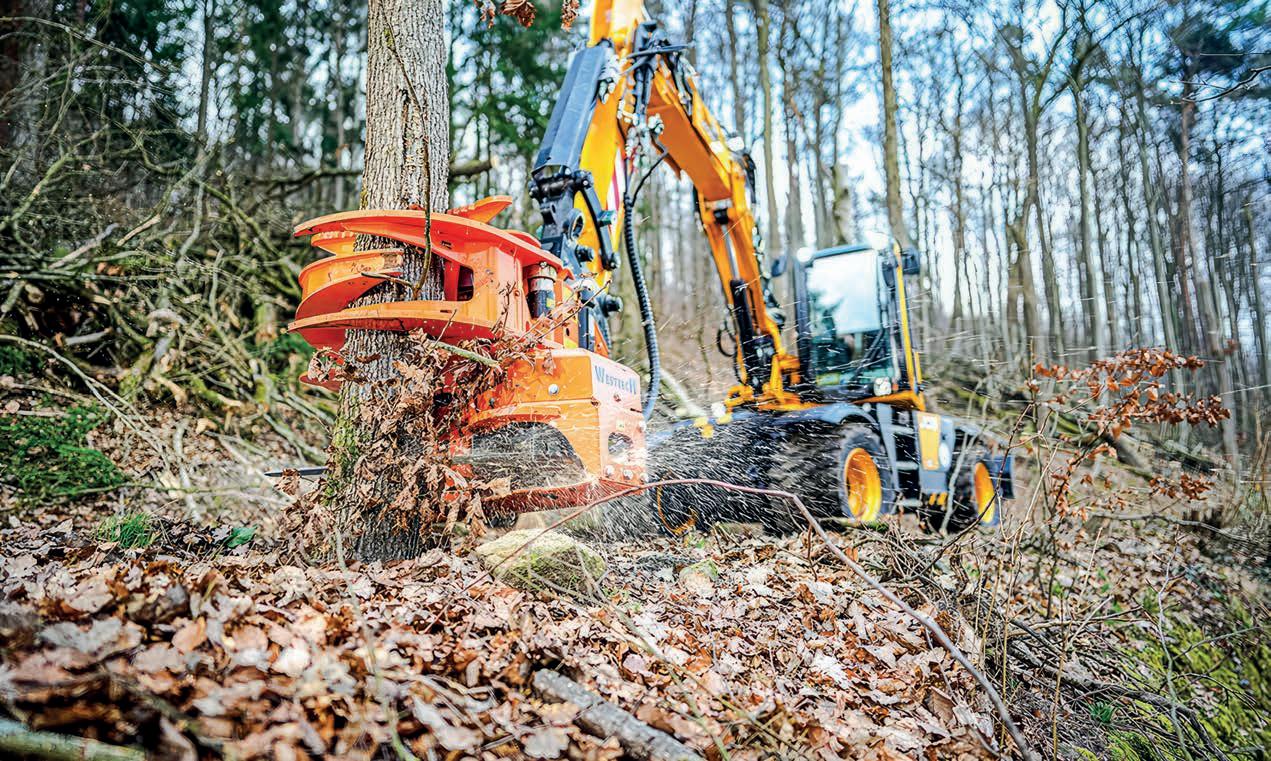
There’s no doubt compact excavators are now commonplace in many tree-care businesses, proven as significant time and effort savers when moving material, feeding chippers or loading logs. But as most will already know, there’s a tipping point when it comes to transport and access challenges once you start exploring the benefits of bigger machines.
If your goal was to put an excavator into tree-facing work – such as removals – rather than handling logs on the ground, what are the suggested options around this tipping point of excavator size versus capability and loghandling on the ground?
“If you could, just go with a 15-tonner,” laughed Rey Kell, Forest Centre Director and Sales Manager, before conceding, “we’re really excited to shift from this stance though, and offer new grapplesaw models made specifically for the eight-ton to 15-ton range of machines.
“Until now, the purpose-built grapple-saw options for this class were extremely limited.”
Woodcracker CS545 compact Westtech Woodcracker’s new CS545 may look familiar, being based on the CS750 Smart already popular with tree-care contractors on slewing telehandlers. It features the same advanced .404" saw unit with automatic chain tensioning, grease-type chain lubrication, and strong, worm-drive rotator. Stems up to 540mm diameter
can be cut with the CS545.
“When the brief calls for an easy install using only two hydraulic circuits, and a work approach that’s more about precision holding when taking picks from the tree, the CS545 would be a great choice,” explained Rey.
The saw unit used in Westtech grapple saws is from Hultdins, Sweden, conveniently a brand also represented in Australia by Forest Centre. Every second tree harvested in the world is cut with a Hultdins SuperCut saw system – a statistic testament to the reliability and market standing behind what may be an otherwise unfamiliar name on an equipment spec sheet.
At the other end of the Woodcracker, the attachment is fixed to the machine via a 360-degree worm-drive rotator. By nature of their design, worm drives have significantly more holding force than turning force.
“From the operator’s seat, when taking your thumb off the rotate controls, an
uneven load in the grapple is held rigid until you actively rotate again in either direction,” explained Rey.
This aspect may be particularly beneficial in specific situations – like when working in tight quarters and training new operators.
There’s a trade-off, however, that excavator operators familiar with tiltrotators may see coming: worm-drive rotators require special attention for both greasing and avoiding damage from rotate-axis overloads.
Westtech cleverly addressed the former when designing its attachments, with an optional rotator auto-greasing system (fitted on all Australian-sold units) providing constant lubrication to the worm gear drive.
Equipped with seven finger jaws, the new Vosch 1510 resembles more of a multipurpose sorting and handling grapple with a robust saw unit bolted to the side.
The 1510 shares the same saw unit as its bigger siblings on 20-ton and 30-ton machines, but with a shorter 33" saw bar
and cutting capacity of up to 600mm.
All Vosch saws use the 3/4"-pitch harvester cutting system.
“This is the heavy-hitting all-rounder” Rey added. “It’s a tough grapple, designed to cover a wider range of work as well as put larger timber down quickly if needed.”
The Vosch rotator houses a conventional slewing drive similar to its forestry cousins. With this design, turning power and capacity to ‘float’ is the emphasis over static holding. When the operator closes the jaws around a trunk section or pushes them into a pile of logs for example, the grapple can align itself.
“At the joysticks it’s a hands-on rather than hands-off approach for rotation,” Rey explained. “After cutting, the operator has immediate feedback for what is needed at the controls to hold a tree section, rotate upwards to vertical, slow its downward tipping, or even put it down quickly.”
Installation-wise, three separate hydraulic work-tool functions are required from the excavator for the 1510;
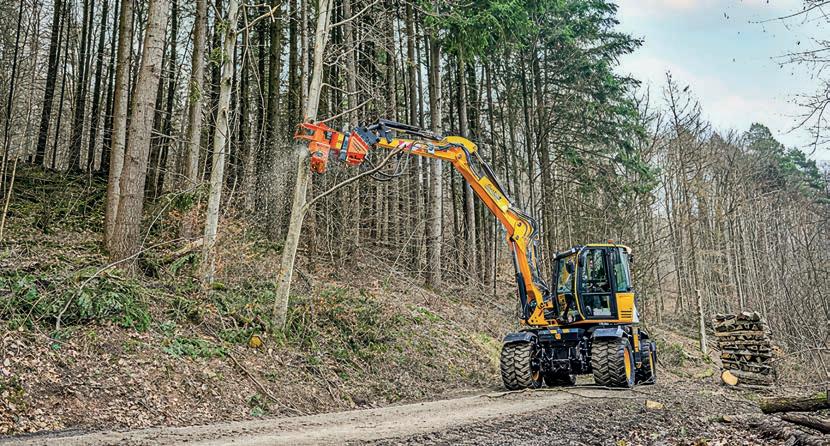
Forest Centre offers new grapple-saw models made specifically for the eightton to 15-ton range of machines.
one each for grapple, rotate and saw. This is a step beyond what’s available on standard excavators, providing fully independent and simultaneous control of all functions if needed.
When venturing into the space of mechanised tree-care works, the stakes can be high.
A work-tool attachment such as a grapple saw or tree shear might represent a small purchase to help ease an occasional workflow bottleneck with existing equipment, right through to a huge investment as part of a new front-
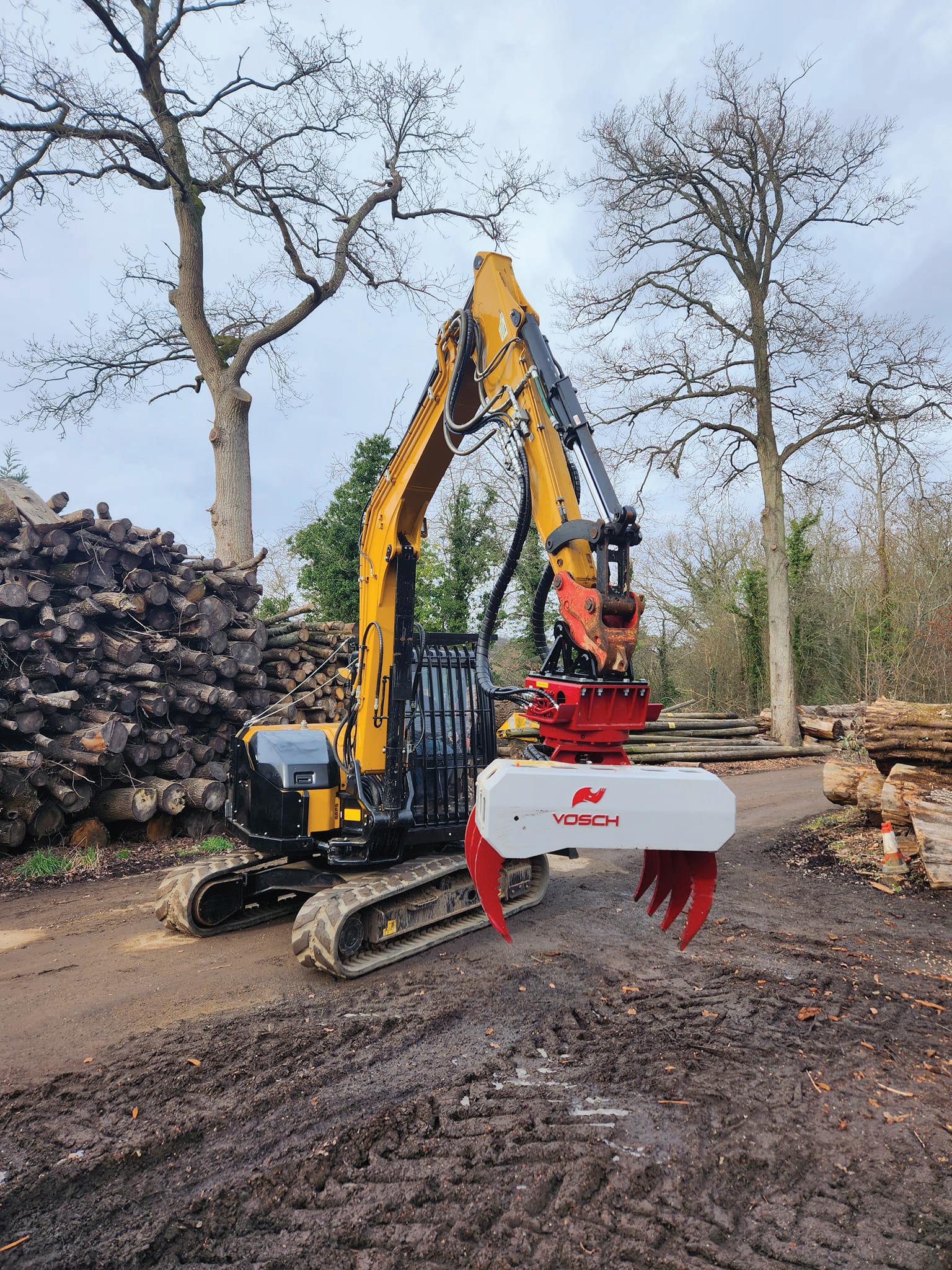

line machine package.
“We’re all learning, all the time,” offered Rey Kell, hinting at the steady upward trajectory of mechanised arb in Australia. “It’s vital we learn as much as possible about the operational needs and limitations from a customer, just the same as we need to educate on these same factors for the equipment options available.”
For more information about treehandling attachment combinations, check out the company’s social channels, visit forestcentre.com.au, or simply give them a call on (02) 6947 2833.
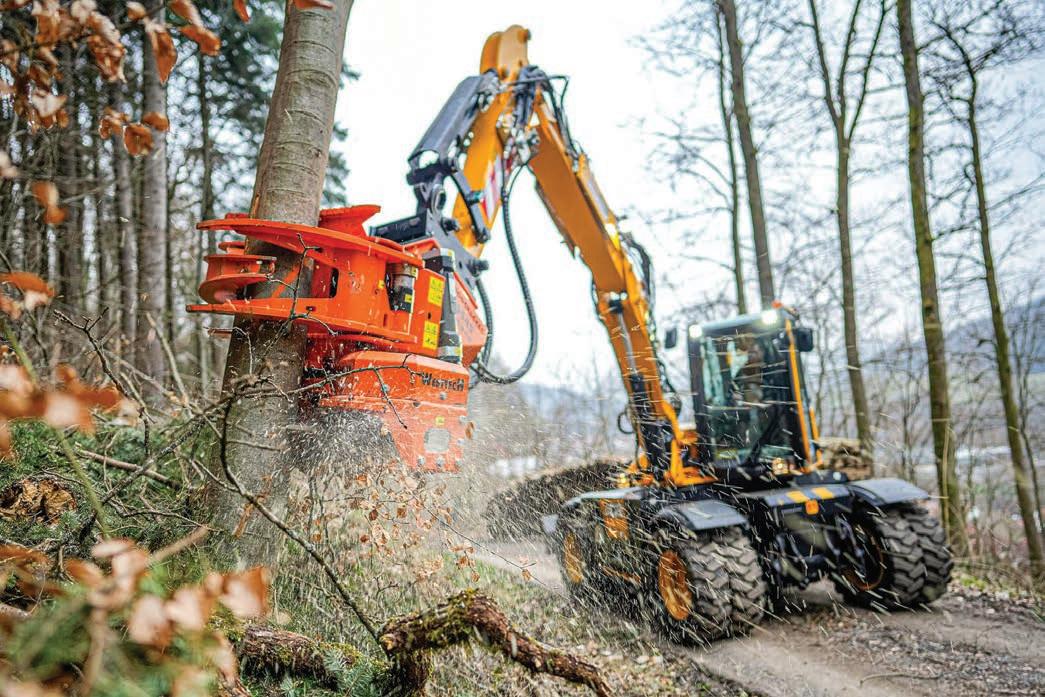
Dominic Osborne of TreeWorks Canberra, in Queanbeyan East, NSW, was over the moon when he heard he’d won the Climbing Harness and six mini carabiners with a total value of $1030.90 in The Australian Arbor Age’s subscription draw. Want to be like Dominic? Sign up for a subscription. You’ll receive six issues no matter what, and you just might win!
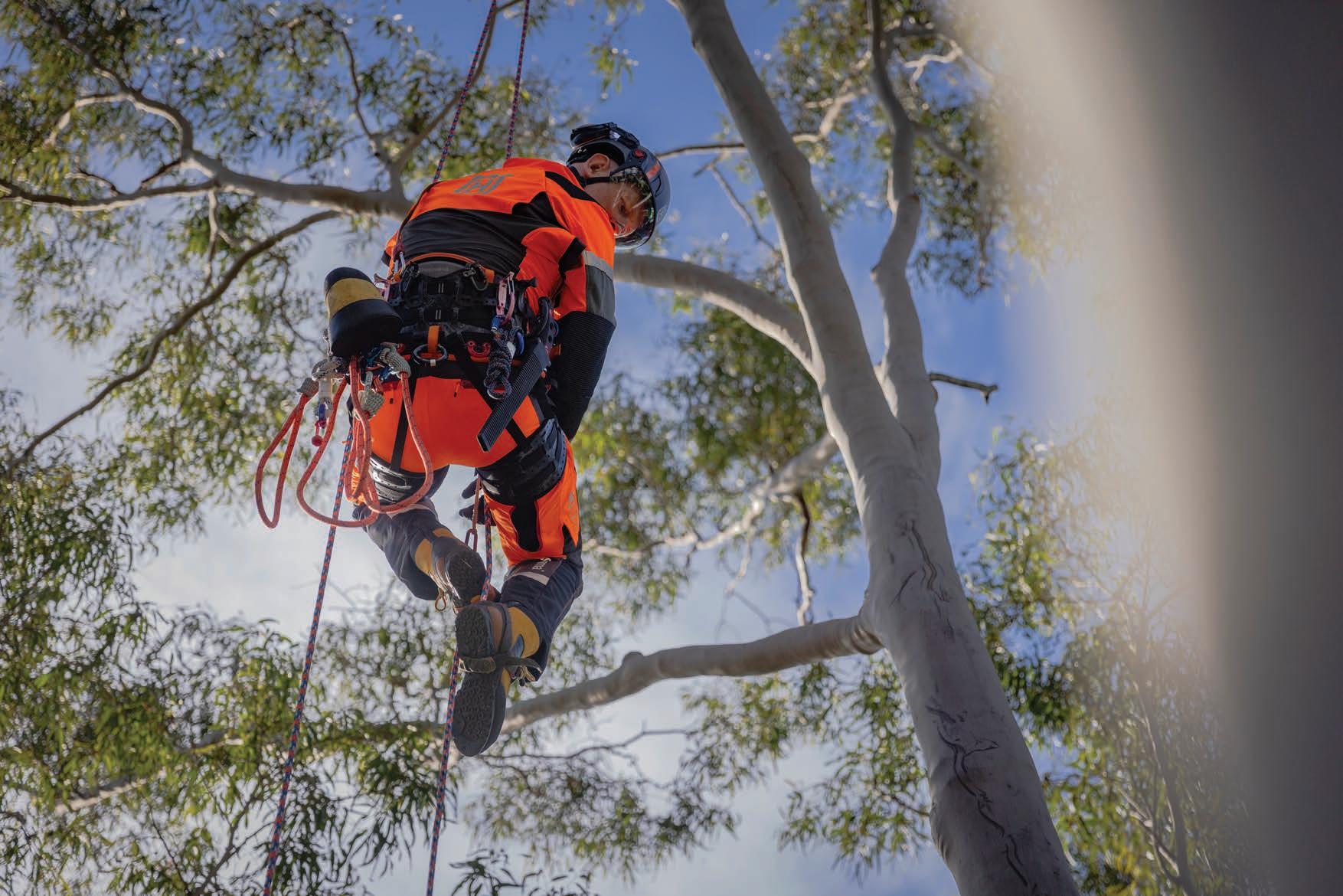
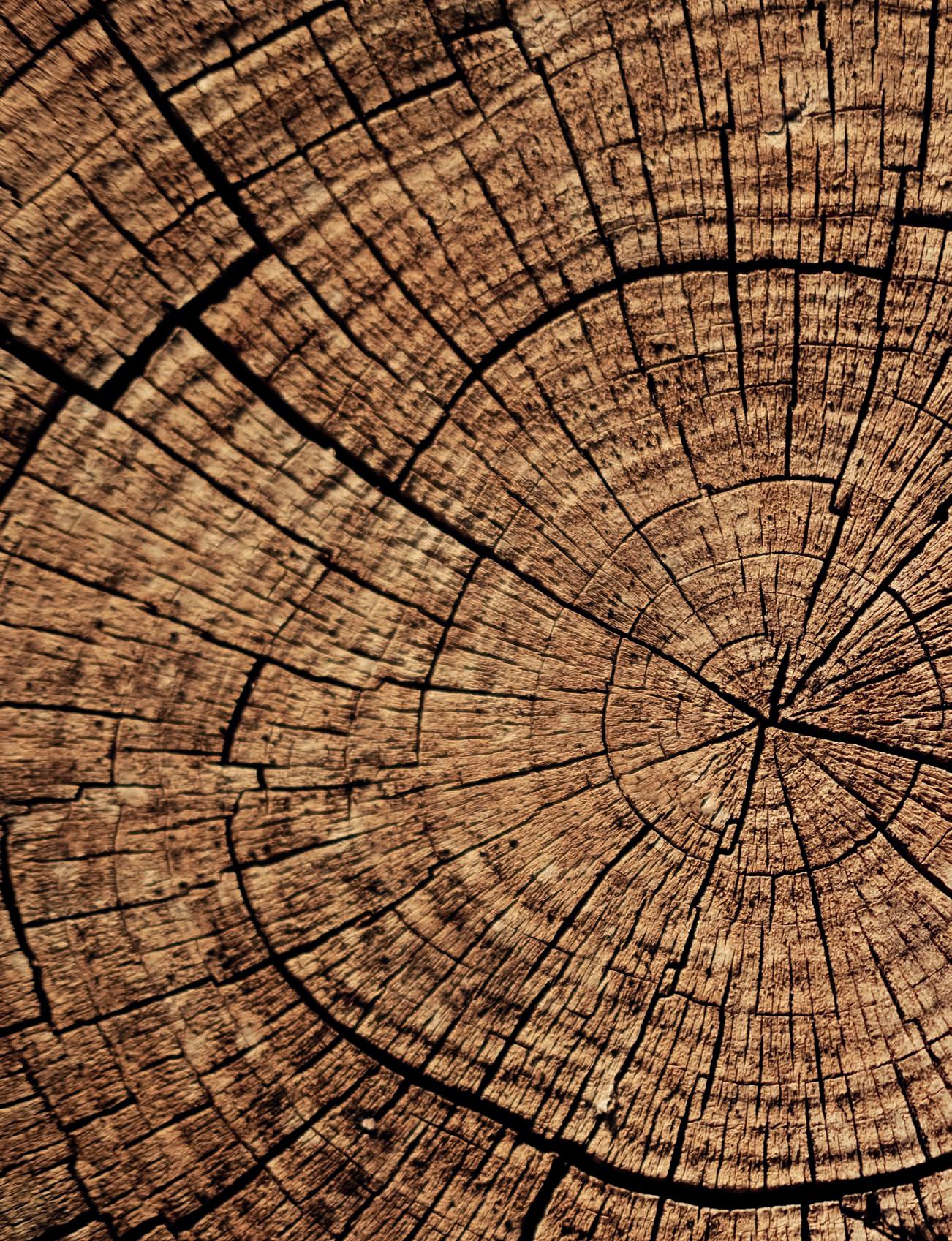
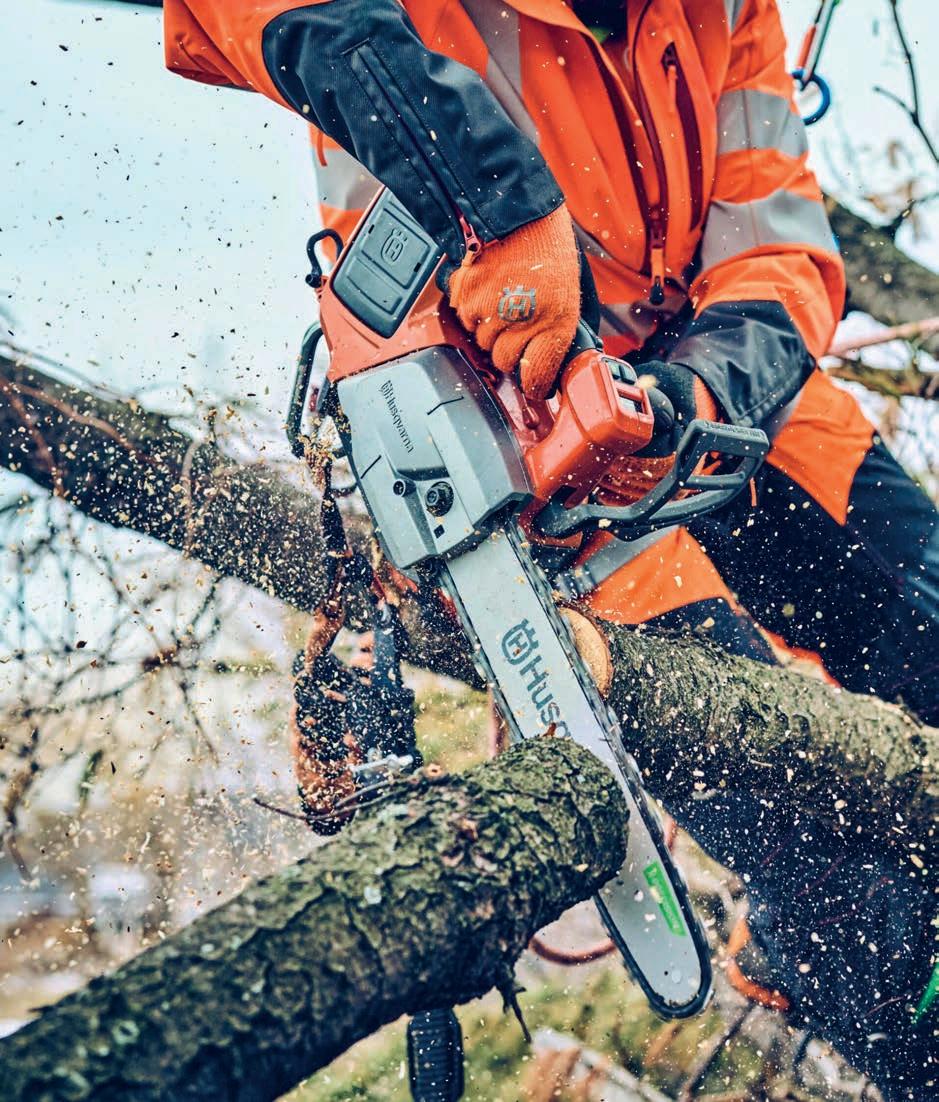
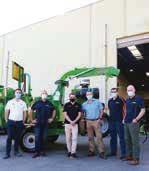


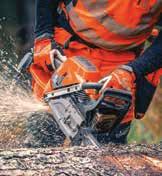
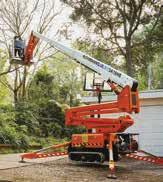




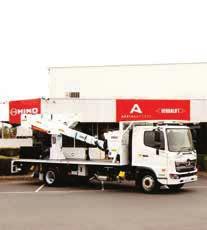

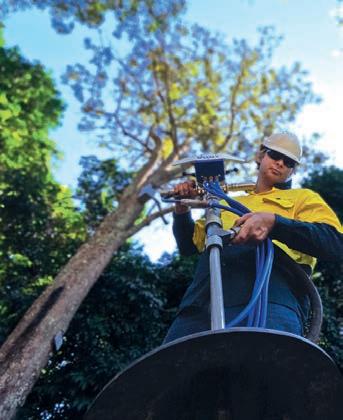

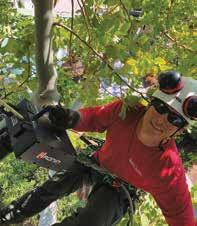

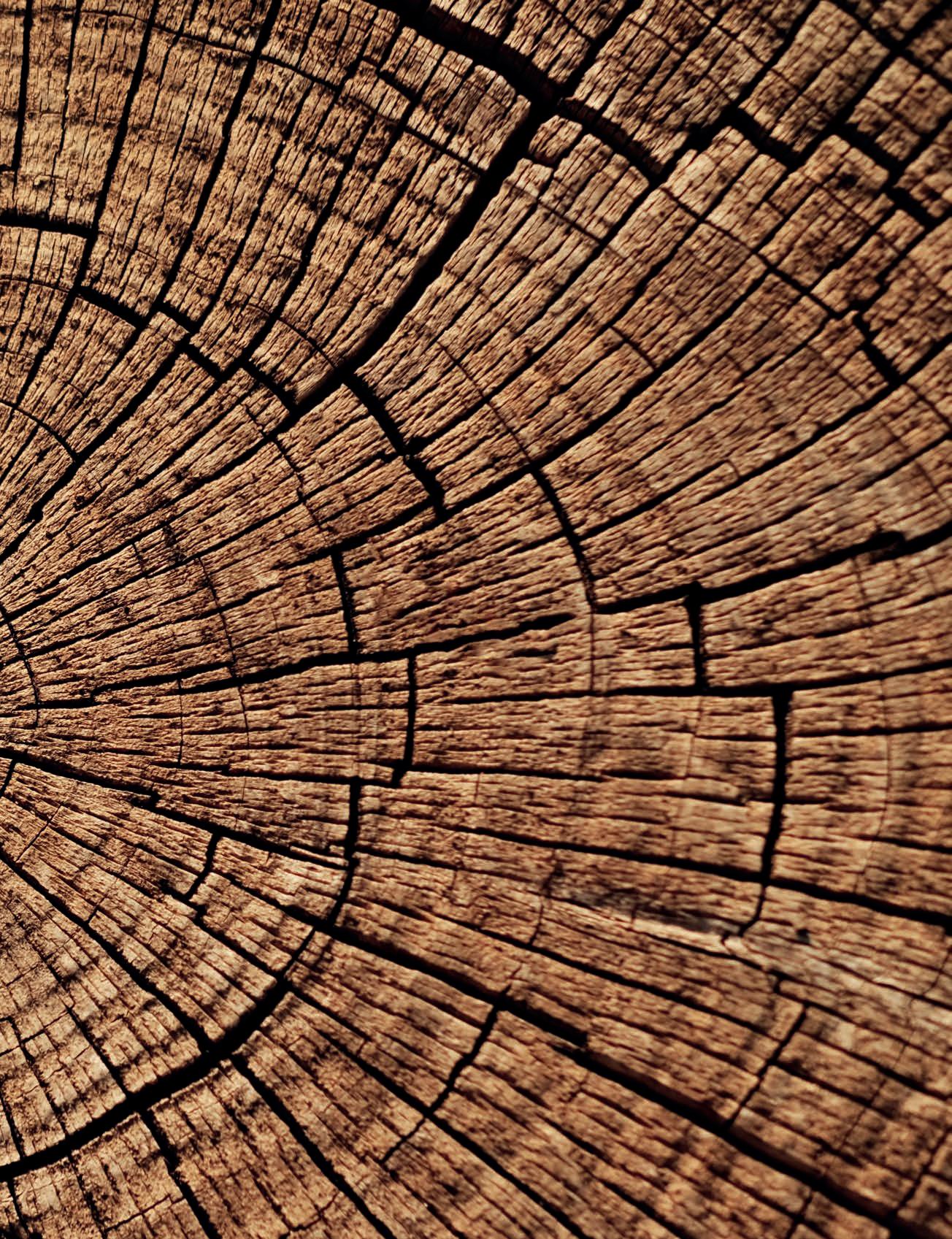
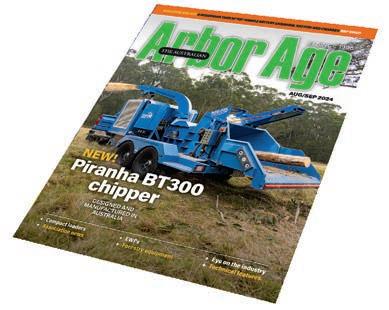


Director TreeStyle Pty Ltd and Husqvarna Australia HTeam Ambassador - Kiah Martin, listened carefully when a colleague told her of his experience with Husqvarna X-COM Active communication headset.
Words: Kiah Martin

Kiah Martin, Husqvarna HTeam Ambassador, found X-COM Active to be a robust, high-tech communication and hearing-protection headset system ideal for arborists and tree care professionals. Image: Husqvarna
Listen up…are you receiving, over?”
“ X-COM Active provides crystal-clear sound clarity. Precision sound quality makes reliable communication effortless.
I’d recently been in contact with New Zealand colleague Chris Walsh, Managing Director of TREETECH Specialist TreeCare, to find out about his company’s purchase of the new Husqvarna X-COM Active communication headsets.
Chris, who is also immediate past-president of the International Society of Arboriculture, has been working in the arb industry for over 30 years, starting as an apprentice in turf management and horticulture. But after meeting a Kiwi arborist who had just returned from working in Australia, Chris quickly moved on to “a cool job” in arboriculture, to “better care for trees as key players in the environment.”
Chris’ company employs between 80-120 staff covering all manner of arb work, including utility clearance, privateand municipal-project work, consultancy jobs, and planting and watering contracts. TREETECH also has a training division, so preparing new staff for work melds beautifully with his passion for climbing trees, caring for trees and educating people. Chris has always been inspired by growth and ways of “…learning to do it better”.
Working in the tree industry since 1993, Chris has seen a lot of change, from the introduction of petrol blowers to the inclusion of high-performance battery chainsaws throughout the company fleet. For the past 12 years, Chris has incorporated professional Husqvarna products into the business and has most recently focused on the inclusion of a game-changing bulk order of Husqvarna’s X-COM Active communication headsets.
I wanted to hear what someone with a large business thought of these new simultaneous communication systems, and who better to ask than Chris? He’s as passionate about the arboriculture industry whether he’s on or off the tools.
Asked what he looked for when selecting professional arboricultural gear and equipment, Chris replied, “You have to have the right tools,” and went on to add that “durability, reliability, price effectiveness, product support, working with good people, and long-term relationships with suppliers” were the key to a good fit. He also said he had nurtured these things through a fruitful and enduring association with Husqvarna.
I asked him what he loved about Husqvarna products.
“Everything! But mostly reliability, innovation and seeing how far we’ve come with all the feedback helping to refine products and move them to industry quickly.”
“A good example is the X-COM Active headsets,” he continued. “They’re a no brainer. I don’t understand an employer who doesn’t buy these. Companies really need to have a think about the health-and-safety and productivity benefits they would get from having this system, and the professionalism that comes from it. These are all really key things.”
“I talk to professional tree companies who tell me they have eight staff, and they can’t afford to buy this system. My response is that they can’t afford not to! Having them is a breakthrough!”

Image: Husqvarna

















High audio quality in noisy working conditions makes for safer and better workflow. Image: TREETECH Specialist TreeCare
I was interested in Chris’ take on how good communication benefits TREETECH teams and did he think this had a flowon effect on productivity?
“Good teamwork comes down to good verbal communication,” Chris pointed out, “whether you’re using a comms set or talking to each other face to face. From fuelling the truck in the morning, chatting with team-mates on the way to the job, to working onsite with the comms units, talking with the team out front and back of a property simultaneously, chatting with the client about job details or talking with the traffic guy – everyone on the channel is up to speed, with less frustration and the whole team is acting professionally.”
“Everything is spoken clearly and softly, and your people are understanding what you’re saying. It reduces the stress. Everyone is in the loop with the X-COM units, and nobody forgets the communication.”
Another benefit Chris mentioned was a communication range of over 400 metres.
“The range is good,” he said. “You can actually bounce off the next person –
that is, if your recipient was 300-400 metres away, they could then be a comms point for the next person a block or so over and relay the message back.”
We discussed that with X-COM units in service, onsite angst around miscommunication or misunderstandings was gone, creating a calmer workplace with better flow. Teams were more professional, with improved communication ultimately resulting in better overall productivity.
Chris started in industry “…when cell phones weren’t in use yet; we went door knocking and did drive-by appointments.”
Over time he’s seen much change where all communication modes have improved. This has meant “more work and a safer environment.” And with X-COM Active MultiPoint Bluetooth® connectivity, Chris now has access to hands-free private phone calls on the job, without losing touch with the team.
So aside from his ‘new favourite’ product – the crystal-clear intercom of the Husqvarna X-COM Active helmet mounts which are a purpose-built design for tree crews and forestry workers – I wanted to know what Chris’ ‘old favourite’ tree-care product was, and I got a very decisive answer: “T540i XP®! No fuel, less noise, no
fumes. Better work!” he said.
Chris remembers the days of always using walkie-talkies with travel towers, cranes, split-team site-clearance work, or even just climbing at height near busy roads. Or worse still, constantly yelling call-and-responses to teammates over the noise of industrial machinery and equipment, and disturbing the clients, neighbours and passers-by.
Two-ways were a great solution for these situations, but could be frustrating to use, especially while working aloft. Now we have communication tools designed specifically for work in our industry, everyday tree work has become more efficient through more effective, realtime communications on both simple and complex projects. No more waiting your turn to communicate with your team or pauses or restrictions on when you can deliver your message. No more frustration around the inability to talk concurrently with separate teams or workers on the same job site. And with the X-COM Active’s ability to enable up to 10 teammates to communicate simultaneously without any delay,
and with high audio quality in noisy work conditions across three private channels, as Chris reiterates again and again, “It’s a game changer!”
From a safety perspective, Chris mentioned that when using the X-COM Active system teams could be avoiding countless near misses.
“When we’re working around grinders or diggers, we can clearly say to the driver, ‘Hey, I’m coming up on your 12 or your six or nine’,” he explained. “They then know where we are.
“And when reversing trucks into driveways, everyone can hear everybody talking directly and calmly, without yelling at each other.”
And with the in-built two-way, noisecancelling boom microphone, “…you can quietly say ‘left-hand down’, ‘watch the data box’ and so forth. So it helps prevent a lot of potential incidents. That is a huge thing for us when using heavy machinery.”
We’ve made do thus far with intercom
options from other markets wrangled into service but not specifically fit-forpurpose. Chris said TREETECH “ran through radios, motorbike kits and other brands, and things were improving, but when they got the Husqvarna X-COM units, they just blew us away.”
Full duplex intercom enables tree workers to have efficient and natural conversations without delays or interruptions, and as with TREETECH’s set-up, there is the added benefit of fully integrated head, eye and ear protection when pairing Husqvarna’s X-COM Active, helmet mounts with a Husqvarna Spire™ Vent Arborist helmet. With this system, Chris’ teams are well on the way to improving their safety outcomes and professional industry presence.
Chris is unsurprisingly stoked to be going forward with the latest technology from Husqvarna and agrees the Husqvarna X-COM Active communication headsets are an invaluable tool for all arboricultural
environments where clear and uninterrupted communication is crucial.
For those new to the industry and looking to work with these powerful communication tools, working with professional arboricultural companies with a focus on safety and sustainability should certainly make it likely these next-generation products will be available to you.
With Chris using and recommending professional Husqvarna products for over a decade, his love of the brand has translated to starting a new Husqvarna dealership, GreenGear Limited, where his belief in the battery vision can now be fully realised.
Thanks Chris, for taking the time to share some of your experience with the readers.
“Message received, over.”
To learn more of Husqvarna X-COM Active, visit husqvarna.com or scan the QR code.
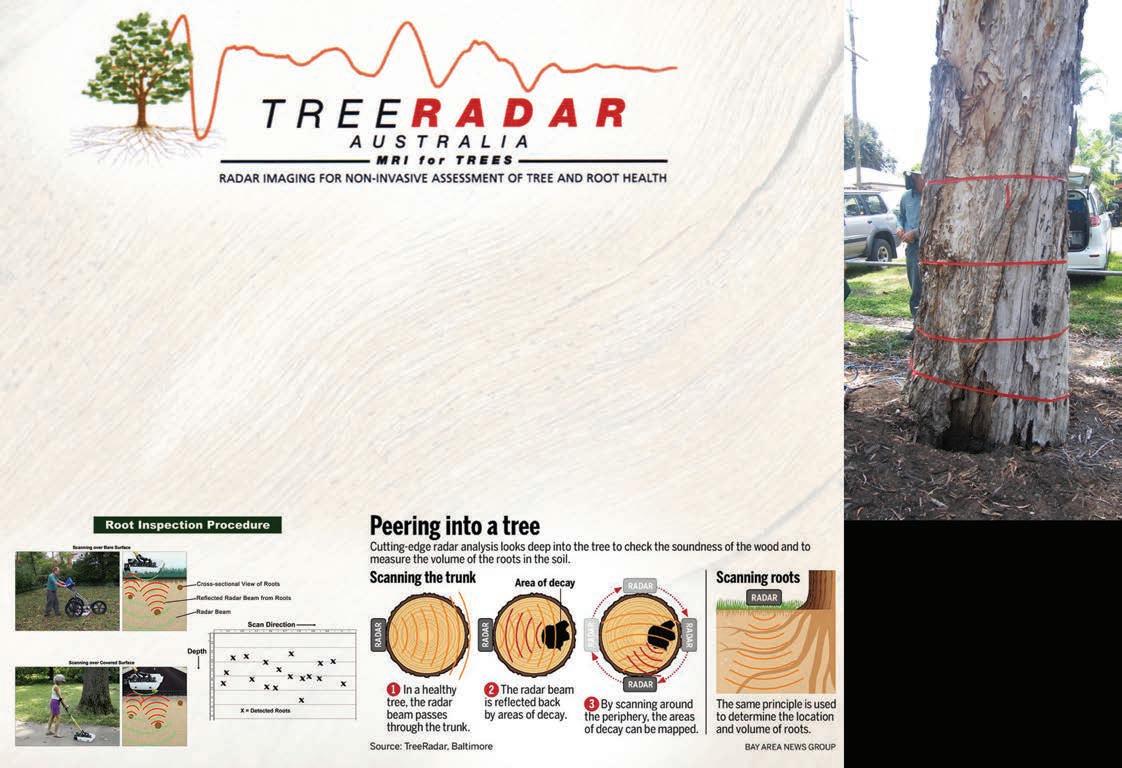
Tree Radar Australia uses a ground penetrating Radar Unit to provide the only, completely non-invasive method of tree decay detection and tree root detection available in Australia.
Tree Decay is a severe problem which can put all the structure around a tree at risk. With Tree Radar Units™ decay detection, Tree Radar can scan for decay in any tree regardless of its height. The Tree Radar unit can give an accurate read out of the severity of decay in a tree without having to penetrate the Tree’s surface.
Tree Radar Unit™ can detect and establish the root proliferation of a tree, this allows the arborist to inform developers of any structural or instability issues without the need for drilling or digging.
A: PO Box 57, Whittlesea Vic 3757
T: (03) 5783 3170
F: (03) 5783 3035
E: mail@treeservices.com.au W: www.treeradaraustralia.com.au
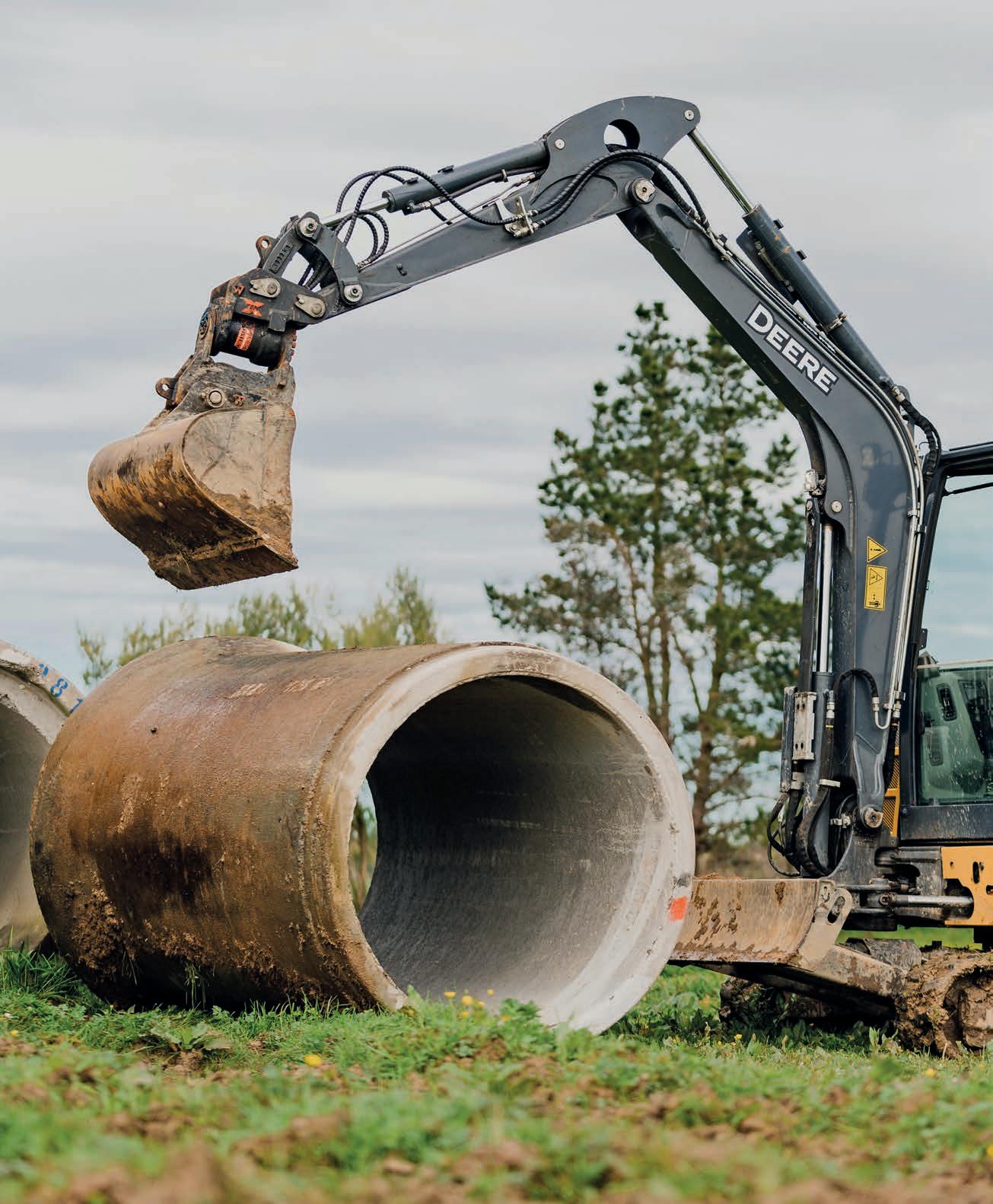

Get the equipment you need when you need it with flexible leases from Brandt.
In the arbor and forestry industries timelines are short and the hours are long.
Efficient, reliable machinery is essential to minimise costly downtime. Staying on top of maintenance costs and investing in the latest technology is crucial. While purchasing new equipment outright every few years might not be feasible for small-scale contractors, leasing offers a practical solution.
Brandt provides various flexible lease options to help advance your operations.
Leasing offers numerous advantages, including lower upfront costs, flexible payments, no asset depreciation, and more. It makes new equipment accessible to businesses with limited capital, preserves capital for other investments, and helps manage cash flow more effectively. Additionally, lease payments are often tax-deductible, providing further savings.
Brandt simplifies the leasing process. You can acquire brand new John Deere equipment at the lowest rates in the industry and enjoy benefits such as:
• Flexible lease contracts and rates –pay less for the equipment you need
• End-of-lease options – return the machine, purchase it, or refinance it at maturity
• Customised plans – align your payments with your cash flow and specific business needs, and
• Inclusive packages – receive the machine, warranty and maintenance, all in one package.
A standout feature of Brandt leases is the opportunity to lease equipment for three years with flexible terms. If your operation requires more hours during
peak seasons and fewer during offseasons, Brandt’s flexible terms ensure you pay only for what you need, making it a cost-effective option.
Comprehensive warranty and full maintenance are included throughout the lease term, minimising potential downtime due to mechanical issues. This keeps your operation running smoothly and provides peace of mind, knowing equipment is in top working condition during critical periods.
Focus on your work without the worry of high repair or replacement costs.
At the end of the lease period, you can continue to enjoy the benefits.
You have the option to return the leased equipment and switch to a new model, eliminating the financial burden and operational disruptions associated with aging equipment. With each new lease, you start fresh with the latest John Deere technology and innovations, ensuring your operations remain at the cutting edge.
Brandt’s leasing options are ideal for landscapers seeking reliable, flexible, and cost-effective equipment solutions. With customisable lease terms, comprehensive maintenance and warranty coverage, and the ability to upgrade to new equipment every three years, Brandt stands out as a leader in the field. For those looking to maximise operational efficiency while minimising costs and downtime, leasing from Brandt is the perfect choice.
For more information on the Brandt leasing program, visit your local Brandt dealership or check out the website at brandt.ca/au.

There’s nothing tougher than trying to work with inferior or incorrect tools. STIHL knows what tree-care professionals need, and, along with a great range or purposebuilt tools, has a few key accessories to help make tree and forestry work easier.
Whether it’s simpler chainsaw maintenance, quicker cutting time or clearer communication with your team, these genuine STIHL accessories are must-haves for arbor professionals.
Want to give your forestry chainsaw a new lease of life? Then look no further than STIHL’s Hexa upgrade kits or new Hexa chain loops and file.
The new STIHL Hexa chain has a hexagonal (instead of round) cutting shape and gives 10 per cent faster cutting performance and simpler sharpening. And because the angle of the cutter is less acute, it holds its edge for longer too.
Hexa chain loops can be bought separately, but the kits with the file and two Hexa chains are better value than buying all the items separately.

STIHL ADVANCE ProCOM, the company’s smartest hearing to date, connects up to 16 users across vast distances with market-leading technology that makes communication simple. Simply turn the ProCOM headsets on and they automatically connect together.
Each headset can then be up to 600m apart, as they each operate as a signal repeater. STIHL ProCOM headsets can connect to another device, such as a
phone or walkie talkie, via Bluetooth and have a built-in ambient mode. Just turn ambient mode on and you can hear the outside world as if you didn’t have ear defenders on. When a chainsaw revs up nearby, they then automatically stop playing the sounds from the outside world into your ears, except your colleague’s voices from other ProCOM sets, so you can communicate without interruption knowing your ears are properly protected too.
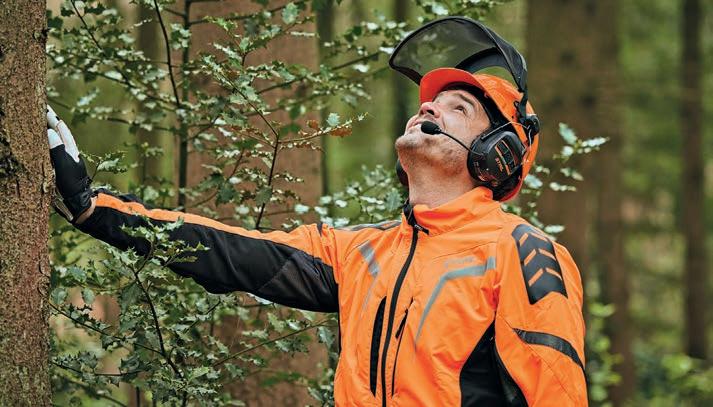

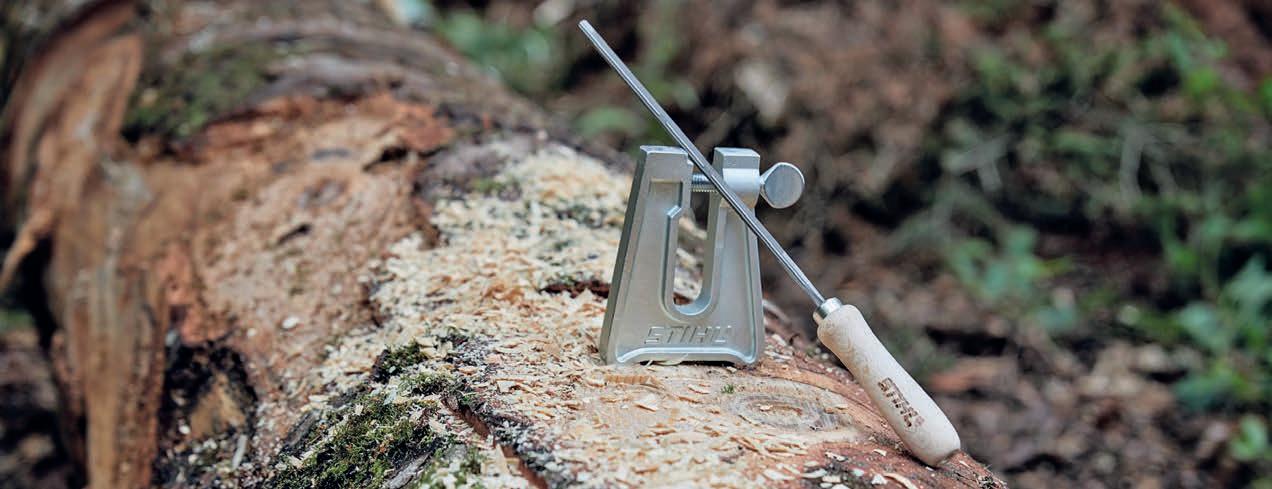
Simple but effective, STIHL’s handy stump vice is ideal to help sharpen your chainsaw chain in the forest or on a job. Simply tap the vice into a stump and secure the bar in it. It will hold the chainsaw bar firm so you can sharpen the chain without the chainsaw moving around.
Why not make sharpening your chainsaw chain even simpler?
While more experienced chainsaw users may prefer to use a manual file and depth gauge, STIHL’s 2-in-1 file sharpens the cutting tooth and files down to the depth gauge at the same time, shortening sharpening times and making sure it’s filed to the correct 30-degree angles for the standard chainsaw chain.
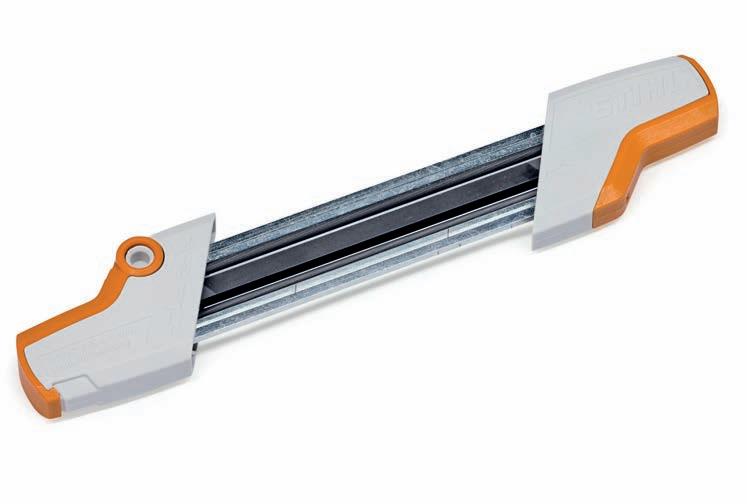
to make lifting and dragging timber much simpler.
Moving timber can be one of the toughest parts of the job, so tools like STIHL’s hand lifting tongs are a great option! They grab the timber so you just have to focus on pulling up, rather than grappling with the log and getting underneath it.
The STIHL drag hook does exactly what it sounds like it should – simply hook the sharp end into the timber and you can manoeuvre or drag it to where it needs to be.
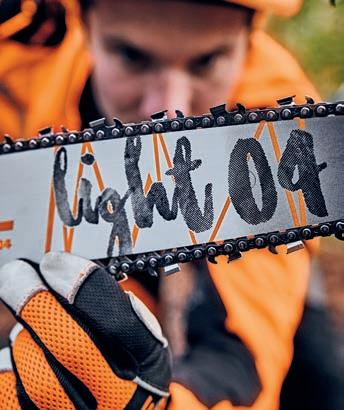
The STIHL Light 04, .325", 1.3mm lightweight guide bar features a special, slim design that enhances piercing characteristics and reduces weight. This makes demanding work more comfortable and enables greater endurance during sawing. The STIHL Light 04, .325", 1.3mm is 200gm lighter than the existing STIHL guide bars, contributing to an improved system weight.
The innovative design of the STIHL Light 04 guide bar is not only attractive but also integrates practical information about the bar’s characteristics – making finding the right saw chain for the chainsaw bar easy, for example.
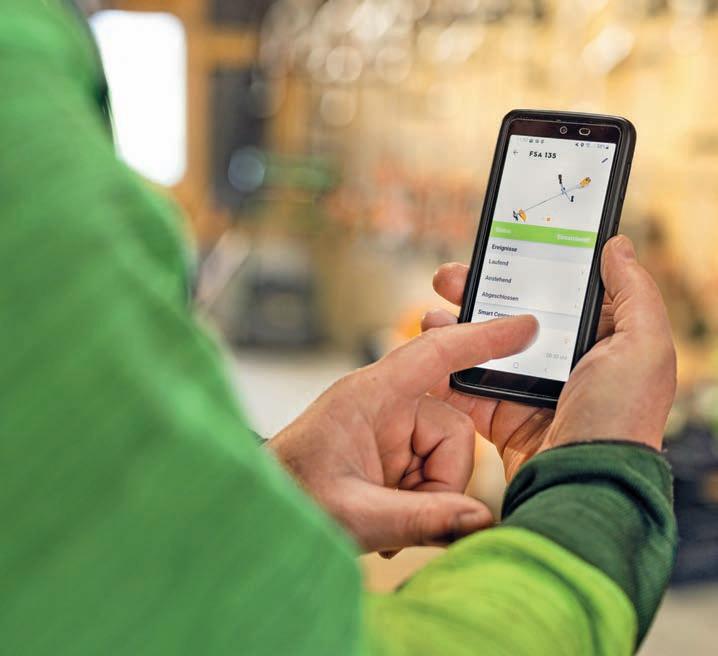
Keeping on top of maintenance of a tool fleet can be much simpler with STIHL Connected.
This fleet-management system logs hours on the tool so it lets you know when maintenance is due. It can even be used on non-STIHL tools where you simply add in a service schedule you want to stick to. It’s really simple to set up, helps keep an eye on your entire fleet in a matter of seconds, tells you when tools are in and out of service, allows you to book a service with your nearest or preferred dealer and keeps a full record of all your fleet maintenance.
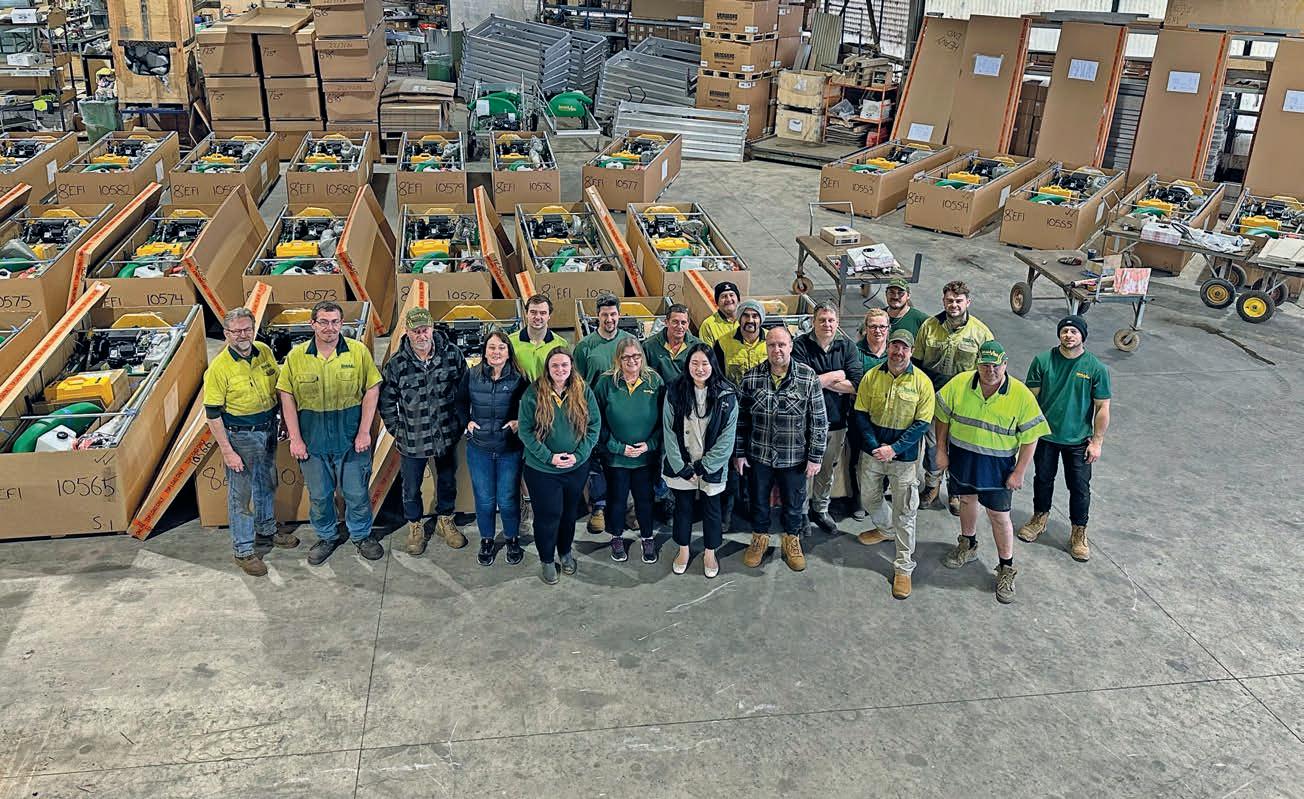
Lucas Mill’s largest individual order to date marked a new milestone for the team.
The Solomon Islands receives 67 portable
In April of 2023, Lucas Mill was made aware of an upcoming tender for the Japanese Government to procure equipment to be supplied to developing countries. With the Sirius Corporation of Japan and agent Farmset, Solomon Islands, Lucas Mill was successful in the bidding and awarded the tender in June of 2024.
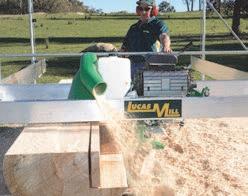

After much negotiation the terms were settled and Lucas Mill had successfully won the tender to supply 67 Model 8 circular swing-blade portable sawmills to the Ministry of Forestry & Research in the Solomon Islands.
An order of that size was Lucas Mill’s largest individual order to date, marking a new milestone for the team.
Since 1994 there have been approximately 1300 Lucas Mill sawmills in service in the Solomon Islands, so it was no surprise Lucas Mill was a great fit for the brief. Due to the market demands of the region, the portable nature and affordability of the Model 8 has seen a thriving market.
Other similar markets in Papua New Guinea and the Pacific Islands have also flourished, particularly in the sale of the very reliable and successful Lucas Mill Model 6 and Model 8 machines.
At the end of August, the team saw the fruition of this project with the packing of three 40-foot containers destined for Honiara in mid-September.
Learn more of Lucas Mill at lucasmill.com.

The positive user experience extends to the overall satisfaction with the tool’s performance and longevity.
In the world of arboriculture, where precision and efficiency are paramount, the tools arborists choose can make a significant difference in their daily work. Among these tools, Silky Saws have earned a stellar reputation and a loyal following.
One of the primary reasons arborists favour Silky Saws is their exceptional cutting performance.
Silky Saws are renowned for their sharp, durable blades that deliver smooth, effortless cuts. This is largely due to their precision-engineered teeth and advanced manufacturing processes. The saws use a unique combination of high-carbon steel and precise tooth configurations to ensure each cut is clean and efficient. Arborists appreciate how these saws make quick work of pruning branches and cutting through tough wood, saving time and reducing physical strain.
Silky Saws are built to withstand the rigors of heavy use in challenging environments.
The brand’s commitment to quality is evident in the robust materials and meticulous craftsmanship that go into each saw. High-quality steel used in the blades not only ensures sharpness, but contributes to the saw’s longevity, while ergonomic handles are designed for comfort and control, reducing fatigue during prolonged use.
Arborists value this durability as it translates to fewer tool replacements and lower long-term costs.
Silky Saws are designed with a range of innovative features that enhance their
usability. For example, many models come with a non-slip grip handle, which provides a secure hold even in wet or slippery conditions. The saws also often include features like foldable blades for easy storage and transport, as well as replaceable blades, which means that instead of replacing the entire saw, arborists can simply swap out a worn blade.
These thoughtful design elements contribute to the saws’ functionality and convenience.
Silky Saws are versatile tools that cater to a wide range of cutting needs.
Whether an arborist is tackling a delicate pruning job or a more demanding task like removing larger branches, there is a Silky Saw model suited for the job. The brand offers a variety of saws with different blade lengths and tooth configurations, allowing arborists to choose the best tool for each specific task. This versatility means arborists can rely on Silky Saws for a broad spectrum of applications, from tree maintenance to construction projects.
The feedback from arborists who use Silky Saws is overwhelmingly positive. Many professionals highlight the saws’ ease of use, efficiency, and the quality of the cut as standout features. The positive user experience extends to the overall

Arborists appreciate how Silky Saws make quick work of pruning branches and cutting through tough wood. Images: ATC Products
satisfaction with the tool’s performance and longevity. This word-of-mouth endorsement contributes significantly to the brand’s reputation and the growing preference for Silky Saws among arborists.
Silky Saws have earned global recognition and trust, which is a testament to their quality and performance. Arborists around the world appreciate the brand’s commitment to excellence and innovation. The global presence of Silky Saws is a reflection of their universal appeal and the high standards they maintain.
Silky Saws have become a beloved tool among arborists due to their superior cutting performance, durability, innovative design, versatility, and the positive experiences of users. As arborists continue to seek out the best tools to enhance their work, Silky Saws stand out as a top choice for professionals who value efficiency and quality in their craft.
For more information call 0418 231 549 or visit atcproducts.com.au.
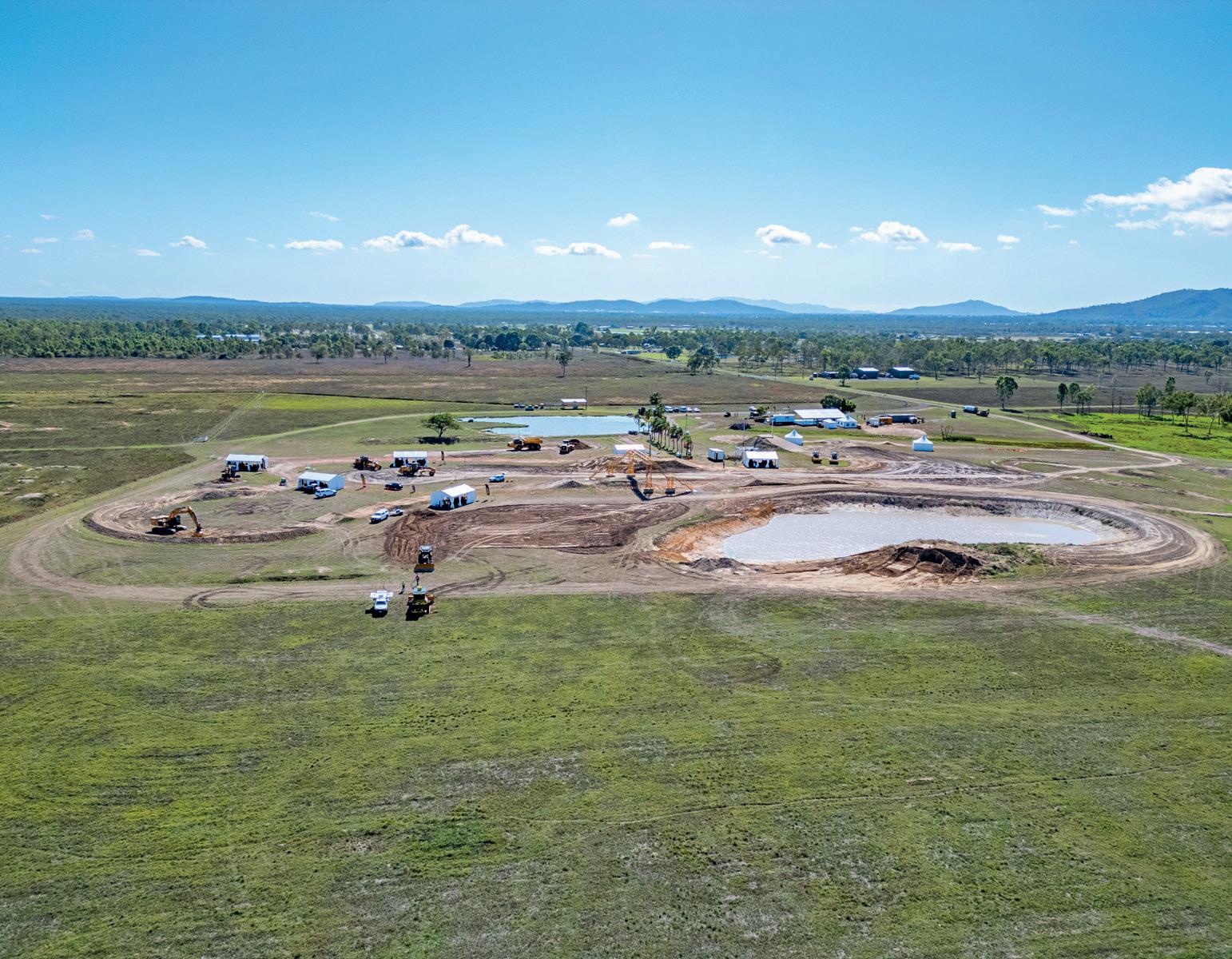
Hastings Deering’s Smart Iron Training Event helped operators understand new technologies and hone their skills on Cat machines.
Cat® machines are renowned for their innovation and efficiency which constantly keep them ahead of competitors. But with technological improvements advancing at a furious rate, sometimes keeping up with the latest developments can be difficult. Hastings Deering is one of the leading Cat dealers globally, with exclusive distribution rights for the sale of Cat equipment, technology solutions, parts and service in Queensland, the Northern Territory, Papua New Guinea, and the Solomon Islands. When the company organised a three-day Smart Iron Training Program, hosted by Diamond Excavators at its property in Townsville, it drew participants and visitors from both Queensland and the Northern Territory.
Education and advancement
Seb Banks, Executive General Manager, Construction Industries, Hastings Deering, was delighted with the success of the Smart Iron Training Program.
“This three-day event was conceived when I was talking with Shane Poole from Diamond Excavators and his wife Kylie last year,” he said. “Shane lives and breathes Caterpillar, and knows we have some of the best technology on the Cat machines. He said it was important to understand and learn about the technology as soon as customers bought the machines, but he also said that after a while, operators can lose some of that knowledge, so it would be really useful if we could run a sort of regular training seminar: get all the operators from the local regions coming in, learn how to


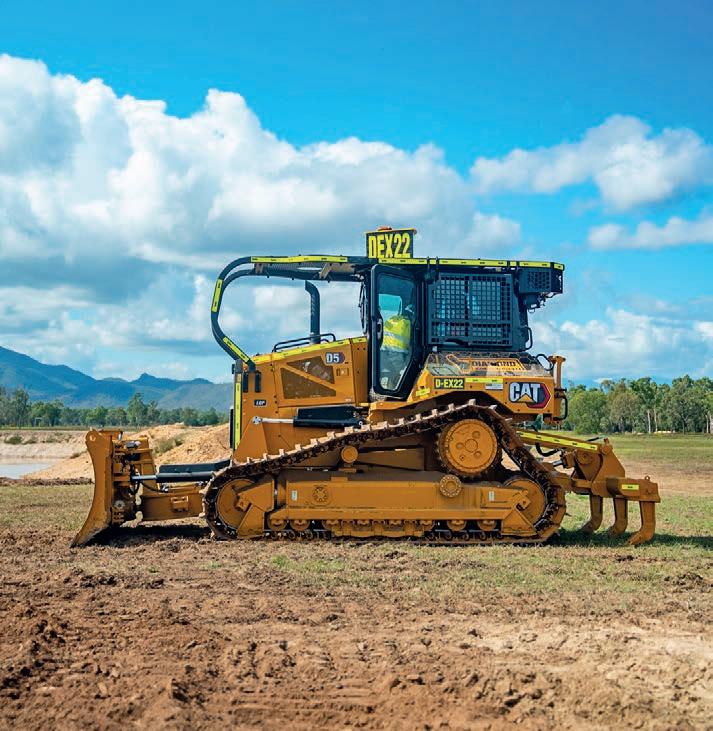
Operators were able to see live demonstrations of inside the
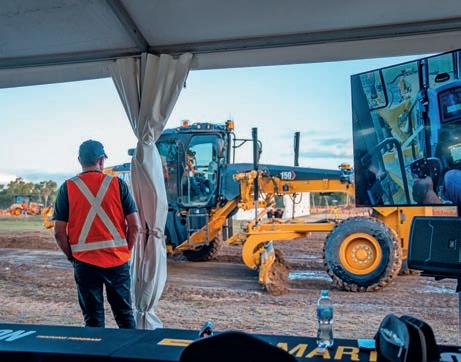
use the machines, learn the technology again.”
“We flew customers in from Brisbane, from Cairns, and locals from Townsville, giving them an opportunity to try each one of our machines and learn how to use them properly,” Seb explained, “And in the end, although the technology is fantastic, without the people operating machines correctly, running them and making sure they are at full operational capability, the technology is not worth it, right?”
The sessions focused on educating customers on the most advanced equipment in the industry, and tailoring education around theory, demonstration-based training, and machine-based training.
It also included sessions in which participants could demo the machines, test their skills and compete in an operator challenge. At the completion of the training, participants received copies of all training materials, as well as exclusive access to Caterpillar and Hastings Deering product experts.
Ryan Canal, Construction Industries Technology Product manager, Hastings Deering, took Smart Iron Training Program attendees through the updated and latest technology, and was impressed with the turnout at the event.
“It’s such a community effort from everyone here in Townsville. It’s awesome to see the way we’ve managed to pull this together in collaboration with customers,” he said.
“We should all be pretty proud of what we’ve done here.”
To see more of Hastings Deering, log on to hastingsdeering.com.au. To see the Cat range, go to cat.com.
Energy was high as all learnt and practised new skills, with eight women preparing to enter the ACT competition the next day. Image: Mona Bruckhoff
The Women in Arboriculture Climbing Workshop ran the day before the ACT Tree Climbing Competition in May of this year. Tyla Bickley was there.
Words: Tyla Bickley
Canberra was putting on its best display of early winter fog as almost 20 women gathered early in the morning for the Women in Arboriculture Climbing Workshop, supported by Arboriculture Australia and run by local business, Treasure Trees. As those that had travelled from Victoria and NSW mentally confirmed their preconceptions of Canberra, locals hurried to assure everyone that morning fog meant a beautiful, sunny day to come.
There were many familiar faces in the group. This was the fourth event to be held between Victoria and Canberra since 2022, organised by women for women in the industry. Samantha Burkingshaw, who organised the
first event in Geelong, travelled from Melbourne to be one of the volunteer mentors for the weekend, along with Alana Murray, current Australian tree-climbing champion and ranked fourth in the world, and Isobel Watson, ranked second in Australia. Canberra’s very own Maja Blasch, twice Australian champ and previous Asia-Pacific champ, rounded out the mentoring team.
The day began with demonstrations from the stars of each of the five events that comprise a tree climbing competition: aerial rescue, throwlining, open ascent, speed climb and work climb. Competitors were taken through the scoresheets and rule book before splitting into groups and practising each event.
Husqvarna continued its support for the arboriculture industry, kitting out each participant with welcome bags stocked with necessities like insulated bottles and caps. As the sun did indeed come out, the day warmed up and everyone enjoyed a picnic lunch among the yellow boxes from Queer Food before getting back in the trees. With one-on-one mentoring, some participants donned a harness for the first time and were later seen walking way out on limbs and practicing swinging from station to station. Others nutted out some of the peculiarities of competition climbing and scoring.
The energy was high as we all learnt and practised new skills, with eight women

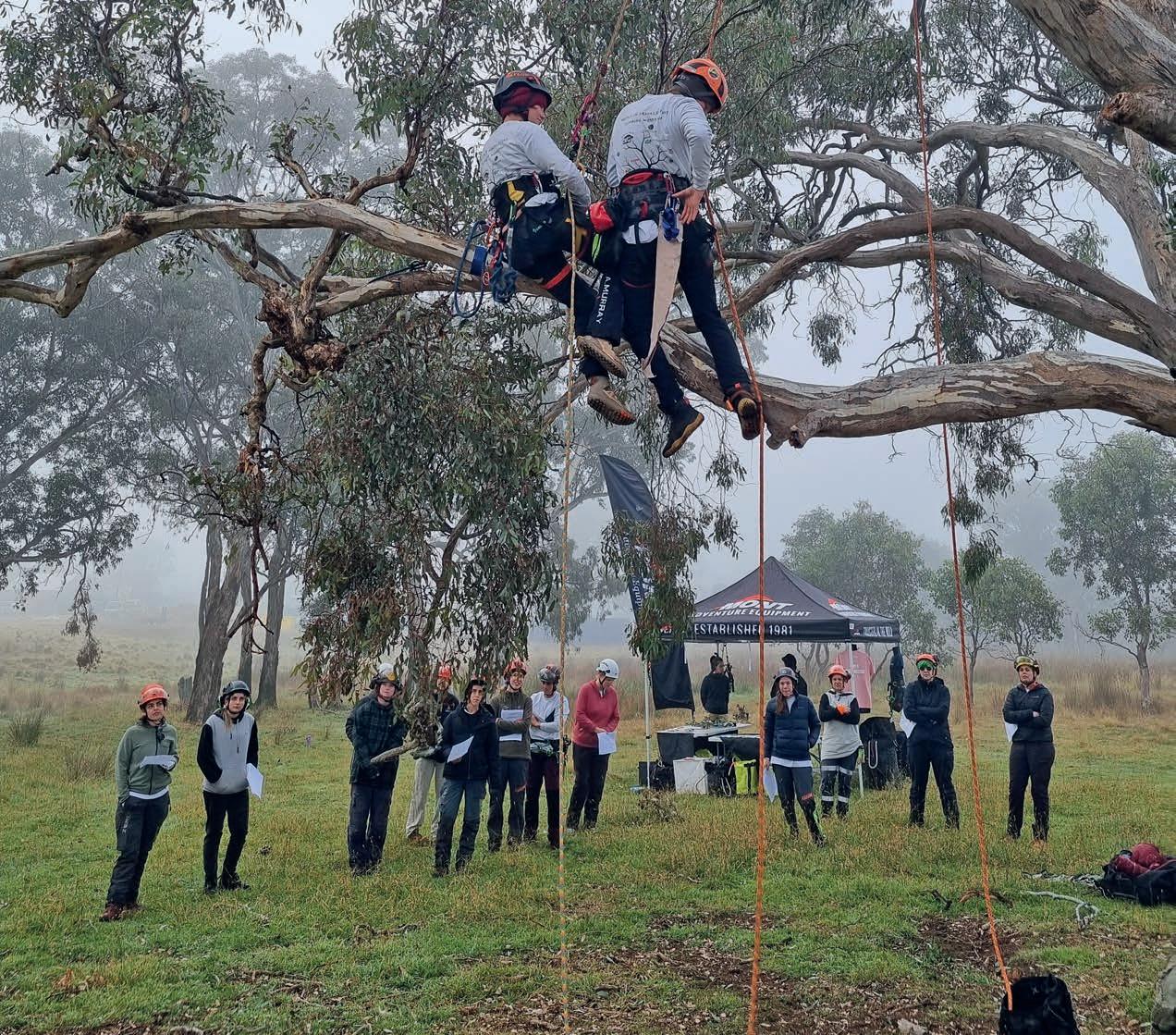
Excellent Traction For Better Grip On Uneven Terrain
Supporting The Australian Arbor Industry For Over 20 Years

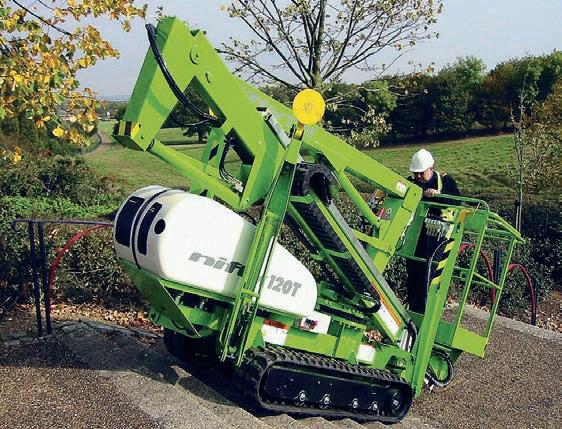
Working height: 12.2m (40ft)
Working outreach: 6.1m (20ft)
Climbs inclines up to 60% (31°)
Simple to operate, reliable and easy to maintain
Fully-proportional hydraulic controls
Low-weight design for transportation by trailer
Local support teams
Built and designed in UK

preparing to enter the ACT competition being held the next day.
Thanks to sponsors Arboriculture Australia, ACTC, Timbertops Tree works and Carotel Motel, we were able to provide accommodation and food for all participants for the duration of the weekend at a very low cost. This felt really important as it recognised the travel time and costs participants were footing to be able to participate in a career-benefitting workshop.
Back at the accommodation, we debriefed the day over dinner and filled out the gear-check forms for the competitors before turning in for an early night before the comp.
Husqvarna and Clogger generously donated some awesome gifts to the workshop, and these were awarded to those who had shown outstanding enthusiasm and determination.
Competition day brought fierce cold winds that even the staunchest Canberrans couldn’t sugar coat, as competitors gathered at Weston Park. It was exciting to see eight women on the run sheet for the comp, a 400% increase from 2023’s ACT comp.
After the first day of competition, we enjoyed dinner with the broader competition field at the Croatian
club, thanks to local company and big supporter of the workshop, TimberTops Tree Works.
Despite the weather, the competition weekend was enjoyed by all. Some firsttime competition climbers really put their skills from the workshop into practice, coming away with top overall places in the throwline and aerial-rescue events. Others from the workshop put in a huge effort over the two days, volunteering in a judging or time-scoring capacity.
Events like these workshops, and the supportive and friendly community they foster, are a real highlight of the industry. In such a male-dominated environment it’s amazing to connect with and learn from other women. We’re lucky recipients of the work done by women in the industry before our time, and having industry organisations and businesses support the event shows a real commitment to the progression of our industry. Genderdiverse representation has been a slow growth, particularly in the competition space, but when you have comp days like this, the potential of turning up at any competition in the future and naturally having a more equally diverse competition field doesn’t seem like it’s all that far away.










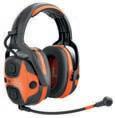




Cassian Humphreys offers more excerpts from The Enlightened Gardener, continuing the story from the June/July 2024 issue…
With scratches in the sand Captain Fergus ‘Gus’ Johnstone kept up his tree story with Major Churchill.
“On top of this, multiple rays of cell tissue run through the cell walls.
“These rays help bind the increments together as well as act as pathways of cellular communication from the outer ring of dynamic tissue called the cambium layer. In a human-sense this is the heart/brain of the tree,” said Gus, drawing rays through his concentric circles until he’d drawn a dartboard in the sand. “What’s more, it’s true to say – well, perhaps in tree terms – that the cambium layer acts as a weighing scale determining load-bearing stress and triggering growth of new cells adapted to that most recent load.”
Breathing deeply again he continued: “The self-imposed growth stresses of the tree exert force through the rays, applying pressure against the increments, against the grain, binding them more tightly together. With stresses also exerted longitudinally through the cellulose in the stacked cells, and with tangential compressive stress against the lignin cell wall, mitigating crack formation along the tips of the wood rays or through the grain.”
Fergus breathed deeply with the exertion of seeing, feeling, and speaking the vision of the inner world of the tree.
“This kind of core strength of the woody plant is activated against crack formation. It’s not so dissimilar to
human core-strength activation of the coccyx to abdomen to prevent muscular strains. Ring or ray cracking caused by the loss of growth stresses in trees occurs once trees are either dead or felled. Although, poor health causes tree failure prematurely.”
Pointing to the outer ring he said, “The cambium, as a meristem or growing point, grows the new wood on the inside and food- or energyconducting tissues called the phloem, on the outside. The phloem is located between this dynamic layer and the sapwood. The cambium and phloem is located just inside the outer bark of the tree.
“Though in cross section it looks ‘thin’, it’s a veneer that coats the whole body of the tree, and its overall surface area is the heart and brain of the living tree, often called the inner bark.”
Gus paused for the moment and pointed with his stick.
“The phloem translocates organic compounds in solution produced by photosynthesis in the leaves. This is used as energy around the whole body of the outermost tree and into the wood through the wood rays. To be used to fire the tree’s many processes, including defense, the wood is protected from the inner/ outer environment via the activation of resistance zones that inhibit the spread of wood-decay-causing organisms. The organic compounds are also stored in the wood and roots, to be used in lean times for ‘system’ support. Severance
of this outer ring causes trees to die when we cut the tissue via ringbarking.”
At this Churchill interjected, “Not all trees, Fergus. Take the Cork-oak trees of Portugal and Spain which don’t miss a beat when the outer and inner bark is harvested.
“Oh yes, Major,” Fergus nodded. “Plus species of eucalyptus trees in Australia and fig trees in the subtropics are likewise designed to rapidly overcome such treatment.” Churchill interjected again. “Harken to the words ‘in nature there are no absolutes’ Fergus.”
Fergus nodded agreement.
“Another factor in broad-leaved trees is the growth of flexure wood,” Fergus continued. “It’s this tree muscle that, on top of everything else, that clinches it for the trees.”
After a few deep breaths Fergus continued: “Oh yes. That and the internal decay process which makes a cylinder stronger than a solid. It’s this, with vitality and vigour, that makes old trees live longer.
“Another aspect of the evolved outer tree relates to the formation of wound-wood, which forms first as soft callus tissue which then ages, closing or compartmentalising injuries. Such differentiated tissue also adds strength above and below wounds. Likewise, trees grow spotwelds in areas subject to high compression, such as between buttresses or under heavy limbs, in
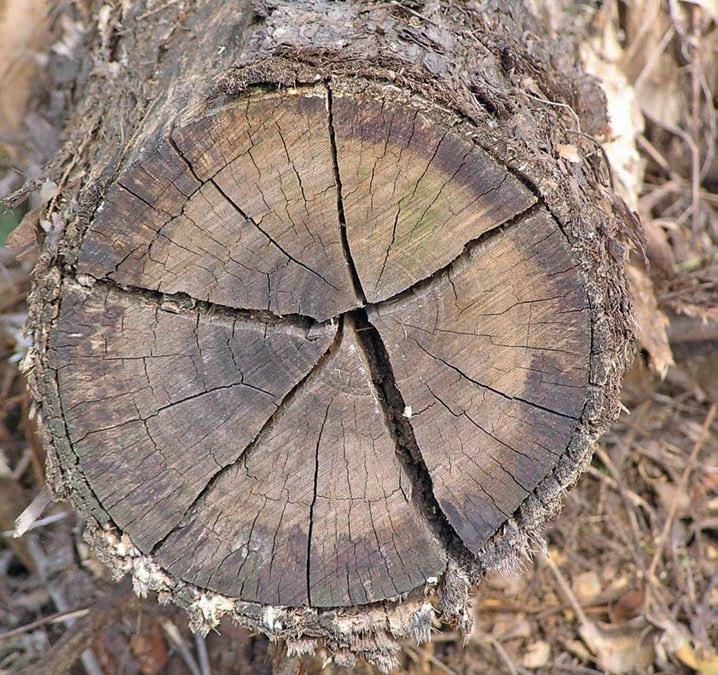
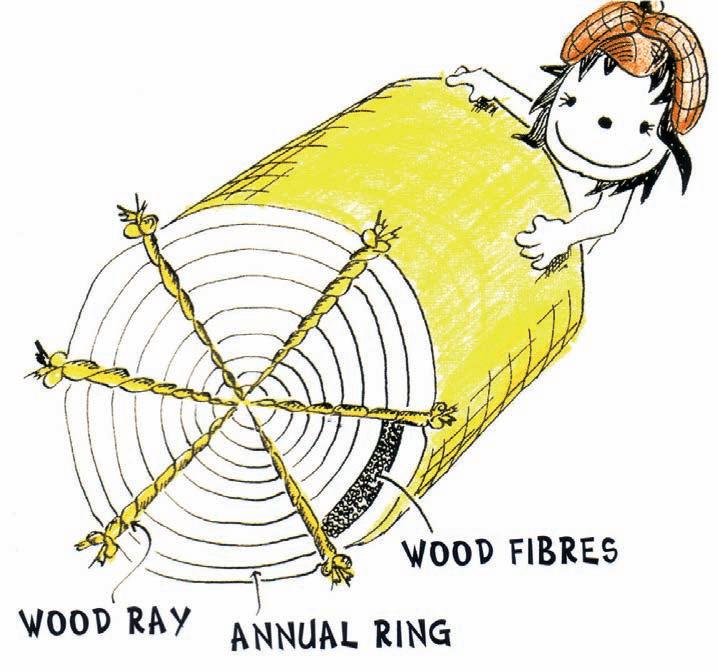
some cases growing lifebelts around their trunks to help fortify such load.
“This is akin to a human weightlifter sporting a thick leather belt when powerlifting.”
Gus returned back to the wood rays.
“I am aware, Major, that in a number of tree genera, particularly in the family Myrtaceae, that in the case of live wood delaminations or live splinters, the wood rays even have the capacity to act as pathways for callus or new wood tissue to form through them, forming boundary zones and wound-wood on the inside of the spilt timber, as well as primary wood on the outside. Such trunk delaminations with buds and shoots and incremental growth can even be transitioned into limbs.”
Fergus continued his drawing in the sand.
“The incremental integration of girdling roots into new, woody trunk and buttress growth in Myrtaceae is achieved in the same way.
“Plants are made up of multiple parts and processes where structure and biology are as one. Humanity underestimates the plant, let alone its woody counterpart. There is a vast intelligence in its design, a great knowing in its being.
In the same way I do not intimately know my own biomechanics, least of all on a cellular level, I do trust the intelligence within, which optimises me regardless of ‘my’ knowledge. This is the same intelligence that enables us to outmaneuver our enemy as combatants. The very same knowing I likewise trust as operating within the tree, Major. I believe it to be the same intelligence. It is God’s Intelligence.”
Looking straight into the Major’s eyes Fergus saw the understanding – the same self-aware knowledge of divinity. Holding Fergus’ gaze while raising his arm the Major said it all by saluting the lower-ranking officer.
“It’s a basic summary of the treesystem: with every cost this highly evolved harmoniser seeks to make a benefit. All it needs to do so is the vitality.”
“Ah, Fergus, and so we have a parallel to human psychology,” offered Churchill, “a mind-map as it were.”
“Consider your woody-plant cellular structure, those cojoined cells that form the pathways. Consider the loadbearing stress and, as you say, selfimposed stressors, up, down, side-toside and through.”
“Yes, Major,” replied Gus. “Extending into the root plate, transport roots, even to the root tips binding trees to the soil, with the mechanics and the biology of the root-ball, the ultimate counter ballast helping trees stand for up to thousands of years.”
Taking a breath himself Churchill continued, “The human egoicmind, the adapted self, is as compartmentalised as a tree. It is that which we create as children, as buffers, to cope with our loss to our link to divine intelligence. It’s our separation from that spiritual knowing, more the love of the ‘father’ and the ‘mother’ – or as the Christians call it, ‘Holy Spirit’. The tree, Fergus, is the perfect illustration of the form to the mental container that is the bane of humanity. All human suffering

translocates organic compounds in solution produced by photosynthesis in the leaves. This is used as energy around the whole body of the outermost tree and into the wood through the wood rays.


comes from that false sense of separation from God.”
It was then that Fergus got it, fuelled by the joy and the light in Jack’s eyes.
“And yet, Major, though the tree illustrates the structure to its form, the tree as the analogy of the humanegoic-mind, made up of multiple walls of cells to give the impression of the layers of a ‘self-imposed prison’, so too, is the ‘current’ tree dynamic.” Fergus paused to take another needed breath.
“As well as the now tree, the dynamic symplast, so too is the inert harder apoplast interlinked with the living all-encompassing heart/brain of the tree, throughout so much of its body are pathways. Pathways between the cell walls, the intercellular spaces, these enable and are symbolic of the pathway of spirit. The tree is likewise a reflection of the Trinity, the Father, the Holy Spirit, and the Christ. It’s in the gap that Christ’s light travels, the all-knowing pathway back to God, the pathway to ascension is within the container.”
He stopped again as he stabbed his drawing stick into the damp sand.
“Not only does the tree literally unite heaven and earth, both physically and spiritually, the tree embodies the perfect analogy of ascension!”
Stopping, both men breathed in the epiphany of their mutual understanding – as though they were actually women who’d been through a birth, less the pain – a birthing in consciousness. Silence descended to help magnify the gap between their thoughts and time.
Then Churchill piped up once more: “Fergus, consider the symbology of the cross, the framework of the tree that Christ was crucified on. Embracing the cross, owning our sin of separation, the mental and emotional dysfunction that goes with the false self, unique to us all, and then transcending it. Transcending human sufferance unto God, while becoming Christlike ourselves.
“Your narrative nails it for me. Yet again the tree features at the center of the ascendence story.”
At their point of mutual understanding, the dance of recognition, the expansion, with the tree at the heart of their discourse –suddenly a loud bellow came from the headland.
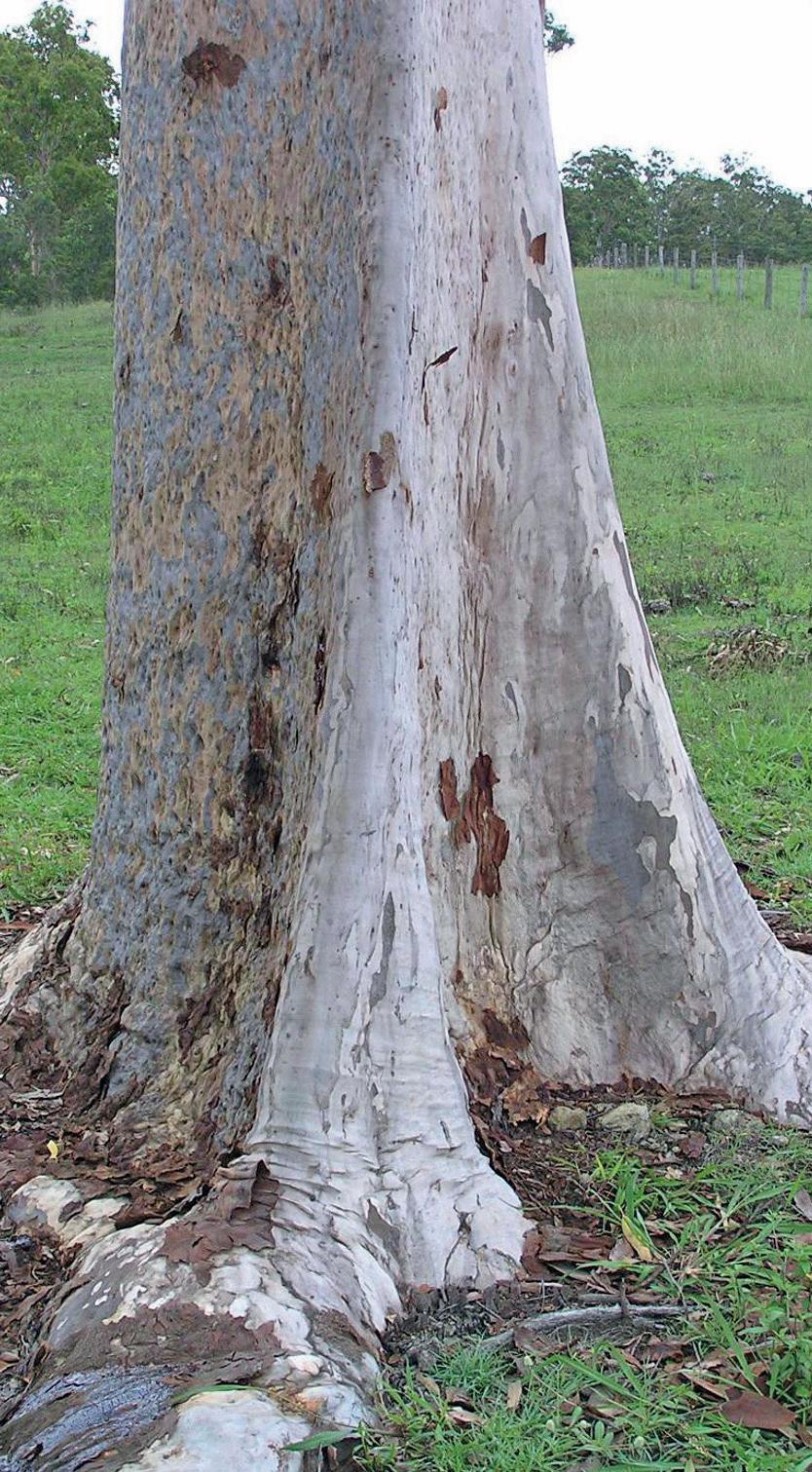
Trees grow spotwelds in areas subject to high compression, such as between buttresses or under heavy limbs, in some cases growing lifebelts around their trunks to help fortify such load.



VERMEER HAS BEEN AT THE FOREFRONT OF INNOVATIVE SAFETY AND PERFORMANCE FEATURES IN OUR TREE CARE RANGE FOR MORE THAN 60 YEARS. The BC2100XL is a standout in our wood chipper range. With a full function remote control, and offset horizontal feed roller, disposing of tree materials has never been safer. Plus, you’ll be backed by the service and support of Australia’s largest tree care equipment dealer network. Contact your local Vermeer Australia team to try it for yourself.

